Paintings and Plein Air Studies, 2011-2016
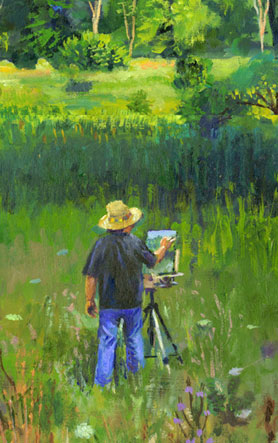
by Mark Koslow
Some of the material that has been on this site has been moved here: Click
Blog: Mark Koslow: Painting Thought Nature

This was called Painting Life in the Valley, referring
to Cuyahoga Valley, but it has gotten bigger than that and I have branched out.
So I am calling just..." Painting Life", as that pretty much says what I am
doing in the writing and pictures below.
The following are
oil paintings in a series, not all of them directly related, done in the order you see, beginning in September, 2011. You can find
a commentary on each work farther below, with
reflections on each painting and art and life in general, The best way to do
this might be to choose a picture you like and then read about it.....
So,
if you wish to read the chronicle from the beginning begin at the bottom of the
page. At the very bottom there is a short essay called "Observations
on Art". Skip up from that to begin with the first painting. If you wish to read
the latest works begin at the top......
Click on paintings to see larger images.
Cuyahoga National Park Series
|
September 2011 |
October |
November |
|||||||
|
December |
January 2012 |
February |
|||||||
|
March |
April |
May |
June |
||||||
-in-fa_small.jpg) |
|||||||||
|
July |
August |
September-October |
November |
Dec. 2012 |
|
||||
 |
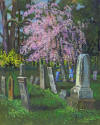 |
|
|||||||
|
Jan. 2013 |
February |
March |
April |
May |
June |
||||
 |
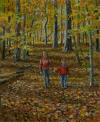 |
 |
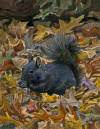 |
||||||
|
June |
August |
September |
October-November |
January 2014 |
February |
||||
|
|
|||||||||
 |
 |
||||||||
|
March |
April | May |
June 2014 |
june 2016 | |||||
|
|
|
|
|
|
|
|
|||
|
March |
April | May |
June 2014 |
june 2016 | |||||
|
|
|
|
|
|
|
||||
|
March |
April | May |
June 2014 |
june 2016 | |||||
|
Selected Recent Paintings and Drawings, (since June 2014) |
|||||||||
 |
 |
||||||||
|
july 2014 |
august 2014 |
oct 2014 |
2005-2014 |
sept. 2014 |
1999- dec.2014 |
jan. 2015 |
feb.2015 |
1998- feb. 2015 |
1999-Feb. 2015 |
|
|
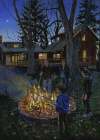 |
 |
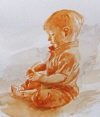 |
||||||
|
1998 -Feb 2015 |
apr. 2015 |
July 2015 |
aug. 2015 |
|
|
Oct. |
|
||
 |
 |
 |
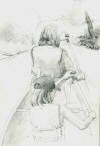 |
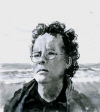 |
|
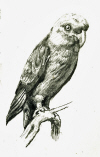 |
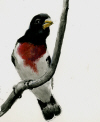 |
 |
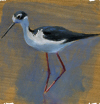 |
| Nov. 2015 | Jan. 2016 | ||||||||
 |
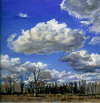 |
 |
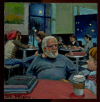 feb 2016 |
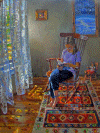 |
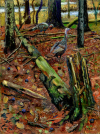 |
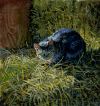 |
 June 2016 |
|
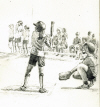 July |
 |
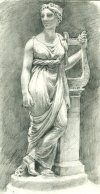 |
 |
2017  |
 |
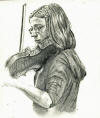 |
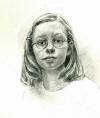 |
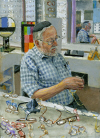 |
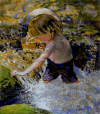 |
|
 |
|||||||||
|
|
|||||||||
|
******************************
Sidney Mount , the Power of Music see Doing Drawings at the Cleveland Museum of Art
see Violin Studies here: Blog: Mark Koslow: Painting Thought Nature see Babies and Kids Drawings and Paintings |
|||||||||
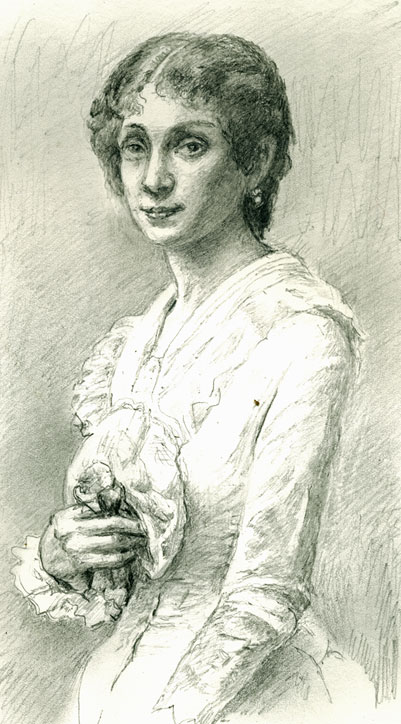
After Fantin Latour
see Doing Drawings at the Cleveland Museum of Art
here:
Blog: Mark Koslow: Painting Thought Nature
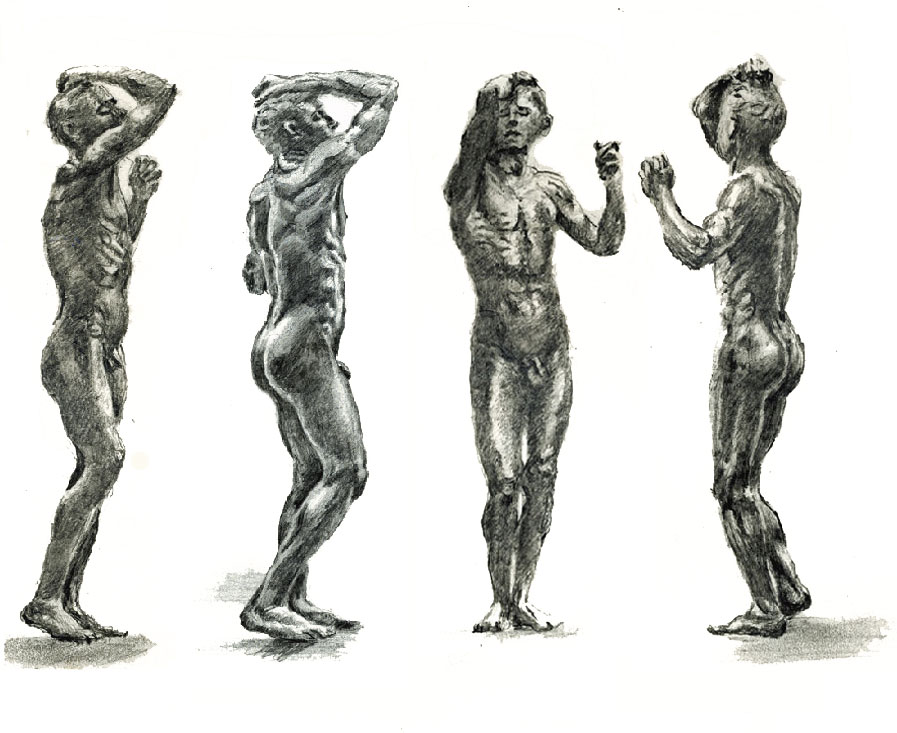
After Rodin. Age of Bronze
see Doing Drawings at the Cleveland Museum of Art
here:
Blog: Mark Koslow: Painting Thought Nature
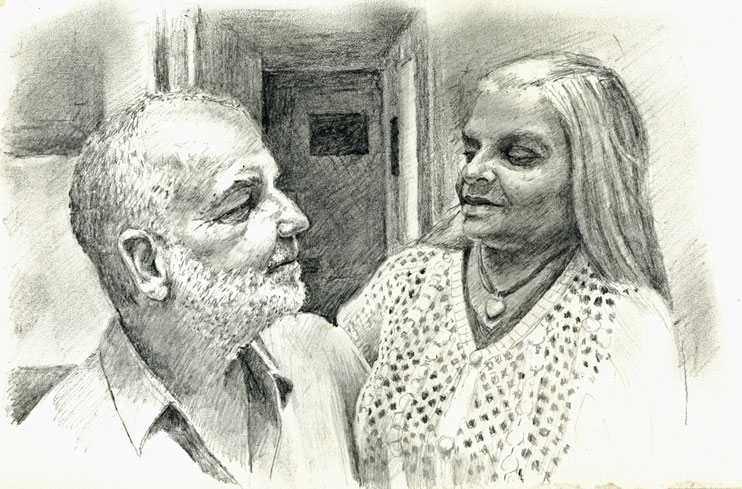
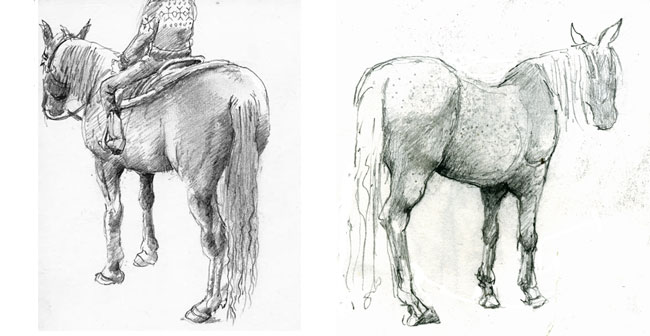
see Drawings Horses:
Here
Blog: Mark Koslow: Painting Thought Nature

Girl's baseball
for more baseball drawings see
Blog: Mark Koslow: Painting
Thought Nature
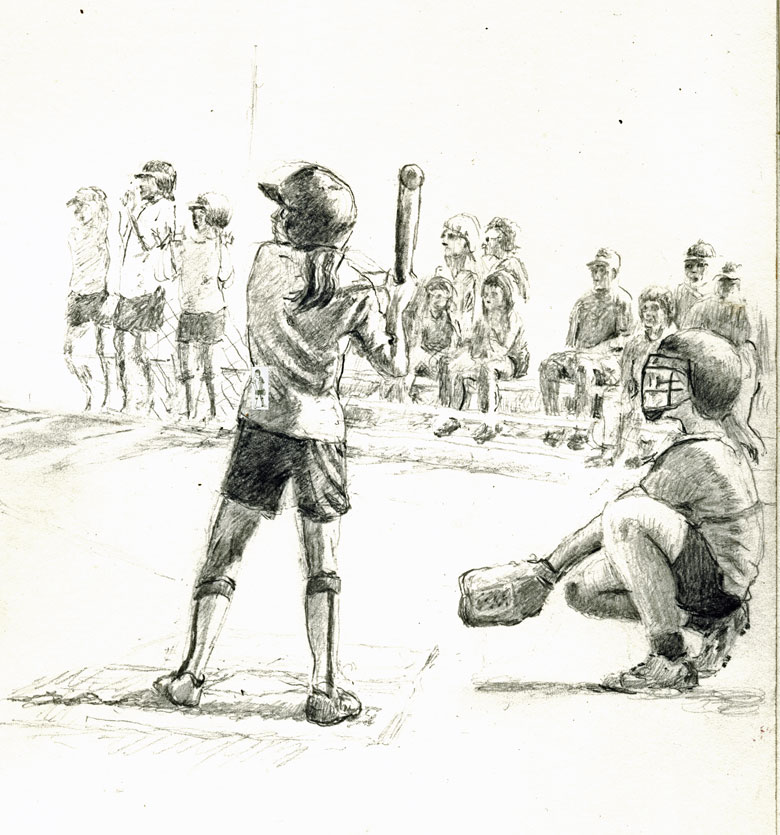
baseball, July 2016
for more baseball drawings see
Blog: Mark Koslow: Painting
Thought Nature
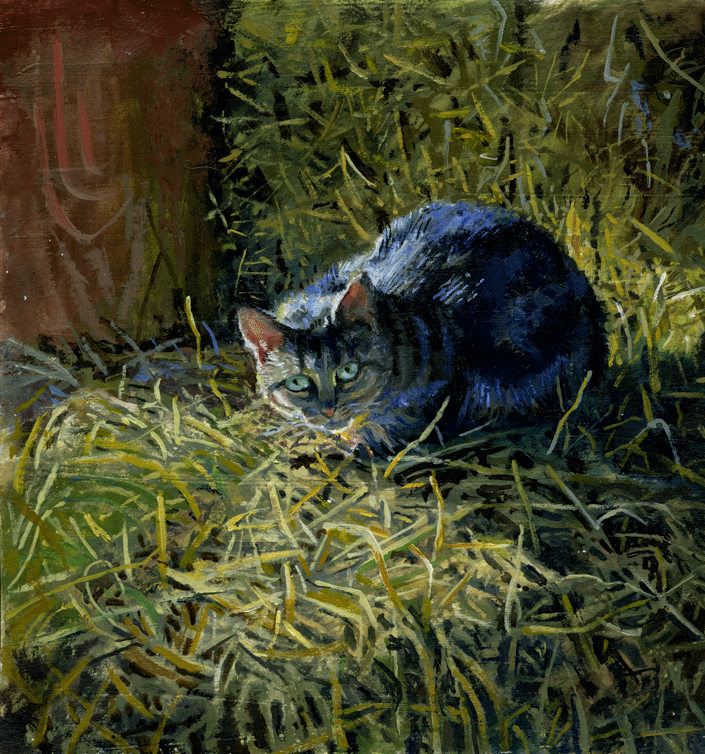
This is a Barn Cat that lives in the horse stables.
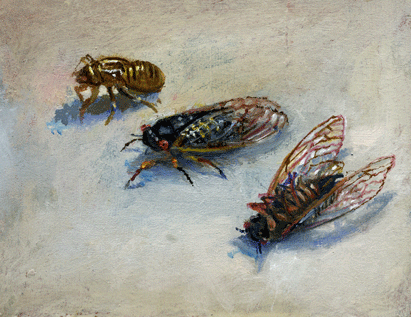
Periodic Cicadas, June, 2016.
These are two different stages of periodic cicadas, -- there
were billions of them here for the last 5 weeks or so. We
studied them a lot and learned much about them. The emerge
form the ground and crawl up on grass blades , trees, shrubs
and even junipers or pines. They emerge as whitish and then
gain their colors over some hours. Beautiful red eyes
and orange on wing vanes and legs. We had thousands flying
around our yard and millions were in the woods, in preferred
trees. I am not sure why the prefer certain trees over
others, but it may have to do with where they were born.
They spend 17 years eating sap from tree roots and appear to
stay locally around the trees where they were born. Dogs
like to eat them, as do raccoons, skunks and other mammals.
We saw various birds eating them too.
Amazing really, how evolution does these odd things. Their
numbers we so vast that birds and animals can only eat a
tiny fraction.
They lay their eggs at the ends of tree branches, many of
which are now dead only at the ends of the branches, In a
few weeks the larvae will emerge and fall to the ground to
emerge 17 years from now. They are beautiful too, though I
saw many adults cringe at them in horror. Kids get it and
play with them endlessly as they are quite harmless
|
****************************** March, 2016
I have enjoyed doing a
number group drawings of kids. I sat at baseball games drawing them,
at violin practice and concerts, playing tug or war, and at the
sledding hill during a birthday party celebration. I was not
sitting for as long at the latter, so I took some photos and
finished it from those. Drawing from life is always better, but if
it is not possible one has to move on and do what what can with a
basis from life. So the basics were all done on the spot.
Chinese Sumi Ink Work, Fall 2015 This last fall, 2015, I did
a series of experiments using Chinese ink. I have always admired its
velvet blacks and ability to suggest things, without entirely
explaining them. In contrast I also see why this is, as it
does not have the precision of pencil or oil. Yet at the same time,
some accurate precision is certainly possible. Cleveland has one of the
best collections of Sumi Ink paintings in the world, though
the current administration at this institution tends to underplay
their collection. I enjoyed doing this but found that this ink is a
very subtle medium in some ways, but also very hard to control.
for more on this subject see
Pencil Drawings, 2015
In the last year I have done allot of drawing. Why did I shift more to drawing? Partly I wished go back to my roots. My roots are in drawing. I started painting early but was not really happy with anything till I was eighteen years old. Drawing started when I was 14, and I was pleased with many things. Drawing is faster and yet still retains the facticity of Plein air study. Doing Plein air of my kids baseball games would be very difficult, but doing drawings of them playing is both interesting and fun. Drawing is an underestimated art. It is much easier and less interesting to take a photo, certainly. Drawings really do matter, more and more as time goes by. Hardly anyone can teach drawing, and there are fewer and fewer who know how to do this well all the time. I love drawings and doubt it will ever be really superseded as a useful and wide ranging skill. Drawing is habit that is hard to learn and those who do it well are rare anomalies that prove the rule that it is better done by hand. I suspect they will have computers drawing well one day, and they will still not have what a good hand done drawing can do. There is life in the fingers and in the mind that simply cannot be replaced by any machine. If one looks at Wyeth's drawings or Leonardo they simply does not compare to photographs, as there is a mind a hand and real art in them. The both cold draw well form memory too, I can do that somewhat, but not as well as they as yet. Lecoq de Boisbaudran taught this to Fantin Latour and others in the 1800’s. I have studied
drawing allot in recent years and there is indeed
life in the fingers and in the mind that can not be imitated by
machine. I have been fascinated by groups of people, especially as you can see below. The baseball team, the young musicians playing together, the Tug of War by played by kids, kids ice skating. As great as Sandy Koufax or Willie Mays might have been at baseball, my favorite teams are little kids playing the game. I especially like games played for fun, rather than merely to win. Drawing is inquiry into life and an effort to study reality close-up and first hand, so this year, I have studied the extinct Carolina Parakeet as it looked in Ohio before it was killed off in the early 1900's. I did a drawing of us rowing down the Grand River one day during the summer. I also like to draw in museums, as it is a quiet form of study and one where I can share in the insights of other artists. Cleveland has an amazing collection and nearly ever piece is great of its kind, even if not well known. So I did the Tilman Reimenschneider three times. It shows a man helping an animal and I just love the gentleness and sad compassion in his face. the old woman by Frederick Sandy's is oeo of his best works. He captures the woman almost as if she were still alive and with us now. His other works are good but a bit dreamy or symblist, but this one is a real person and not a symbol.
|
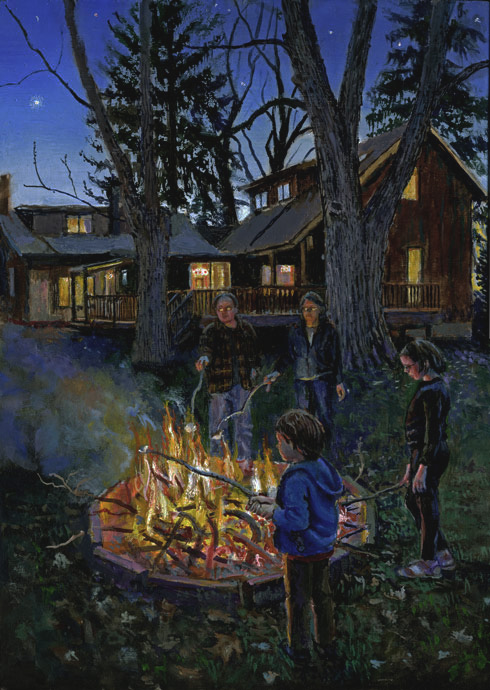
Fire, light and our House.
June, 2015.
We have a lot of trees, some of them very
old, and they lose branches. So, we burn twigs and
small branches, once or twice a year . We make a time of it
roasting marshmallows and eating them. We add the often
charred or browned marshmallow twith a square of dark or
milk chocolate put between crackers. It was a complex work
to do and took quite a while. I had to sue photos for
the figures. But the rest is form life.
I was thinking this one for several years., but nearly so.
Not sure what to call it, so for now it is just Firelight.
That is our house in the background. I started with that by
drawing it from life. There are some mistakes in the
structure, but it is more or less right. The structure on
the right is the family room/studio and bed room we built
based on our own design. We built a lot of it ourselves,
though for the main structure I hired two very good
carpenters. I could not have gotten the main beam or framing
up by myself. I also needed help on the drywall, electric
and insulation.. But I did a lot the cutting and the design
of it and it was quite interesting and a real challenge. But
the painting itself is mostly an effort to celebrate
our family again. Sorry if this is my favorite thing to do,
but actually it is hard to figure out if there is much more
in life than this that matters, unless it be animal and bird
families as well as ecologies.
******************************
Violin Studies 2013-2016
I've done various studies of violinists and children playing violin in the last two or three years. Only one painting so far, but there may be more. It is a genre I like very and there are examples of it that go back to the 16th century, at least. My main concern was my children, who play this instrument. Here they are in chronological order with the most recent first. The short essay that accompanies these works is here:
https://markkoslowspaintingsthoughtandnature.wordpress.com/2016/02/16/violin-studies-2013-2015/
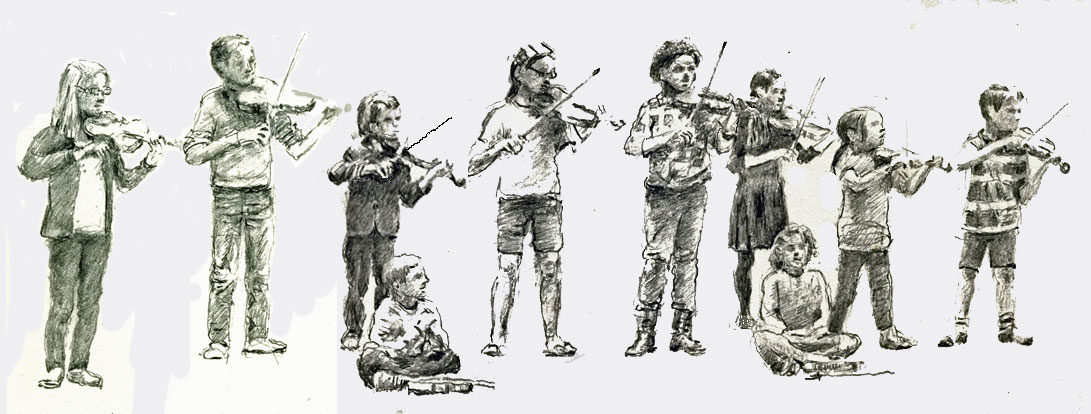
young violinists 2015-2016
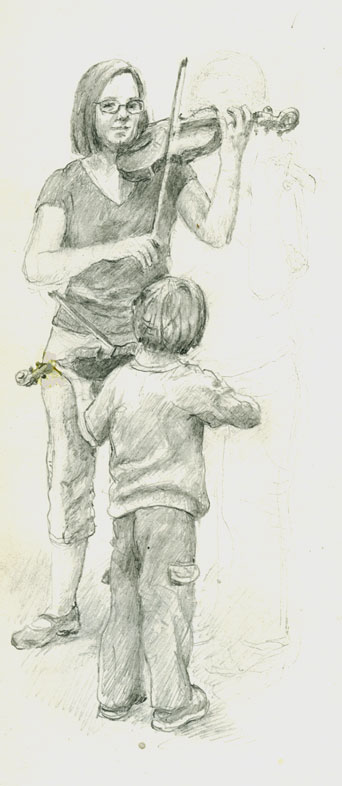
April -June 2015
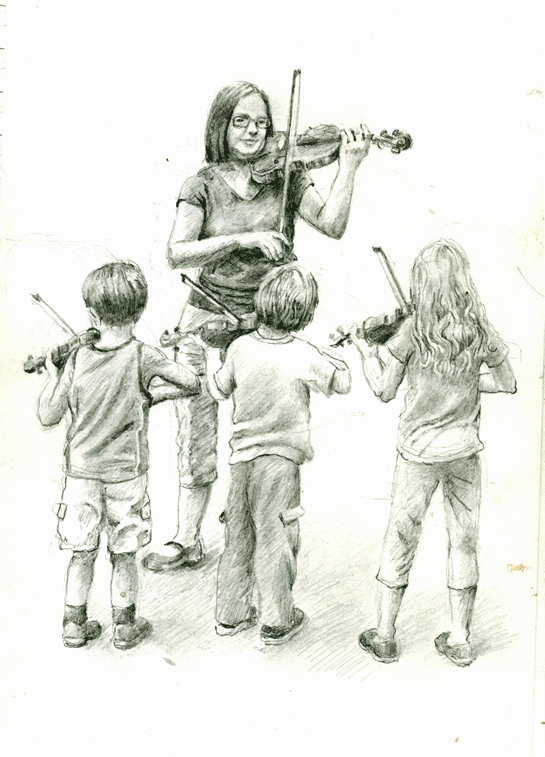
Suzuki Method, Aug 2015j
The two drawings above
were done over several months. in pieces. Some of them were
done from life and other parts had to be done from photos.
Drawings of this kind take a lot of time. I can draw things
over a period of time, waiting for the subject to get in the
right pose and then working partly form refreshed memory.
But I cannot work only from memory. There was a teacher in
the 1900's who taught working from memory alone. But that is
an exacting skill that requires lots of practice and but I
am not that good at it yet. So some of these figures had to be
done from photos.
I love the way the Suzuki method works and
how the teacher teachers the young ones, and so these are
about the relation of teacher and student and how musical
knowledge is passed on. It is direct
learning, without initially reading music, and involves 'one on one'
teaching as well as teaching in groups. It is an enormously
effective way of learning and one that the test obsessed
U.S. system of education could learn a lot from. Kids do not
learn form tests as much as they learn form direct learning.
Learn by doing John Dewey said, and he was right.
The first drawing of my son and his teacher was done mostly
from life, though the teacher moves much more than her
student, so I relied on photos to help. I erased what I did
many times and started over. The
portrait of my
son has a lot of character in it, and so I used it more than
once. I wanted to show the group class too and had to use
more photos for that. I wanted to do the kids from behind as
that is what I usually see at these lessons, the parents
being an important part of the Suzuki method. The kids are
thus sandwiched between parents and teacher. This works
extremely well and we are very pleased with the results. The
practice that they kids do at home solidifies everything the
teacher is teaching. Because we are present at the lessons,
we can supervise their practice in way that would be
impossible were we kept out of the lesson. It was brilliant
that Suzuki realized this.
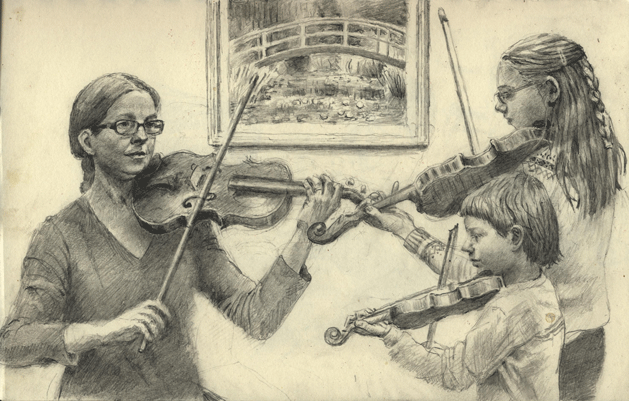
Teaching Violin (April 2015) graphite
Here I I show music as shared between a teacher and the
young and by a brother and a sister. I was not copying
Johnson, Forbes or Bouveret. ( see below) But like them I find deep
sympathy in this instrument. I try to show how deep and resonant a simple
theme like shared music can be.
It has been a great joy to see my children learn to play and be part of the long heritage of
music, now part of our family. "Teaching Violin" is the best
of what I have been able to do so far. This is largely
because my kid's teacher is so good and does so much to
communicate all the history and feeling that is in the
violin repertoire. She runs the Suzuki program here, which
is a marvelous program developed in Japan to help children
learn to play. I use the Monet painting on the wall in
"Teaching Violin" to suggest how the passage of knowledge
goes from the teacher to the students, as if over a bridge
above water lilies, the music like shinning flowers in a
bright sunshine.
.jpg)
Violin Class (Sept. 2014)
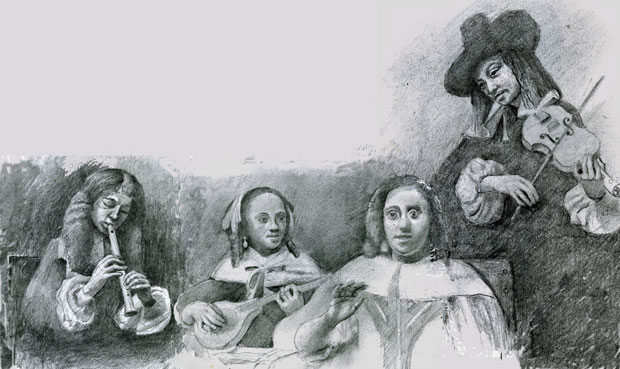
I did various sketches, stitched together after
Pieter De Hooch, 2013
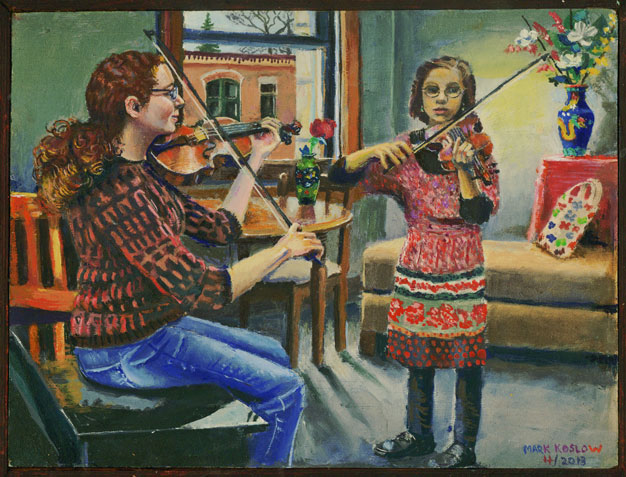
Learning Violin. oil, 2013
\
*****************
********
____________________________________________________________________________________________________________
Sept, 2014
History

History
This is another work I have had in mind for along time. This one took much longer than I usually take on one work. It is also a slightly larger surface than I have been working on in the last few years. I've been doing smaller works because it is easier to work smaller outside, en plein air. Also oil paints pose certain difficulties, compared to acrylics, and I have been interested in using oil for detailed work, which takes much longer if one works larger. Lately I have done some research on the history of oil paint, and admire the manner of Van Eyck, using a walnut oil and a pine resin as a medium. James Groves helped me with this concoction and it gets some interesting results: very smooth, buttery velvet and glossy and good for detail work. This painting was a kind of summation of various domestic or family studies I have done of my family over the last several years. They have a certain aesthetic logic to them, as should be visible to a discerning viewer. I will explain why shortly.
But as to the painting above, it shows my daughter, son and I in the
studio, with me painting them in a mirror. On the wall are various
portraits of the ancestors of my kids on my mother's side. There is also
a picture of including my wife and daughter. Some of these are
trying out compositional ideas, meaning they do not exist as paintings
yet. Rather they are miniatures and I have been thinking to do paintings
of them. These miniature portraits took quite awhile.
Behind my head are my mother, my mother's mother, ( below) based on the
watercolor miniature in the MET and my wife and our daughter together.
Above them are my daughter as a baby at the ocean in California, the
redbirds which you can see below and a nest, perhaps a Redstart Warbler
nest and a Robin's egg. On the opposite side of the window are my son
and a version of Da Vinci's great anatomy drawings. This is
perhaps one of the best anatomy drawings ever done, of which mine is a
very pale copy, from his great 1508 anatomy notebook in the Windsor
collection. This last was especially difficult. I did that over at least
4 or 5 times, and I am still not happy with it. It is a fairly large
drawing for Leonardo and my copy is only two inches tall. I don’t mean
to complain, but I was up against my own limitations to try to reduce
such a complex and exact drawing to a small size. doing this was
interesting and difficult.
I am calling the painting
"History". It might be called ‘actual history’. I am not sure yet. This
title is partly a reference to to all these recent works which explore
my own versions of history painting in a very personal way. When I read
history I am often struck by the irrelevance of official histories of
great men compared to the interesting facts of actual history of real
people who might not have done the heroic deeds, had great power or
known the ultra rich. I like Social History and am not a big fan of
military and great man histories. What was called "History painting" 2
or 3 hundred years ago was really not paintings of actual history, but
largely mythology paintings that had the glorification of rulers or
biblical fictions as their object. I rejected such nonsense years ago.
The point was to magnify their subjects and make them idealized models
for correct behavior. Icon making or myth painting of these kinds
does not interest me at all. So when I say this painting is actual
history, it is just that, quite literally, not myth, and not the
"History painting" that was considered the highest calling between
Rembrandt and the French Realists of 1850. It is pictures of real
people in real settings. I am interested in actual people and things and
not fictions and many of my works have that element in them.
What does interest me is the history
painting started by the Dutch, which initiated a real rebellion against
the history painting of the Italians and French in that it ceased
recording biblical or monarchist propaganda and started painting
realistic portraits of real ordinary people. This was an art of the
poor, and one can see it in Vincent's early work, as well as in his
friend Anthon Van Rappard. The Black Plague probably had an influence on
the rise of a secular mentality in that it brought the feudal system
into question and taught a certain disrespect for authority essential to
later science. Workers had more power after the Plague of 1350, and
lords and monarchs ceased to have total control. The Church was brought
into question. The change is noticeable in European art after 1400 and
increases until 1500, Van Eyck being an early and exceptional realist,
whose influence extends all the way to Italy. He appears to have
influenced Leonardo to some degree, indirectly. Leonardo's experiments
with oil paint were partly an effort to paint like Van Eyck. The French
Realists continued this.
I am reading a good art
history now, William Gerdts’ Art Across America, which shows
lesser known artists—many of them women or ‘minor’ artists kept out of
official histories. Much of their work is far better than what is
paraded as characteristic of 19th and 20th century
art. Gerdts’ books are far better than Janson’ s Art History or
other standard art histories, which show the 'great' luminaries, which
is fine up till about 1800. But by 1900 art history becomes something
false and largely a creation of a fictional art world run by critics and
gallery owners, promoting artists of little skill or insight. Many of
the standard artist history heroes in modern art turn out to be
something of a joke. Or rather they are a joke to me, to others they are
standard upper class and corporate history with a few token "outsider"
artists thrown in the assuage the guilt of turning art into an empty
branch of upper class fashion. What Gerdt's history shows is that art is
not at all what New York or Tokyo galleries says it is. It is much
more local and practiced by many women, men and people of
color. R.B.Kitaj was right to rebel against the critics and write his
own explanations for his paintings. I was not inspired by him to do
this, but note his perspicacity in rejecting the palaver of art critics.
Joni Mitchel's refusal to have anything to do with the art word is even
more accurate.g
So my title "history" is not standard history at all, but, what I would call real history, unadorned by myth and fictions. I show my grandma Edna, Mom, my wife and the kids. I used Julia Kahle’s 1920 miniature of my Grandma which is in the MET in NYC as a model for her. I took out the white fox fur, which I have never liked. It is true my grandma had stuff like that. But I would prefer not to look at it. Someday I hope to do a larger one, as painting this small is problematical.
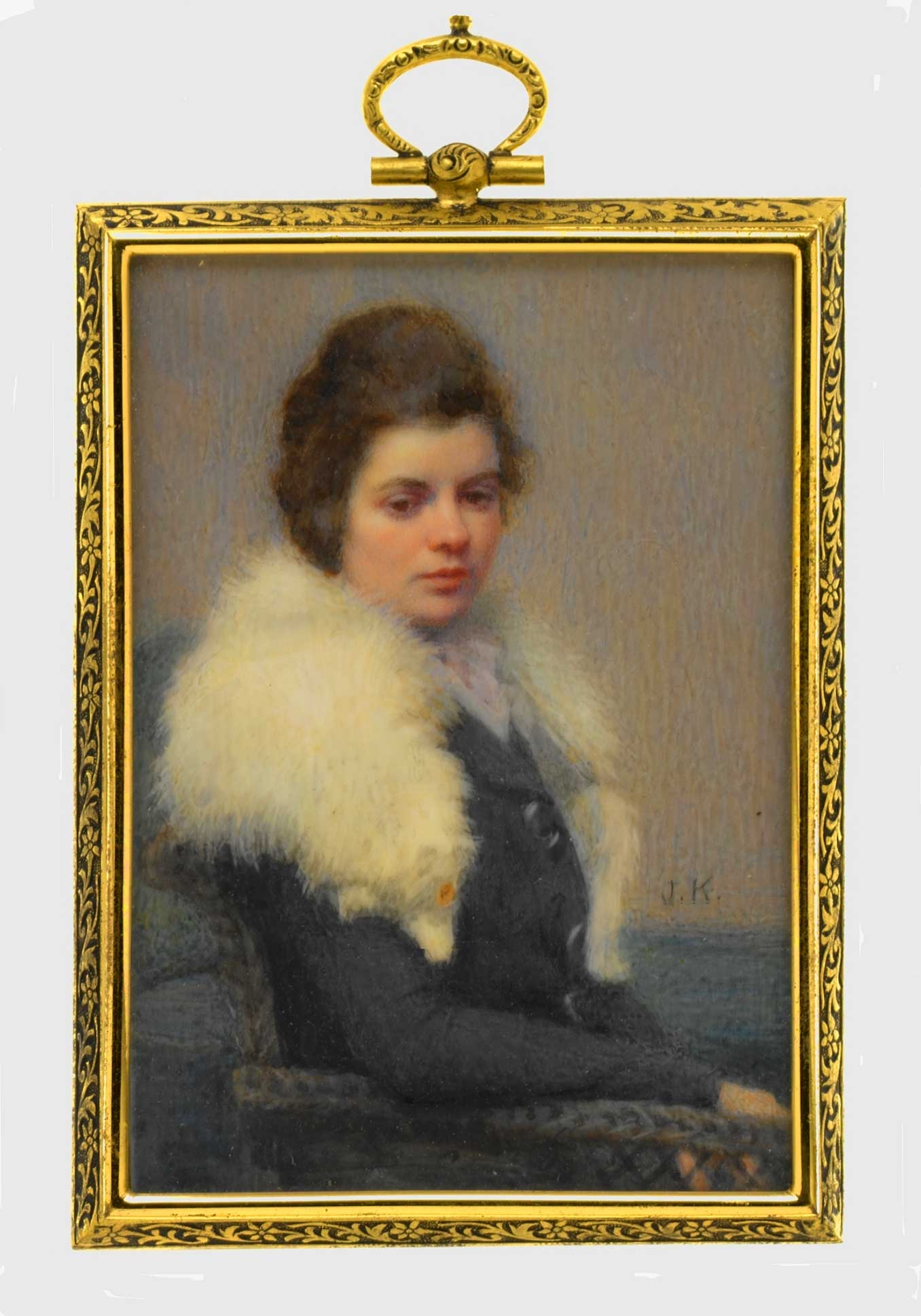
My Grandmother, miniature
Metropolitan museum of Art
In my painting, My mom is shown reading a book. .I show myself as a painter and a full time Dad. Gauguin abandoned his kids, one fact among others, I have always disliked about him. I embrace my kids and ahve been a full time dad for nearly a decade now.
Out the window,. one can see a few of the characters who live on our deck. there is a Red Squirrel and a Hummingbird there, and some Salvia flowers overgrown this year. And the toy animals were fun to do. I started thinking that Bison might be real and actually run around my studio as if it were a great Prairie. I guess I have been influenced by my kids love of small people, “borrowers” and leprechauns. They imagine such things often. It was interesting to paint my son's body, hands feet and face. He still has the last of his baby like characteristic which will be gone in a year or two, so I wanted to capture something of that. My daughter is the center of the picture, with her hand made Tie-dye shirt that was so well done. My son is the most forward part of it. I did myself entirely from life, overweight, balding, but still thinking and smiling. Since we home school the kids this is not an inaccurate picture of our normal days. The kids and I spend a lot of time together doing projects and studying. I did the portrait of myself blow on the ship at 18 below and wanted to do one how I look now. Hardly the same person on the outside.
The original drawing for this painting was done entirely from life. Most of this painting was done from life, though with my son only the original drawing was done form life, he is too young to pose. J. E. Millais was able to make kids pose for him, but I can't do it for long. Young kids do not have the concentration to sit for along time and it is cruel to pose them by force. I painted my legs, arms, and head paint from life, Incorrect drawings always cause troubles later on so I did this one with a certain linear exactitude. I blocked in the main poses before I started to paint.
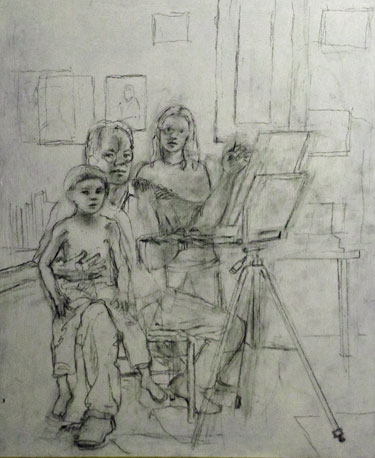
Shadows do not matter in an under drawing, but lines do, and in this Ingres was right. I've been studying Ingres' drawings of late and am amazed by them. I doubt they were done with Camera Lucida as Hockney has clamed. Ingres' drawings themselves are amazing examples of perfect use of pencils, weight of line, pressure, and subtle shading. Only Leonardo can draw better. An American Scientist review of Hockney's book states that
Gary Tinterow, a senior curator at the Metropolitan Museum and an Ingres scholar, confessed to an ambivalence about Hockney's claims. Tinterow noted that Ingres's father was also a painter and a miniaturist. Tinterow ended on a plaintive note: "It would be nice if we could find an account from one of Ingres's sitters—and there are many who left such accounts, who mention his easels and brushes and canvases—a sitter who described Ingres's use of such optical devices." (March 2002)
But since there is no such evidence, it appears that Ingres was drawing freehand and the distortion in his work appear to be the result of choices he made, and not optical devices, which Hockney wrongly contends. If one compares Ingres' original drawings with paintings he did from them it shows that his will to distort is very strong. If one compares his painting of Madame d'Haussonville with the drawing below, for instance, this is obvious. He was twisted and exaggerated her hips, thrust her head forward an made a sort of arabesque out of her upper body which is unlikely and perhaps not even physically possible. The drawing is more true to life, and reasonable. Hockney tries to say that some of these weird distortions are due to the Camera Lucida that Ingres is supposed to have used, but the evidence suggests otherwise.
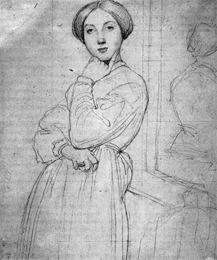
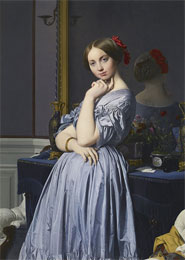
Ingres is distorting in line
with some of the oriental love of arabesque forms. Even if you
imagines her to be pregnant, which is likely as she did have a baby
around this time. Ingres has still distorted rather strangely, as he
often does.
In any case, my drawing of
me and the kids had the purpose of showing my children and myself rather
as we are instead or conforming to some inner, orientalizing compulsion. Kids
are closer to nature in a certain way, -- like nature, they are amoral
as young children. There are less deformed by civilization. This does
not mean that they do not need education. They do. Culture is learned.
The question is what kind of culture they learn. Most of their education
comes form my wife and I, as we homeschool, and our concerns with
science and nature and important to their education. Painting them as
children is a major part of what I have been doing these last years.
Putting them in the context of my owns studies and concerns is thus
quite natural, and I work with them daily, trying to teach them, much of
what I know.
I had done a self portrait a few
years previously. Seeming more pretentious, it is really a humble work
that shows me still learning, even though I am older now. The
perspective in it is odd, as the bookcase near the candle is much closer
to the viewer. This is because we are looking down a stair to another
room, which is farther away than the more proximate shelves. I put books
in it that are subjects that of interest to me, Oceans, plants, nature
and science, as well as art of course. I've been writing a book for 20
years, which turned into three books and that is soon to be done. This
painting is about the endless research I did for that, as well as other
things. The blue book was a book on Monet, but I did not put his name on
it, as I like Monet, but he is not as important to me as other artists.
I have always loved books, a good habit I got form my mother and my own
obsessions and concerns. My hair has gotten whiter in the last few
years, I see. Time stops for no man.
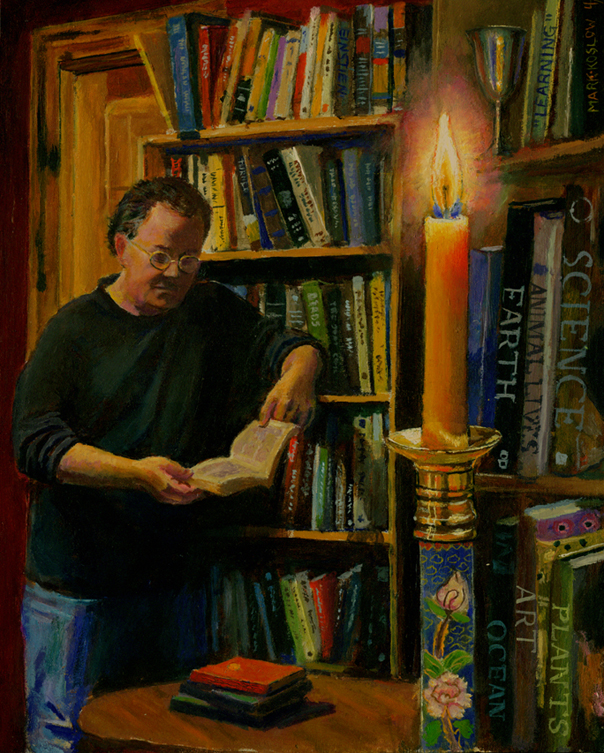
Still Learning
"History" is a sort of family portrait., since there is a portrait of my wife and our daughter also from a few years ago. In the History painting, I also did a portrait of my wife is on a beach with my daughter in California when she was almost two and chilly, so she is buried under her red hood. I've done various portraits of my daughter in recent years.
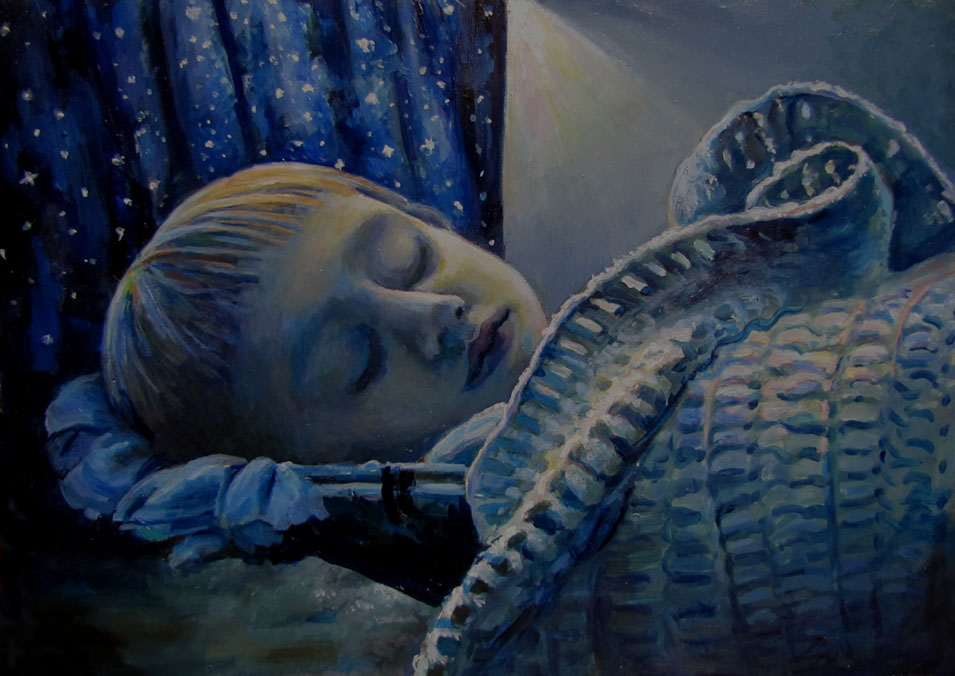
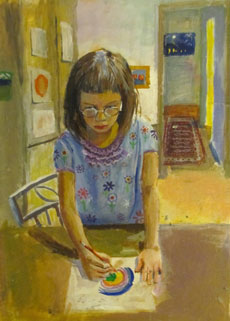
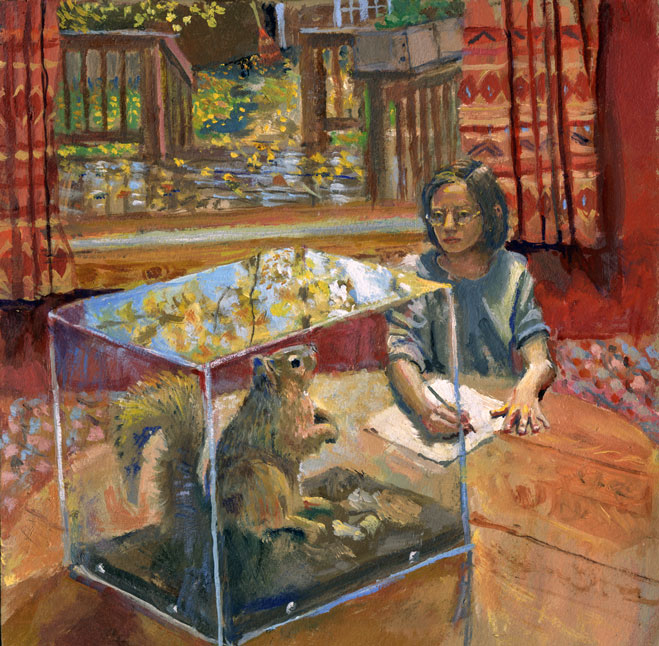
I had done a portrait of my spouse and our son a few years ago too. He was just two then.
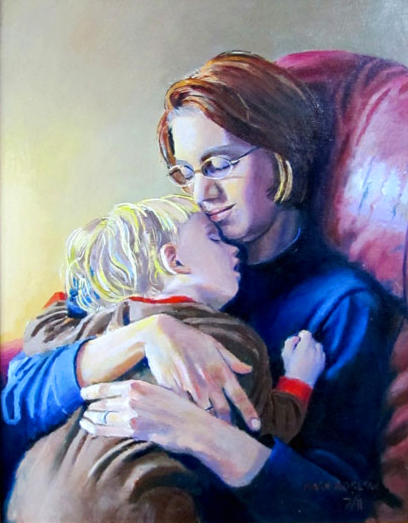
For the painting called "History", I had to use photos for my son. even though I drew him form life in the inttial drawing. But he is five now and too busy to pose. Here are two portraits of him, also done in the last several years. In the one on the left there is a portrait of our cat, Paws, who was sick then. He died over a year ago and we buried him i the backyard. The one on the right shows my son almost out of diapers, with a painting on the wall of one of his last bottles of breast milk I did a year earlier. These milestones do not mean much to others, but they were important to me as I cared form these kids everyday and this is what life is really about. While the activities of adults are interesting, life is not really lived until one has children. They are the real meaning of life. Animals think so too, if one spends any time studying nature, this is the first thing one learns. Many who never had children, even among animals, and we are animals too, get to be aunts or uncles or teachers. And so history goes on, and we are all part of it.
A drawing by my daughter is on the refrigerator of her exulting under the rainbow. In the painting on the left, on the kitchen cabinet, is a picture my daughter and I made of her traced hand reaching like a rainbow up to the stars. The second is a picture my son and I made reaching for my hand . On the all in the back is a painting I did when he was two or so. I fed him human milk from a bottle everyday and was going to miss it when he stopped. Soon about that time he stopped and as expected I dearly missed doing it. Just as the day came when he stopped using that high chair I had refinished for him. Life goes by and the things that really matter pass away. But I hve preserved a few of these special things in paint.
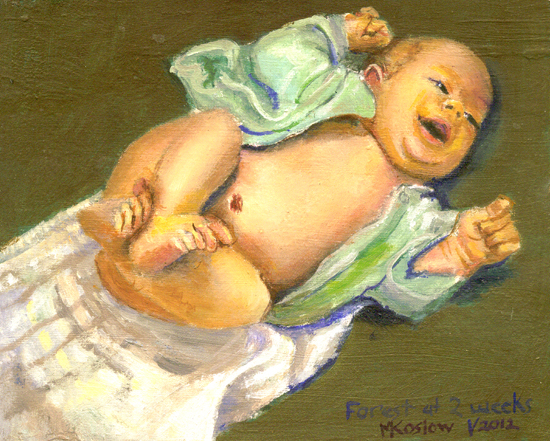
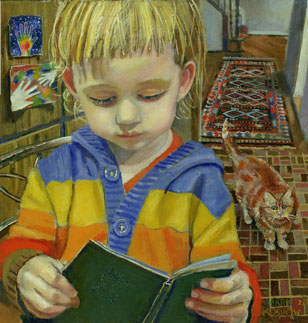
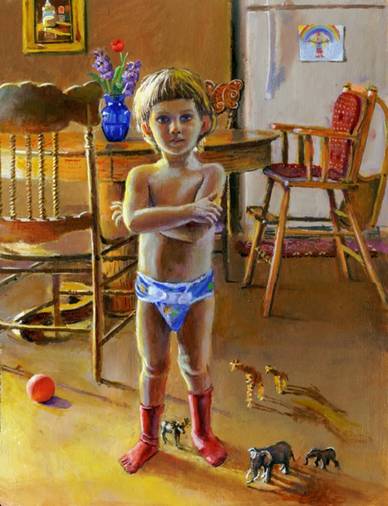
More can be found on self portraits here:
https://markkoslowspaintingsthoughtandnature.wordpress.com/2016/02/16/selected-self-portraits-since-1971/
*****
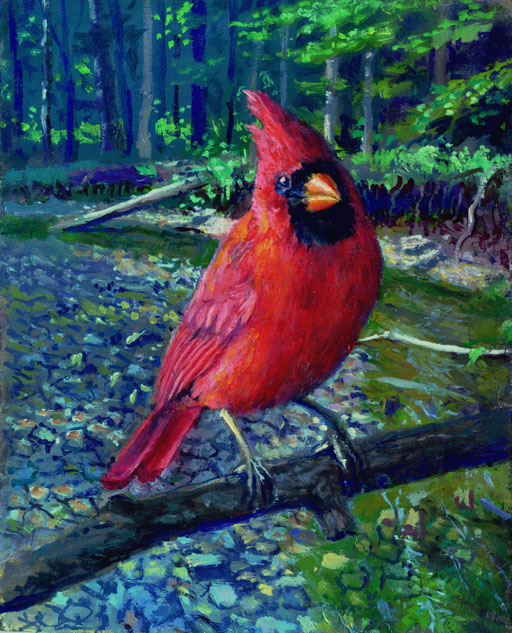
This Redbird, or Cardinal as some call it, was an odyssey. I did three versions of it, one over the other, as fllows
Early May-. I did this for fun today (painting on the left) because my daughter has been studying birds and I have been helping her. We have been going around looking at them. In the last few days she saw a Yellow Rumped Warbler, , Flicker, Swans, Great White Egret, Bald Eagle, Ruddy Ducks, Scaup and many others. We borrowed a taxidermized Cardinal form the natural History museum, and she and I both did a portrait of it. The exhibit is rather desiccated so I had to rely somewhat on memory to make it look alive. Then I did something I do not usually do. I invented a background. A friend in Toronto, Barry Kent MacKay does this all the time for his marvelous paintings of birds, so I decided to imagine a background like like he does. I did a vague creek below and a bankside and found myself remembering back to about 1999, when I was out for a walk with my mother and we saw a red bird above a creek like this. It was spring, as it is now and the light had that marvelous. crystalline quality it sometimes gets when the air is clear and a little cold. I am not sure that I captured that exactly. The bird needs some more work, but it is hard to make it natural looking as these old stuffed birds are rather desiccated. I need another approach.
July. I was not happy with he original version of this one the left, which I did in May. I took a picture of Columbia Run creek in the right light, and decided to use that as a background. I studied the redbird near our house, who I have been feeding for years now. His name is Baldy, as his head is some years free of feathers do to a mite he gets. I tried to paint what I saw from memory. I took a photo of a place I know that I thought would work as a background and adapted that to the image, which is mostly about light on the bird.
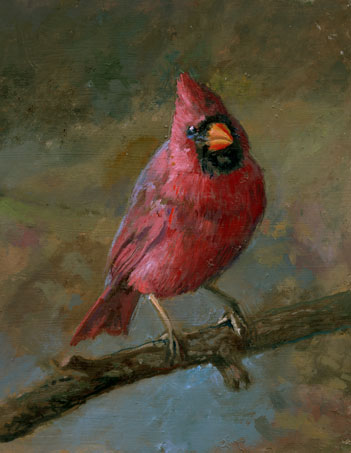
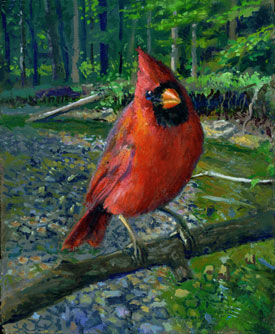

August September. I was still not happy with this painting after the second version, though I liked the background. My friend in Toronto, Barry Kent MacKay, offered to help and gave me a sort of tutorial on the anatomy of birds wings. I like anatomy and know a bit about human anatomy, but had not studied bird anatomy, though I had wanted to. Barry made it much easier to learn. I did not understand the feathers and bones how the primaries, secondaries, alula and coverts all worked together to help the bird fly. i studied this for weeks and did some drawings at the natural history museum, trying to learn the structure of birds wings that Barry had taught me. It is not enough to simply learn the anatomy by diagrams and words. One has to see it on real birds. I studied birds at the zoo in Akron too. I finally applied what I learned to this small painting. It is still not quite right in all respects. I am sure the tail is wrong in various ways and the feet are certainly not quite right. I did those from desiccated feet and real birds foot is more supple and precise. But I love to pursue such inquires and I am sure there will be more studies in this area yet.
*********************************
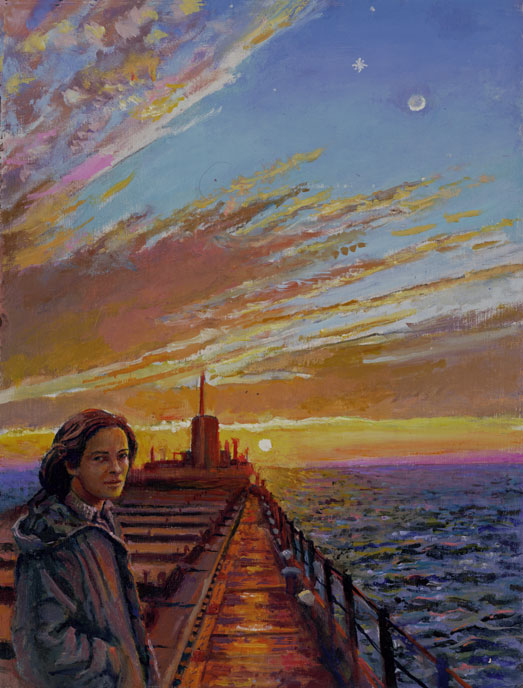
At 17 on the Great Lakes
This second picture of the sea is one I have wanted
to do for many years, decades actually.
But this picture requires some explaining. My Dad died
when I was 17, and six months later, I finished high school. It was a
time of solitude and grief and caring for my very bereaved mother, I
needed a job that would help me go to college. With my Dad dead, money
was short. I got on the Ore Ships that carry Iron Ore on the Great
Lakes. My Dad had been in the steel business and my Mom helped me get
the job though connections that he had. The trip up and down to Lake
Superior usually took 7 days up and 7 days back, weather permitting. So
every 14 days I got a few days off and returned home to try to care for
my grieving mother.
The ship I was on was the William P Snyder, Jr. of the Cleveland Cliffs
line. My bother took me to drop me off at the Ship in Lorain Ohio.
I got seasick the first trip. After that I was fine. We went west on
Lake Erie up past Detroit and up across Lake Sinclair, the 6th great
Lake which is never mentioned as one but should be. It is incredibly
gorgeous some days, ringed round with rushes and cattails and glowing
like a great mirror or the sky. We headed out across Lake Huron up St
Mary's River to the Sault Ste, Marie Locks, which we passed through
slowly. Then out to Whitefish Bay on Lake Superior, and then up past
Isle Royale to Duluth or Silver Bay to pick up Iron Ore for the steel
mills. We also went to Marquette, Michigan and Buffalo New York at the
other end of Lake Erie. My job was to be a "wiper" in the engine room
and I painted the walls of it, day after day. Some days I got to clean
out filters, carry cement bags, and other useful tasks, on and off deck.
I particularly liked mopping up the decks of the engine room, which I
did nearly everyday, as I washed my mop in the Lakes and held it out the
cargo door to the engine room and dangled it in the waves. I was close
to the sea and watched the waves with fascination. Sometimes the waves
on Lake Superior got up to 30 feet and during break I would head up to
the smoke stack deck and watch the boat as it met these huge waves. I
could see down the length of the ship toward the pilot house and could
see the ship bending under the pressure of each huge wave, like a toy or
a roller coaster. I could hear the creaking of the ship and see it
bend and contract as each wave went under the ship. We were like a cork
in the immensity and it was amazing to see myself so small and the
universe so large. Coming into port was always an adventure. Everyone
called me "Junior" as I was by far the youngest on the ship, and treated
me kindly.
As it was summer and fall when I was on the ships, there were storms in the fall, and more than once we had to anchor in a Bay or cove and ride it out. Once we were on Whitefish Bay for a few days during a bad storm. When it was done a fog came and in the morning we could not see more than a few feet off the ship. I could hear the fog horns of many ships that were in the same area, and when the sun came up the whole world turned pink and lilac. The sun slowly dispelled the fog and there were ten ships around us, at least. The nest year the Edmund Fitzgerald sank not far from where we anchored. Ever since then I tear up when I hear Gordon Lightfoot's great song about that ship. It could have been me that sank on that ship and was drowned.
"The Wreck Of The Edmund Fitzgerald"
The legend lives on from the Chippewa
on down
Of the big lake they call Gitche Gumee
The lake, it is said, never gives up her dead
When the skies of November turn gloomy
With a load of iron ore twenty-six thousand tons more
Than the Edmund Fitzgerald weighed empty
That good ship and true was a bone to be chewed
When the gales of November came early
The ship was the pride of the American side
Coming back from some mill in Wisconsin
As the big freighters go, it was bigger than most
With a crew and good captain well seasoned
Concluding some terms with a couple of steel firms
When they left fully loaded for Cleveland
Then later that night when the ship's bell rang
Could it be the north wind they'd been feelin'?....
Lake Huron rolls, Superior sings
In the rooms of her ice-water mansion
Old Michigan steams like a young man's dreams
The islands and bays are for sportsmen
And farther below, Lake Ontario
Takes in what Lake Erie can send her
And the iron boats go as the mariners all know
With the gales of November remembered....
It is a great poem
and song. I was out there in November and know exactly what he is
saying here. I remember. It could be terrifying.
The Snyder has since been destroyed, used as scrap to make steel for
other things. But the Mather is now a museum in Cleveland and the
Boyer is a museum in Toledo. I often used to see both ships going up
or coming back from the north.
In the painting I show myself when I was 17 up on Lake Superior. Doing a portrait of myself nearly 40 years earlier was a challenge. I did a double self portrait drawing, then and now, to try to understand all these years. When i was younger self portraits were something of an experiment in expressing emotions. Now it is more that interests me, the reality of a persona in space, the fact of existing and aging. My mother used to say that she felt the same on the inside even though everything outside had changed. I understand that now. In memory I can still feel myself on the ship and see the waves churning and rocking the boat. But there is no stopping the passage of time or its ravages on the human body. Mortality is not a "dream" to be wished away with religion, but a fact to be faced and if possible, celebrated, even though this is not always possible or easy. Sometimes one must mourn the passing of those one loved.
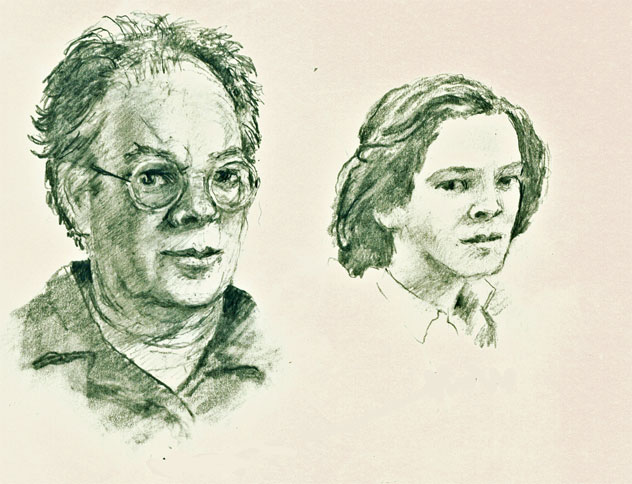
It is an immense Lake and clearer and bluer than
the others. It is as vast as an ocean. It was an extraordinary
journey, which would affect my whole life. It was not as amazing as
Darwin's Voyage on the Beagle, no doubt. But in its own way, for me,
it was. To be outside in this grand landscape and to be alone, with
my father just having died, was a terrible and wonderful fact. I
loved nature before this, but these amazing skies and the great
expanses of water and air, filled me with wonder. The elements
changed me and made me see the earth in a way I could never forget.
This painting is about that. Sometimes I would see Isle Royale for a
distance, though once or twice we went right along side it. I
thought of the wild Wolves and Moose there, and wished I could see
them. I saw the cliffs and the trees and knew it was one of the few
wild places left on earth.
I saved an old photo of the ship on the lakes at sunset
and had a picture of me form that time, which my brother took, and
in it I am even wearing the thick shirt I often worse on the ship.
Since the photo of me I used to do this portrait is rather flat and
with evenly disturbed light, it posed me real problems trying
to get the light right on the face and figure so it would naturally
into the picture of the the ship and the sea, with he sun setting
just behind it. The picture is strongly lit from once source and the
sunset light that is casts strong shadows, But that is me on
the ship, and the vast sky beyond and the Lake all blue and yellow
and purple, with he water holding every color of the rainbow sky. It
was a marvel to be out there and to be alive.
My father had died
when I was 17, and the sadness of that pervaded everything,
even the time on the ship. Once I had some money I enrolled for a
semester at Marietta college, studying painting with someone there,
as well as writing. I wrote some of my first poems that are any good
there, sad poems of lost love. I began the intellectual
researches that would lead to where I am today. It was a nearly a
monastic year of study and mourning, conflicting with a great desire
to know and absorb life. I ended up disliking the monastic idea but
then I was fascinated with the history or those who rejected the
norms of our society. I was caught up into the landscapes of
and between the Great Lakes and the Ohio River, subjects that still
interest me.
*******************

Oystercatchers in Northern California
(Haematopus bachani)
I am spending the summer doing things i have wanted to do for along time, but put to the side to do Plein Air work. Since it is nearly 3 years since I started doing Plein Air work, it is time to stop for awhile and do some of these neglected paintings. That means working in the studio more. I already miss being outside allot, but these things have to be done. So the first one is Oystercatchers. this is not an Ohio painting, but that does not matter, I am expanding the scope of these studies. this is about birds, which is one of my favorite things to paint.
Oystercatchers are an amazing and rather rare wader or shorebird with a vibrant red beak. They live between Baha and the Aleutian Islands. I saw these up near the Oregon border in Northern California, near a sad, and rather poor town called Crescent City. We had gone there to check out a nursing home for my Mom, since many those near Eureka, where we were then living, were owned as a monopoly by one rather neglectful company, who ran their Nursing homes for profit rather than good care of the elderly. It was a terrible place and we rejected it. We stopped to see and study the tide pools on the coast.
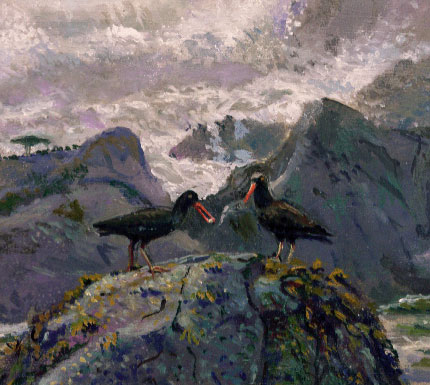
actual size
I have been
thinking about this painting for 7 years now,, since we lived in
Northern California. I spent a lot of time there making reference
photos and video. I did not have time to paint as I was caring for
both Mom and daughter then 1 to 3 years old. I was busy with both
everyday, even on weekends. So all I had was my cameras. We thought
we would stay there, but it was impossible because of house prices.
I was not able to paint for 4 or 5 years. From 2005 till 2009 there
is no art by me, just photo, video and written works. I like working
form video as it is far more varied than still photography. It
approximates the actual. So there are many paintings I could do
about Northern California coast. In our spare times we studied
everything, the redwood forests, the intertidal zones, anemones,
fish, whales, creeks, Octopus, Dippers( never got a good photo of
those though I saw them and tried) salmon running- all kids of
things. It was great and we miss it. I am very tired of the US and
its politics.
There is nothing like the Pacific coast. Besides growing up there, I lived there at various painits in my life. Most recently I lived there for 3 years in 86-90, and then again from 2005-07. First in Point Reyes and then in Eureka. So we explored the Coast a bit on the way back form the Nursing Home and discovered these birds. There were at least 5-7 of them there, a family I expect, as they are monogamous. I got some good footage of them flying but when I tried to put it into this work it made it too busy and cluttered, so I took it out. They are great birds, very vivacious and talkative, with a marvelous whistle like call I thought very charming. The Black Oystercatcher is only black below and in some lights looks dark blue with a brownish back. There are thought to be only about 10.000 left, so it is a species of concern all though its range, since people arrogantly feel they should dominate the coasts where these birds have adapted to live over many eons.
This painting is a departure in a number of ways I used my new medium on this which is Walnut oil, turp and pine resin. I liked working with it a lot and will try it again. Very transparent and velvety.
The other thing that attracted me at this place was the transition in light and gradation of light form the clear rock in front one which the birds sit, gradually back to the larger rock sea-stack in the distance.
I am not sure about environments, it is more a question of distance or no distance. In this one the viewer is less close and that is because I love the sea and rocks and wanted to paint that as much as the bird. I would like to do another that is closer and has other wildlife in it like Mussells, Chitons, SeaStars nd Anemones. But on this one I just wanted to show where the bird lives, as they are exclusively adapted to this intertidal terrain.
********************************

This
is my son at age two in our backyard, which I let
go wild, most years. The figure is
from a
photograph I took three years ago and have wanted to paint ever
since. It often takes me a while to get around to things. So I did a
drawing of the photo and then painted all the grasses and
flowers from life
around the drawing. Doing the wildflowers in April, (below) renewed
my courage to try this again. The first time I did a field like this
was way back in 1983 or 84, 30 years ago. I can think back through
the history of fields I have loved in my own life. There was the
public park that had a wild field next to Lake Erie, destroyed by
public official who sold it to a developer to build a McMansion on.
There was the goldfinch field I loved now made into a development in
Westlake where they made a fake village or corporate stores, really
an outside Mall. Developers never have to pay the real cost to
animals and plants of what
they destroy. The field in Arcata where the White Kite liked to fly,
looking for voles. Fields in Point Reyes or Stockton, New Jersey or
the bobolink field I saw in Upper Michigan.
My son is
standing in our backyard. I slowly worked form life,
painting the grasses and flowers over
several weeks. I like the Bugleweed (Ajuga
reptans), which is purple or blue and which is mostly toward the
front or lower part of the painting. There are also Buttercups, and
Violets. The red spikey flowers are a variety of Red Sorrel. There
is also some wild strawberry, and grasses. I love the dandelions
which so enchant my young children, both for making bouquets to give
to me or their Mom--- or to blows off seeds and watch them float
away. It is a portrait of my young son a few years ago, but is also
a picture of me when I was a boy and now too, as I love to see wild
lawns and flowers. Seeing my son enjoying nature so much is a great
joy to me and I well understand his youthful wonder. So to some
degree this is a self-portrait as well as a picture of him. It is
about the wonder of small things.
************************
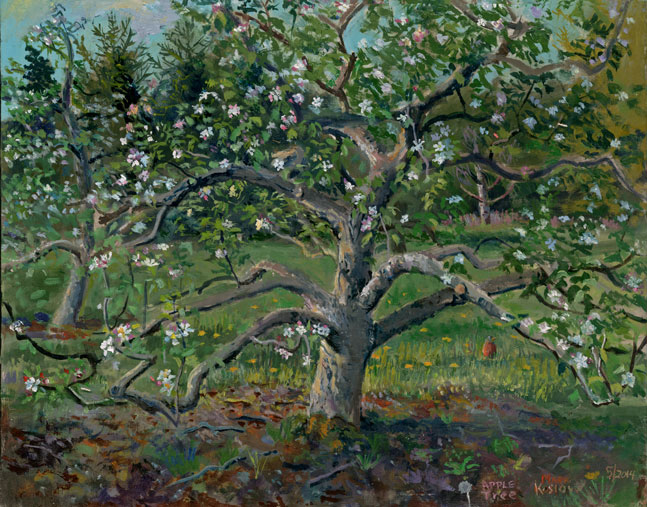
The first is an apple tree and Robin where we get our apples. It is an apple farm next to Cuyahoga Valley National Park and we have been going there for seven years. It is private land so I had to ask if I could paint there. Their little girl, who is 8 kept coming out to watch me. I started when the tree was still bare, to work on the structure of the branches, which were quite intricate. The tree had been eaten by deer, because the farmer does not fence this area, as it is pretty close to a road. So it did not get that many blossoms, so I used other, nearby trees, as a reference. There are hundreds of trees in this orchard, but I only did two, and the second is more suggested than done with every branch and leaf. As the leaves developed I kept them to a minimum, as I wanted it to appear as it did when the leaves and flowers first come out, and the background could still be seen. I went 5 or 6 visits, and by the end the flowers had all died, so I worked on the ground, which was lovely and rich with loam and mosses. There were pines in the background, and a Green Heron there one day, which surprised me. Robins were there nearly every day, and one day a pair of males were fighting over territory or a female. Orchards are a good place to see birds if they do not use herbicides or pesticides. Cemeteries are even better.
**********************
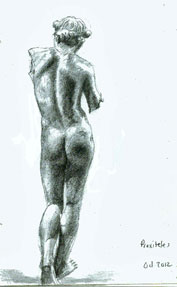
.jpg)
.jpg)
Cleveland
Museum of Art, probably falsely
attributed to Praxiteles
I did a series of works this winter, (2014), whose purpose was multiple. They really have nothing to so with the series on nature and the park, directly, but they are about painting and things I usually do not include in this series. I decided to include them just because they have some bearing on technique and imitating reality. I have been wanting to broaden the scope of the page anyway. Here is my imagining of waht the Celvleand Appolo might have looked like before it was damaged.

What the Apollo
, probably falsely attributed to Praxiteles,
might have looked like.
I have been interested in
Leonardo for many years and admire the anatomical studies he did in
1508-1510, which I think some of the best anatomical drawings ever
done. I like his effort to see all angles of a thing as way way of
coming to know it well. I tried doing this myself with various life
drawings and paintings in recent years such as Cleveland Apollo and the
Louvre Aphrodite as well as more homely figure studies.
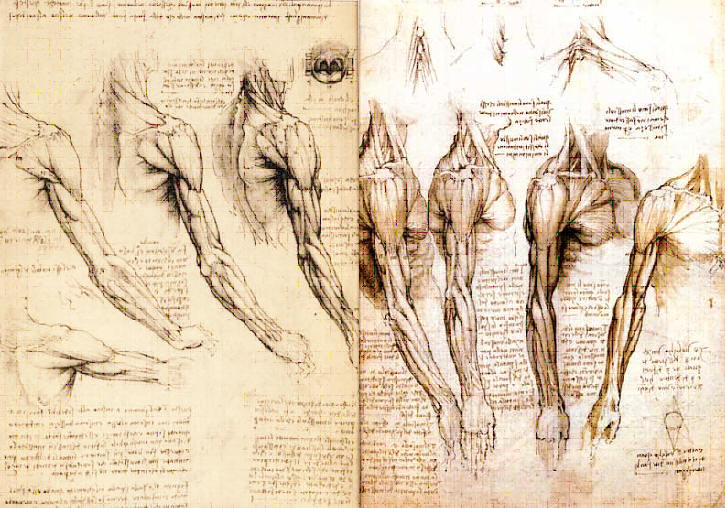
I was studying Greek sculpture partly as an exercise in drawing the figure.. But this led to some painting experiments with a new medium I have never used, pine sap, to see how is worked. I did some research on the art of Praxiteles, and concluded that Praxiteles may not have actually existed. He maybe the creation of various art historians going back to Pliny in the 1st century and who died in the Vesuvius explosion in C.E. 79. Or there may have been such a person, who was lost to history and the name became a sort of dump for various very fine sculptures whose authors had been lost to time. I included the essay on Praxiteles in a book called Persistent Illusions, which concerns various mythical and imaginary theses or invented histories that may have never happened. or fictions which are believed in in sprite of a dearth of evidence. The storyteller Phaedrus mentions that Praxiteles is well known name that many people like to claim as real, like Aesop, but actually many attribute things to him he did not do. My personal view is that there is no real evidence of a sculptor named Praxiteles and the sculptures attributed to him were really done by some really great unknown people whose names are now lost.
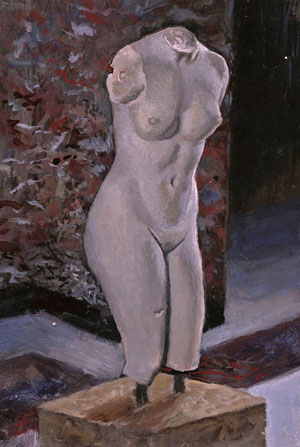
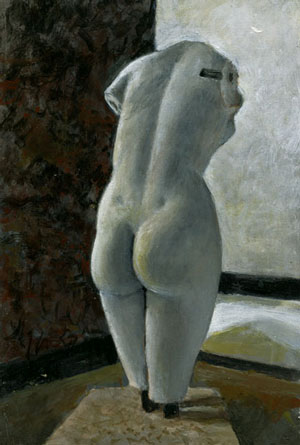
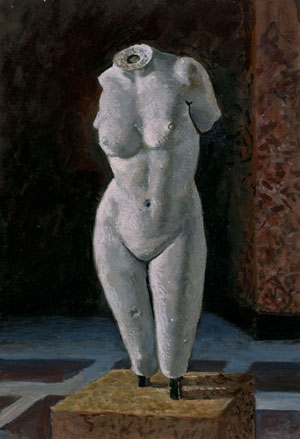
Aphrodite of Knidos, probably falsely attributed to Praxiteles
******************************
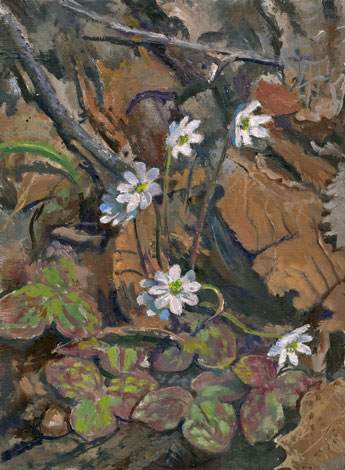
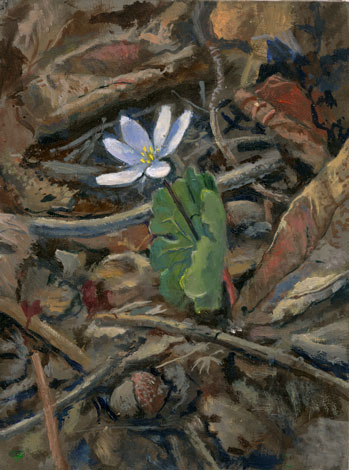
Hepatica and Bloodroot
April, 2014. Here are
two new paintings I did in the last week. I was afraid to do this
last year, not sure I was up to it. But I plucked up the courage and
I tried painting close-up of wild plants from life. I have done
trees and landscape and incidental plants like grasses or golden rod
flower, but never a whole painting of close-up plants. I was not
sure I could handle that much detail working from life. The Black
Squirrel painting I did as a commission recently helped. I set up in
a marvelous park called Furnace Run that has large number of
wild flowers, and while the kids played in the creek I worked,. When
we were all done we had a picnic.
It took me two days for each, a few hours each day to do these when
often it take some 4 or 5 visits or more for a larger work. I think
the result is promising and I might do more like this. The
first is Hepatica and the second on the right is Bloodroot.
Though I went out yesterday and today and tried to do a Trout Lily
but found myself dissatisfied and ruined both attempts in
frustration. I think because the Trout Lily has little contrast and
its nodding yellow head made it hard to paint the flower itself in a
way I found interesting. I love this flower and its leaves and would
like to try again but we shall see. It takes a great deal of
concentration to do this and I wish my hand was a little more
facile.
Hepatica is very hard to find in this area, and we looked for some years before we found them in this park. The ones I painted where white with a slight lavender tint in them but I found a few others which are really a lovely lavender. The Bloodroot on the right does not alst long, and it moves alot while I sat there painting it. By 6 PM it was ready to close and closed quickly, though one never notices any definite movement as it happens, but if one looks away for a while and then looks back it is more closed..
*******************
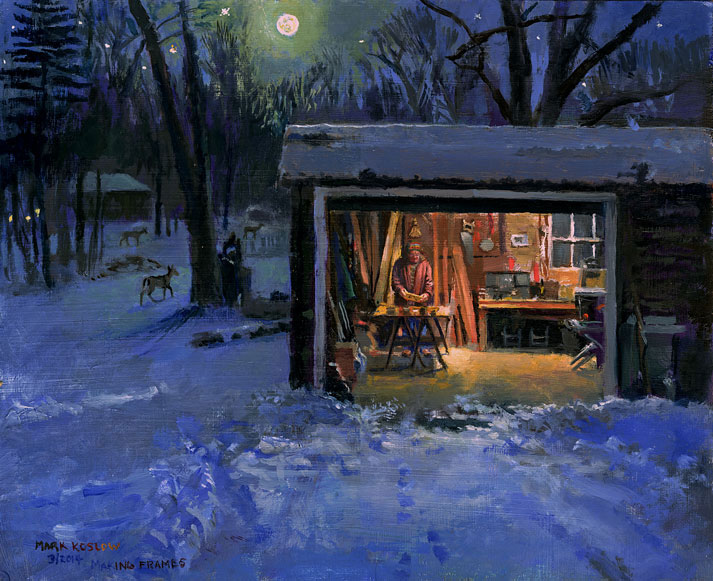
March 2014. The title of this is “Making Frames”
This is something I have thought about all winter. I like how our
old and weathered garage looks at night when the moon is out.
I did this painting on the recent full moon and on days after our
last snow storm. It was such a cold winter this year, with
temperatures well below zero many times. This one shows
moonlight or reflected light from the sun contrasting with human
made light in the garage. This is not the first time I have done a
combination of natural and human light. The last moonlight picture I
did was the train station at twilight. Whatever its source,
light one of the great mysteries for anyone who paints reality.
So, I set up my paint box and started in Acrylics as an
under painting, done very loose and fast and then began the painting
over it in oil. This is not my usual practice, but I wanted to get
an idea of the scale of things before I headed into details in oil.
Acrylics allows quick changes that dry almost immediately. I tried
out various compositions and then headed into oils. One thing I
love about painting a scene like this is I could never take a photo
of this and be happy with it. I did take some photos, but the
backyard is way too dark to get a decent picture, even with
moonlight on it. The camera cannot handle the contrast between the
light in the garage, the half-light on the snow and the bright light
of the moon. There are few good photos of moonlight, but quite a few
good paintings of it. The eye is better than the camera in so many
ways. I am not sure I can explain why I have always enjoyed painting
the moon and its light so much. I suppose it began as some romantic
impulse but now it is more about the light itself and what it does
to our lovely planet, how it generalizes objects and casts its
pearly glow of half-tones over everything, everywhere. It has a
comfort in it, as it takes away the dark. So, I set up my paint box and started in Acrylics as an
under painting, done very loose and fast and then began the painting
over it in oil. This is not my usual practice, but I wanted to get
an idea of the scale of things before I headed into details in oil.
Acrylics allows quick changes that dry almost immediately. I tried
out various compositions and then headed into oils. One thing I
love about painting a scene like this is I could never take a photo
of this and be happy with it. I did take some photos, but the
backyard is way too dark to get a decent picture, even with
moonlight on it. The camera cannot handle the contrast between the
light in the garage, the half-light on the snow and the bright light
of the moon. There are few good photos of moonlight, but quite a few
good paintings of it. The eye is better than the camera in so many
ways. I am not sure I can explain why I have always enjoyed painting
the moon and its light so much. I suppose it began as some romantic
impulse but now it is more about the light itself and what it does
to our lovely planet, how it generalizes objects and casts its
pearly glow of half-tones over everything, everywhere. It has a
comfort in it, as it takes away the dark.
Female deer are such homebodies and love their daily habits.
I knew they would be wandering by with their children of last year.
As I stood next to my Female deer are such homebodies and love their daily habits.
I knew they would be wandering by with their children of last year.
As I stood next to my paintbox on a tripod a group of them walked
by. There were at least 6 but I only put three in the picture. To
do that I took picture and worked form those and I also had my wife
take a photo of me so I could show myself making frames, but all the
rest was done form life.
I had to make a frame in the garage when it was very cold a month
ago. I found the work strangely pleasing, as such work makes one
forget the cold. I measured and cut, applied glue to the boards and
nailed the corners on the framing vice. You can see dim outlines of
the framing vice on the edge of the table. I show myself as a man in
the garage who is not aware just now that the deer are walking by,
they are in their own wild world and living their winter life,
looking for food. I like the silence of the world outside my garage
and the awareness of life going on everywhere, even if I do not see
it. You see the barn of a neighbor distant , maybe you can hear the
coyotes… a whole family lives back there, herons fly over during the
day, and barred owls at night might be
hooting…
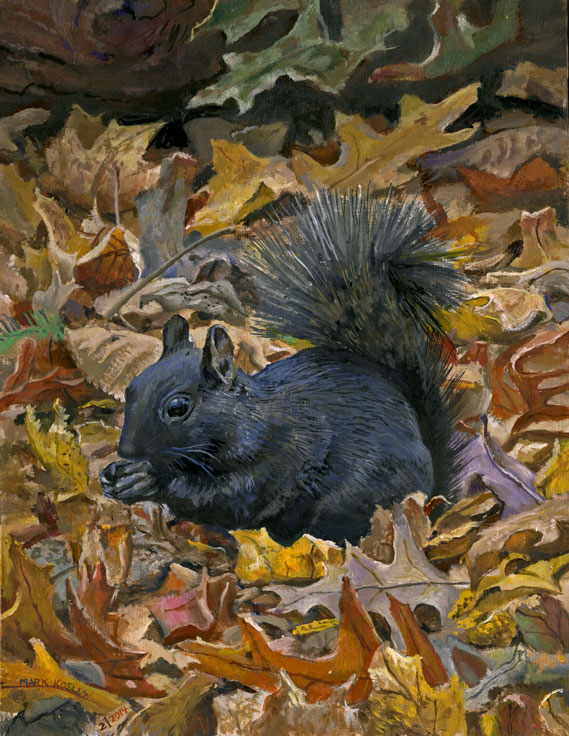
Feb. 2014. This is a second version I did of a
painting originally done in 2011. It was done as a commission. It
was an interesting exercise to try to improve on an earlier design.
I made new studies for it, as I wanted to understand the form of the
squirrel a little better, especially its hands. That meant doing
some drawings. It was an interesting exercise, since it showed me
that any of my paintings can be improved if I work out the details
further. There is not always time to do that. But here I had time
and so in the process I rethought some of the leaves and made some
improvements to the composition. It has more fullness, more life and
same among the leaves, the color is better and the spatial relations
are improved even though we are close up upon the squirrel the
squirrels is naturally set in a real space. It is not perfect there
are still problems with it, but I learned something from doing this
one.
Painting directly from nature is
itself a natural process where one is affected by the weather ad
light conditions and the place and season where one is working. None
of that is predictable. Plein Air painting thus involves some
measure of spontaneous study. On the other hand, paintings done in a
studio are always more static and have more features that are
susceptible to planning and predictable results. This is a good
thing too, but a different thing. I sometimes try to combine the
virtues of both these processes together and that has many pleasing
results. Many Plein air works are too impromptu, and many studio
works are too stiff and between these extremes one can sometimes
create something that has song and freshness in it, but at the same
time is thought through and has moment and stability, Painting directly from nature is
itself a natural process where one is affected by the weather ad
light conditions and the place and season where one is working. None
of that is predictable. Plein Air painting thus involves some
measure of spontaneous study. On the other hand, paintings done in a
studio are always more static and have more features that are
susceptible to planning and predictable results. This is a good
thing too, but a different thing. I sometimes try to combine the
virtues of both these processes together and that has many pleasing
results. Many Plein Air works are too impromptu, sketchy and
incomplete, and many studio
works are too stiff, self-conscious and lacking in real discovery. Between these extremes one can sometimes
create something that has song and freshness in it, but at the same
time is thought through and has moment, roundness, clear form and stability,
********************

Emerald Creek in Winter
dec. 2014 It is such a pleasure being outside for many hours painting something like this, not just for me but for my wife and kids too.
This one of me and ourkids is set in one of my favorite local places, I call this onee Emerald Valley in Winterrbecause of the green profusion of mosses and lichens that grow on the large rocks here. The large rock are Berea sandstone. There is a creek with a waterfall which also appears in another work below. That is to the right as you look up this little valley. Emerald Valley is known to others as Deer Lick Cave as there is a cave here too. The scene itself is entirely done from life though I had to use photos for the kids and my wife and I. It took quite a few visits both when we had snow and when we did not. When we had no snow I worked on rocks and water. I worked on the snow when it arrived again. The faces were very difficult as they are so small, and I tried to create my own brushes, but none of them were precise enough. The Victorian and Albert museum says that miniature painters used squirrel hair in preference to other hairs . They painted on Vellum, or animal skin at first but then the forbidden ivory. I have no wish to do either, but I might try making some squirrel hair brushes from a road kill, though I am not without mixed feelings doing that.because of the green profusion of mosses and lichens that grow on the large rocks here. The large rock are Berea sandstone. There is a creek with a waterfall which also appears in another work below. That is to the right as you look up this little valley. Emerald Valley is known to others as Deer Lick Cave as there is a cave here too. The scene itself is entirely done from life though I had to use photos for the kids and my wife and I. It took quite a few visits both when we had snow and when we did not. When we had no snow I worked on rocks and water. I worked on the snow when it arrived again. The faces were very difficult as they are so small, and I tried to create my own brushes, but none of them were precise enough. The Victorian and Albert museum says that miniature painters used squirrel hair in preference to other hairs . They painted on Vellum, or animal skin at first but then the forbidden ivory. I have no wish to do either, but I might try making some squirrel hair brushes from a road kill, though I am not without mixed feelings doing that.
Note: I have decided to change the name of this page. It was calledd 2 years of painting in Cuyahoga National Parkk. But that is too restrictive. I love the National Park, but these paintings are going beyond its borders now. I am thinking to call itt Life in the Valleyy. I have been doing this nearly two and a half years now. I want to branch out into everything that concerns me and widen the scope of the work.
***************************
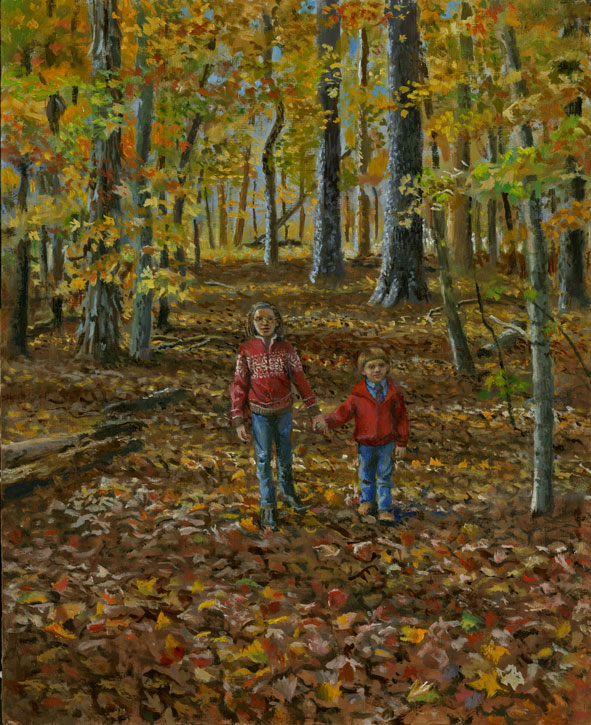
October Walk
In October, 2013, I did the painting of birds in the Wetland, (Birds Near the Eagle's Nest below) at the beginning of the month and began the painting of my daughter in the studio. But we were very busy and there was that absurd government shutdown which included shutting down our park. It is impossible that I should miss painting the fall. So when the kids and I went for walks in the woods in various places I took pictures of them, knowing I would not have time to do one plein air. They love to romp and play in the leaves, run through them or step on the rocks and over the creeks. There is nothing like fall leaves when you are a kid.
Most of the paintings in this series are done from life. But I did this one entirely from photos I took in October. It can be very challenging to work form photos too, though it is a different sort of challenge. I made this as a composite of various photos in various places. I was not entirely happy with any of the photos but, but liked aspects of many.
This might be
a good spot to discuss photography again. My objection to
working from photos is not a purist or dogmatic one. I know
people who think it is impure or immoral to work form photos. That
seems too precious to me. I am not opposed to photography at
all. But I don't think one should directly copy or trace them.
It is a kind of cheating to use projectors. It is said that this is
what Vermeer did essentially, with the camera obscura or Ingres
alleged use of the camera lucida, which is not proven to my
knowledge. In any case, I like the meditative and exploratory nature
of drawing from life. But I do not mind using photos as
aides or references for free hand drawing. I don't make grids or use
any optical devices. Sometimes I will measure in the classical
drawing method of holding a pencil, plumb line or stick up to
measure . But I find photography an important aid to seeing and
study.
I feel photography is an
extension of my sketch book and my imagination. The are a part of
what I know about a place or an event. But I have no illusions
about the limitations of photography. Photos are so imperfect and
distort reality. The immediacy of it is its main drawback as life is
not really immediate. Things take time, and understanding takes even
more time. Photographers might find this surprising, as they think
they are so accurate. But actually light and form are highly
variable according to weather and time of year, not to mention
subtle gradations of saturation or intensity of color, hue or
shadow. Dark and light alone is a huge subject, as Leonardo
understood very well as he wrote about light shadow and optics at
great length. I think I can get more subtle gradations of shadow,
hue and saturation than any camera. But I do not think I can be as
literally as accurate with shape and form when I draw of painting
free hand as a camera can be. But there is a proviso for this---
I add that a camera tends to be incapable of a certain deepening of
the meaning of forms which the mind and brush can accomplish. By
'meaning of forms', I am implying that the study of a given form
gathers depth with time and one must be exposed to it over a long
period to begin to grasp some of its character and nature.
In the 1990's and 2000's I did various studies of leaves and forests in the autumn in the among them are these.
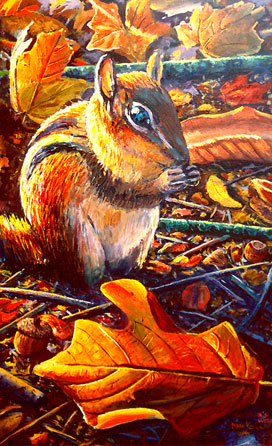

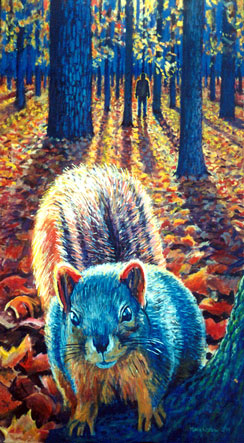
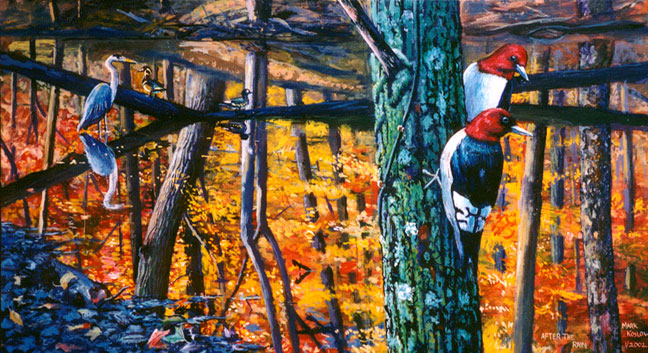
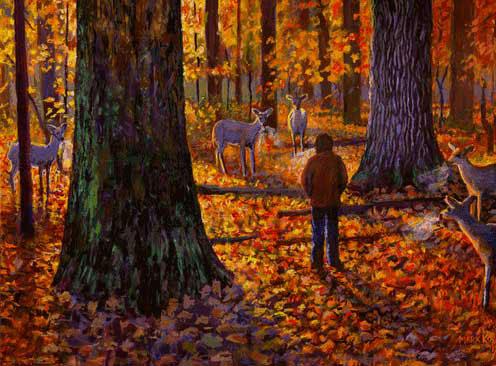
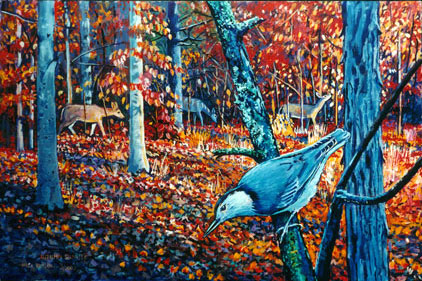

Part of my intent
in these larger autumnal works done
over a decade ago was to paint late
light, light near sunset or dawn.
This is clear in the "Chipmunk's
World" or in the "Squirrel Tail in
Sunlight", as well as "Breathing
with Deer at Dawn". The raking light
in the chipmunk painting was studied
over many weeks and involved getting
down on the ground a recording
leaves and sticks and very low
angles. I used a video camera too. I
studied nature closely for weeks and
then worked in the studio mostly
from video references. I was trying
to capture animals in their own
exact worlds as closely as I could.
In newer works I have been much more
concerned with precision of drawing
and modeling form as well as with
accuracy of portraits and landscape.
The influence of impressionism has
diminished. My daughter is getting
mature mentally and I had to please
her with the portraits and that took
some days, as she found fault with
aspect of the portraits. In "October
Walk" it was afternoon light, rather
than late light I was painting. I
was trying to catch a certain
relation of the brown and decaying
leaves on the ground, compared to
the yellowing and old gold of the
leaves still one the trees here and
there enlivened by the green still
left from summer.
I have also been interested in miniature
paintings for a year or two. The
Cleveland Museum of Art has a
wonderful show, up just now, (Jan.
2014) of their miniature paintings
from several centuries put together
by Cory Korkow. This is an amazing
show that features many fine
portraits. She defines the miniature
rather more narrowly than I do, and
certainly she is right to be
responsible to history and good
scholarship. There were distinct
conventions in this type of
painting. But my concern is as
a practical artist. For me the
miniature is a challenge and test of
skill, and could be done in
watercolor, oil or any medium
precise enough. What is it done on
scarcely matters. I use board. 19th
century "miniatures" in the
narrow sense, were done in
watercolor on animal remains of
vellum or Ivory. I have
ethical concerns using either
material. I have also been interested in miniature
paintings for a year or two. The
Cleveland Museum of Art has a
wonderful show, up just now, (Jan.
2014) of their miniature paintings
from several centuries put together
by Cory Korkow. This is an amazing
show that features many fine
portraits. She defines the miniature
rather more narrowly than I do, and
certainly she is right to be
responsible to history and good
scholarship. There were distinct
conventions in this type of
painting. But my concern is as
a practical artist. For me the
miniature is a challenge and test of
skill, and could be done in
watercolor, oil or any medium
precise enough. What is it done on
scarcely matters. I use board. 19th
century "miniatures" in the
narrow sense, were done in
watercolor on animal remains of
vellum or Ivory. I have
ethical concerns using either
material. I have also been interested in miniature
paintings for a year or two. The
Cleveland Museum of Art has a
wonderful show, up just now, (Jan.
2014) of their miniature paintings
from several centuries put together
by Cory Korkow. This is an amazing
show that features many fine
portraits. She defines the miniature
rather more narrowly than I do, and
certainly she is right to be
responsible to history and good
scholarship. There were distinct
conventions in this type of
painting. But my concern is as
a practical artist. For me the
miniature is a challenge and test of
skill, and could be done in
watercolor, oil or any medium
precise enough. What is it done on
scarcely matters. I use board. 19th
century "miniatures" in the
narrow sense, were done in
watercolor on animal remains of
vellum or Ivory. I have
ethical concerns using either
material.
I am not making miniatures in
the narrow curatorial strict sense
of the terms. Those objects predated
the photograph and were like photos
or cell phone images are now, and
thus they are really a thing of the
past. They were intimate
objects often carried on ones person
and often meant to keep the loved
one close. But my interest is in the
intimacy of such miniaturization,
not the conventions of the genre. In
the 16th to 19th centuries the
narrowly defined miniature arose as
ah need in the wealthy classes and
was developed as a trade--- an
economic category of practice and
sale. Artists and dealers had an
interest in keeping this genre
exclusive. But the best
miniature art works, small
paintings, such as those done by
Sultan Muhammad in Persia, Hindu
miniatures, the Book of Hours by the
Limbourg Brothers or Van Eyck and
Meissonnier, are also small
paintings, often in books, that are
incredibly accurate, accomplished
acts of intelligence and skill,
human sized and easily taken in by
the viewer at close range. Katherine
Coombs, in her book Portrait
Miniatures in England, records
that the miniature actually has its
roots in similar book illumination,
and was called "Limning" ( see
Limning, 1534) and only
later was called "Miniatura". A
limner was an illuminator of
manuscripts and one who works with
color and gold and silver.
Nicholas Hilliard tried to define
limning as a genre only for
gentleman, and only done in
watercolor. But this is the rhetoric
of a class system and not the
reality of painting that are small
and intimate, which crosses classes
and countries.
It is not that far from the amazing
miniaturization of the Book of
Kells to Van Eyck to Hilliard. One
could stretch the conventional
definitions of miniatures and even
say that some of Vermeer's works,
tend toward the miniature, and
indeed, that Vermeer continues the
tendency began by the oils and
illuminations of Van Eyck. Coombs notes that the
Dutch or Flemish art of painting
small paintings had an influence on
early miniatures, so I am not
entirely wrong to connect miniature
painting back to certain Van Eyck's
and some of the other Dutch painters
of small works. Van Eyck is thought
to have done various illuminations.
Coombs traces limning back to
Lucas Horenbout, who is thought to
have brought small and precise
painting from Ghent to England. Van
Eyck was doing extraordinary small
works a generation or two earlier,
not far form Ghent, in Bruges.
Indeed, Van Eyck's works are so
startling that he changed the course
of history. Van Eyck's presumed self
portrait in the National Gallery in
London is only 19x 26 centimeters
and he shows every wrinkle around
the eyes and beard stubble on the
chin. This and other small works by
Van Eyck might be the models that
most influenced Horenbout, who was
the teacher of Hans Holbein, who was
Hilliard's teacher. Indeed the
entire Northern Renaissance is in
some ways the artistic child of Jan
Van Eyck. Coombs
traces one line of limning to the
great Elizabethan painter Nicholas
Hilliard , and another to Henry
Peacham's influence on the history
of watercolor in general.
Coombs implies a much more broad
understanding of the art of the
miniature. The narrow concern with
the personal miniature was evidently
an art that grew up with royalty and
the upper classes and really
disappears with them. But the larger
context is the rise of precise, one
might say, scientific painting and
begins with Van Eyck. There is no
particular reason to obey the
careful restrictions on the genre
anymore, but the technical expertise
can be adapted other uses, as Ernst
Meissonnier thought in the 19th
century .
It is stretching it a bit to say that Leonardo's late drawings in anatomy or mechanics could be put in this category, though many of these are watercolors on top of drawings, as are the 19th century miniatures, narrowly defined. But many scholars have pointed out that Leonardo was influenced by the northern revolution in art and that means, directly or indirectly, Van Eyck. What Leonardo shares with Van Eyck and with Holbein is a devotion to the intimate and precise perception of reality. What I admire in these is intelligence and skill as well as beauty, and when this is done in a small format , it gives the image great intimacy and human closeness, often illustrating ideas, myths, facts, people or histories. With the miniature now a dead art, its employment need not be so strict and I feel quite free to apply the miniature technique more broadly in oil and even into Plein Air. Small works by Winslow Homer or Eastman Johnson have this same intimacy and life likeness, which is often lost in larger works. In the Toledo museum I recently saw Johnson's picture of a man husking corn with his boy beside him, who is making a little house out of the corn husks. Johnson's work have great warmth and sympathy and I admire him. This work is a small masterpiece of the kind I am speaking of.
So in a work like "October Walk" I was trying to do a little of what these great forbears did. This is not to say that I have Leonardo's or Van Eyck's skill, but like them I am trying to understand reality. The size of the portraits in my painting is close to those of 19th century miniatures and I used some of their techniques, such as painting with very small brushes I made myself and I used a magnifying lens which I attached to my glasses. There is an old Hickory tree on the left and a few large Cherry trees further back. Most of the trees are Maple and they create the yellow canopy, making the space around my children luminous with light.
*************************

My daughter found this leaf at the Cleveland zoo, and I thought it the prettiest leaf I had seen this fall so I did a small oil of it. I love the harmony of the colors and the even gradation across its whole form.
********************

We go to the Natural History museum often and they let us use some of their taxidermied exhibits. While my daughter was drawing the squirrel I painted her doing it over several days. I was intrigued by her concentration and the reflections of fall on the plexiglass container where the stuffed Fox Squirrel sits. it was raining outside and the new rake rests against the garage. The new rake broke a few days later, badly designed, I guess.
This is a an inch and a half less than life sized.
****************
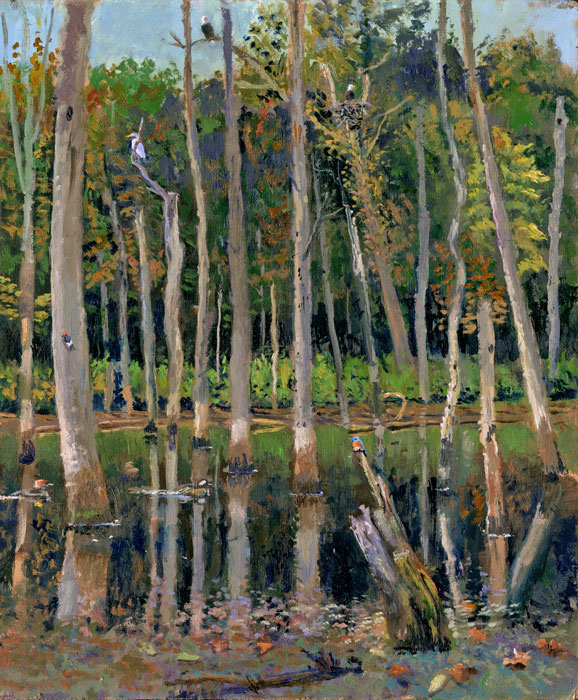
Birds Near the Eagle's NestBirds Near the Eagle's Nest
This painting is of the Eagle nest area, and is not as finished as some other recent works. This place is not that easy to get to when the kids are with us, as the tracks are long and hard for a young child to walk on.
This area is closed more than half
the year when they are nesting. It
is open down there now and it is a
marvelous place, ---full of birds--
including rare ones for this area
like the Hooded Mergansers and the
great white Egret. These are the
first eagles to nest in our county
for 72 years. I have done them very
small and subordinated them to the
wetland biome, and made them only
just a little bigger than the
Bluebird that is perched in front. I
was trying to show birds as I
actually see them in their context
and not do an illustration of
species. I saw the eagles, the Red
Headed Woodpecker, the Bluebirds and
the Egret on the days I was there
and painted them partly from life.
The Mergansers I saw there some
years agoa nd did them form a photo
I took. It is a small
painting, about 8 x 10". I
have enjoyed a certain pleasure in
miniature works of late. This one is
9x12” or so. I had to stand in the
mud to do it, wearing boots as the
pond is very clotted with buttonbush
and other plants..
Somewhat mysteriously, the sycamore trees
which dominate the wetland all died
in the last 4 or 5 years. It was a
Heron rookery 5 years go with a
hundred herons there,--- but that
rookery moved across the valley and
you might recall my painting of that
in March 2013. The Eagles where
predating the Heron’s chicks. The
official explanation for the loss of
the sycamores was a Beaver backed up
the pond, but I never saw the
evidence of that and doubt it. We
had record rain fall and that raised
water levels for a few years then
there was a drought year. I think
that killed the trees. Many
sycamores are springing up on the
banks now. Because of all the dead
snags there are a lot of red headed
woodpeckers and I love them. I
painted one on the closest tree. But
they chatter and carry on
everywhere. I saw what appears to be
a Siskin and have seen many warblers
in this area including the
Prothonotary and Cerulean. Both are
rare birds in this area..
It is one of the healthiest wetland around here, in short. The train track go right beside it and on the maps is called Pinery Narrows.
I did it during the
absurd government shutdown, where
republicans shut down the government
to try to blackmail democrats to go
along with their desire to railroad
Obama's health care program, which
is neither radical or enough to
solve the heath care horrors that
occur with terrible regularity in
America. In 2011, 700,000
people went bankrupt and 45 died--
and those are just the ones counted,
probably thousands died who were not
counted, directly due to lack of
medical insurance . One of my old
friends died due to insurance
company denial of care last year. She was not
counted in any statistics of
Insurance company caused fatalities.
The insurance and hospital systems
kill people while they make money
from them. It gets worse every
year .The republicans lost the
health care debate and wish to
subvert democracy by demagoguery and
blackmail tactics, forcing their
will without bothering to vote. The
republican party should go the way
of the British House of Lords and
simply be dissolved as one of the
most corrupt parties that every
existed in American politics. It
really is just a tool of American
corporate interests . In any case we
went into the park during this time
and it was not a good place to be in
many ways. The loss of any
overarching authority in the parks
made them somewhat lawless. Our
national parks do not belong to
congress, but to us, and congress is
merely our nominative
representatives. but they are so for
bought off by corporate lobbies that
one would never know they work for
us. various people made same great
signs to protest the closure of our
National parks.
note: 3/2016
The anti-federal land and national park
tendency of the republican party
bore some nasty fruit in late 20015,
when the Bundy bothers are their
associates took over Malheur
Wildlife refuge in eastern Oregon.
It later came out that ALEC and the
Koch Brothers, two very corrupt oil
billionaires, who hate anything not
privatized for corporate profits,
had some influence on this as they
too wish to undermine the national
park and wildlife system that does
so much good. Malheur and Tule
Lake, among other places, are very
important migration areas for
millions of birds who migrate down
the Pacific Flyway. The Koch
Brothers are worth nearly 50 billion
dollars a piece and in my view they
should be taxed at least 90% of
their income. Any rich people that
advocate destroy protected bird
migration areas and seizing
protected land for cattle is immoral
and criminal.

*****************************

Milkweed Beetles on Milkweed in a
Wild Field
This started out as a goldenrod painting, but then I saw the Milkweed beetles so it became about that too. I have admired them for years and they don’t seem to affect the milkweed population much, though I read they do make some seeds infertile. More than once I had to herd them around the milkweed pods with a paint brush to get them on my side of the plant. I don’t think I have every herded bugs before . They seemed to be drinking white ooze that comes from the pods which are poisonous, so I imagine like the monarch butterfly they have somehow adapted to not be affected by the plants toxic liquids. Maybe that is why they have such strong designs too, telling birds that they are poisonous.
Notice I put a Monarch butterfly in the field. This is because wherever milkweed is Monarchs are often nearby or on the plants. The new National Geographic magazine (Aug, 2015) has an article that states that there were one billion Monarch Butterfly a decade ago and now they think there are only 50 million. This is very alarming. They try to blame this on killing off milkweed, which is the host plant for this butterfly. but there is much much more to it, as genetically engineered crops and herbicides are the main culprit and this boils down to Monsanto corporation and their glyphosate, which has the brand name of Round Up. It is evil stuff. We went to Oberlin College recently to see a few plays and driving back I studied some of the fields closely. I was wanting to see evidence of the use of glyphosate, the Monsanto chemical that is killing off all the monarchs. All the fields I saw have a brown ring of dead grass at the edge of the crop which indicates use of an herbicide. This is so in the corn and soybeans. The other thing is that there was not one stray plant, weed, blade of grass in the crop itself, which suggests they are using the technique of using herbicide resistant Monsanto seeds. Chillingly, I realized that nearly every farm is using this dangerous and destructive method and that the whole continent is getting doused in an ocean of toxic chemicals every year. I did not realize the extent of this till recently. Tis is an atrocity of huge proportions and one that should lead to shutting down or withdrawing the charter of Monsanto corporation and anyone else that is killing milkweed and Monarchs.
Insects are
fascinating, and the more I learn of
them they more they are interesting.
When I was younger I was quite
interested in them and even brought
home a Black Widow Spider in a jar
for my mother to see when I was in
3rd grade. She was frightened by it
and drowned in in formaldehyde. It
turned pink. That was sad.
When I was young too, I was looking for snake with my brother
and thought I saw a snake in a
gopher hole and put my hand in and
pulled out a Jerusalem Cricket. I
was sure it was a Tarantula and
started running around in circles in
hysteria. My brother slapped me
and I woke out of my delirium and
crying.
For some
years I think my mothers horror of
bugs got me too. I struggled against
it and slowly have come to admire
them. Being able to study insects in
drawers at the local natural history
museum has helped allot. Talking
with entymologists has too. I recall
infestations of cattle flies form
Chicago meat yards in the Northern
Peninsula of Michigan and
infestations of Stink bugs on the
gourds we grew in our garden one
year. Life is amazingly fecund
sometimes and one has to learn to
develop a certain strong stomach to
see these things without prejudice.
I love the sound of Cicada's in
later summer and ants are amazing.
Leaf Cutter ants actually farm
fungus, which they culture on the
masticated leaf bits they gather
from trees. One should strife to see
all life as valuable and each
species as having the right, and try
not to see even the most repulsive
species as repulsive. There are a
few things that one kills because
one must, such as mosquitoes or
germs that might cause disease,
hence the use of necessary vaccines.
But it best not to kill any animal
or insect if one can help it.
*************************
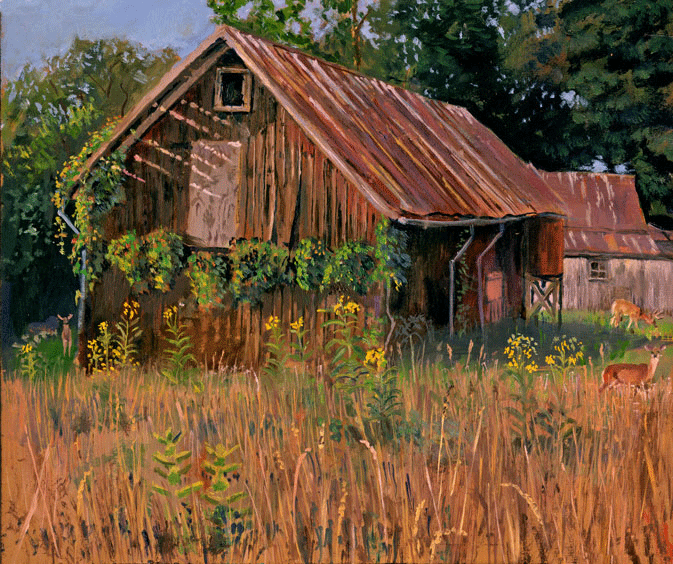
Wingstem, Deer and Barns Reverting to Nature, Deer and Barns Reverting to Nature
My original motive for this was to paint the leaning old barn reverting to nature. It is near where I painted Shirley's Horses early in winter of this year (2013). I love this reversion to nature that building go through. Nature reasserts its primacy in the end, even if, as here, there once was a series of families that lived here and prospered on this fine piece of land, now part of the National Park. I have been seeing it for some years and have admired it, abandoned in an old field not far from where I live. One purpose of this painting was originally to paint the Wingstem, whose flowers die off in mid September. I worked on this one for or five days, a few hours each day. The Wingstem was out still, when I started, but had gone to seed by the time I was done, the petals all fallen.. The rusty old water container raised up on a pedestal is typical in old barns. This one has rusted right through and is leaning rather precariously. The history of Barns is a worthy subject and it would be interesting to identify different sorts of styles and structures built i the last few hundred years. I am guessing this bar is at least 100 years old perhaps more.
I was out painting an old barn that is down the street from our house, it is slowly falling down and a real pleasure to watch nature take it over again,--- so I was peacefully working and towards twilight a whole group of at least twenty Night Hawks (ChordeilesChordeiles minor, Caprimulgiformess) showed up and started darting all around me, up to within a few feet of my head, and they were doing this along with many chimney swifts and dragonflies. Quite amazing. I found out later that they are now thought to be related to the Swifts, which is interesting. I tried to photograph and video this but my little camera could not handle the light well. I have only seen nighthawks in mass like this once before. Usually they are fleeting glimpses later at night. I could not see what they were all eating, but it must have been very small midges or gnats as they were invisible to me. I wish I had a better camera as it was really amazing to see these birds so close, I could even glimpse their mouths open sometimes.
*****************************
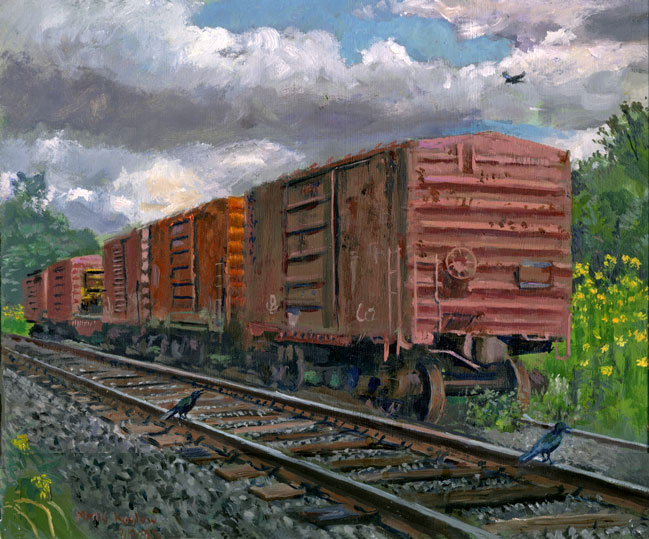
Crows Talking Near Rusting
Boxcars
This painting like the one above,
also began partly as a study of
Wingstem. I am not a botanist but I
love painting plants, and mean this
series partly as a portrait of some
of the plant species in our Valley.
These trains are abandoned inside
the national park. They call forth
the days of the Hoboes for me, a
time I admire, when the reign of big
business came into question in
America, perhaps more than any
other. Of course, these are
rusting boxcars and trains are not
used as much as trucks now, which
waste huge amounts of gasoline.
They are not a cliché to me, though
many see them as such, as they see
anything to do with the past as
cliché. But painting of the
kind I do is about looking hard at
something for days or weeks, and the
more real it is the better. The wear
of reality interests me, my own
ageing skin, my mothers dying face,
the look of old flowers and the way
time changes wood or fabrics, or my
children's faces. The world of
advertising is the world of people
who do not want to admit anything
gets sick or dies and there is no
sad passage of time. No one knows
why time keeps passing. Those
who live enclosed in cities or in
their cell phone world of cyberspace
are often divorced from the actual
and daily suffering of ordinary
people. An old box car holds the
dreams of an American that now fades
and fails into the future, done in
by CEO's and corporations who put
themselves before workers. The crows
sound the call of the renewal of
nature, coming back to bring life
again, as a new generation seeks to
make the world better than mine has
done.
As with the neglected trains and ordinary
species like crows, I too feel out
of the mainstream and live a life
closer to nature and gladly farther
from the self-regarding crowds of
New York City. The talk of crows is
part of the language that few
understand and few listen to.
Over many years I have often watched
crows talking and they are amazing
communicators, smart birds and much
hated for it. No one knows exactly
what they are saying but the more
you listen the more you begin to see
that their abilities are quite
advanced. Chomsky would deny that
such language skill as crows have
means very much, but I know he is
wrong about this and many other
things. It started as a portrait of
the Wingstem next to the trains, but
then become something else. The
crows kept me company.
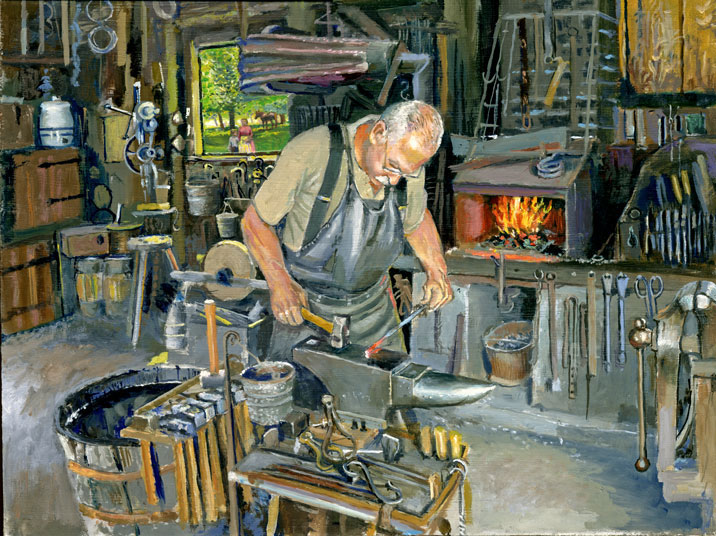
"Marty,
the Blacksmith at Hale Farm"12x16"
August 2013
This
was done over a month or so, with a
few visits to the barn Where Marty
works at Hale Farm. The figure I
could not do from life but a lot of
the rest of it was done form life.
Hale
Farm is a sort of living museum run by
the Western Reserve Historical
Society. I had to stand in the
in the door of a barn where Marty
has his shop, and it was a narrow
space and lots of visitors coming
and going asking Marty questions.
It is too crowded to be a good place
to paint. I don't like to paint
around people that mush, though I do
it pretty often, but this was
particularly hard to do. Also, I had
to stop for a few weeks awhile
because they did a civil war
re-enactment there which we took the
kids too and that was great. There
was a reenactment of the first day
of Gettysburg, when the South was
winning and they drove back the
union into the town
I could not resist painting this.
I was often bringing my kids to
educational class and experiences at
Hale Farm. It is a good place to
teach them history and expose them
to various occupations common over a
hundred years ago. I was attracted
by the skill of Marty's artistry. He
has been in this shop for 34
years and is a real craftsman. I
love this sort of knowledge and
expertise. Indeed, I think of it as
applied science, which it is, of
course. He knows a lot about metal
and how it magnetizes and
un-magnetizes and its structure and
weaknesses. Indeed, according
to Clifford Conner, in his
Peoples History of Science, he
says pottery probably helped create
metallurgy, and first that meant
making bronze and copper, but
later Iron was forged and
blacksmiths began their experiments.
So blacksmithing is probably part of
the the origin of chemistry
and thus is important in the history
of science.
It was fun to spend a few weeks trying to paint him
from life. I learned a lot form him
about his trade. I had to take
photos for the actual pose as he
moves too much. But you you
can see how amazing his shop is.
I painted as much of it as I could,
but you can see how intricate and
involved his space is. The
detail in his shop is infinite, and
I left a lot out. It was fun to spend a few weeks trying to paint him
from life. I learned a lot form him
about his trade.I had to take photos
for the actual pose as he moves too
much. But you you can see how
amazing his shop is. I painted
as much of it as I could, but you
can see how intricate and involved
his space is. The detail in
his shop is infinite, and I left a
lot out.
The anvil, grinding wheel, bellows, table, water barrel and vice and many of the implements were done from life. I had to use photos for other parts, like the drill press, calipers and the pliers. these tools are all part of a long tradition of inquiry and science that went into this craft, a rare craft nowadays, but historically one that was very important.
I spent more time of this painting than on some of the others, but I did enough from life that it is not a studio work. This is part of the series on the National Park, and it is an anomaly already in that collection, so I wish to retain some measure of plein air savoir faire, as it were. But as I did work part of the painting form photos I learned a good deal about the limitations of working form photos. I went back several times after working form photos and could see how limited and blind to certain things the photos were. A certain feeling or texture, a given lighting condition and even the special appearance of skin or a hand can be beyond the camera. Cameras only take the general idea of the form, and they are very good at that, but miss a lot of what the studious eye can see.
I mentioned to a friend that I was working on a blacksmith painting and she suggested I look at Joseph Wright of Derby. Though my aims are very different than his I admired his lovely modeling of form. Derby’s “Experiment on a Bird” is dramatic and rather disturbing, (below) but beautifully staged and painted. It suggests a rather anti-science interpretation, unlike some of his other works which seem to be about science. The man is torturing a bird, depriving it of air. His painting “A Philosopher giving a Lecture on the Orrery in which a lamp is put in place of the Sun” is definitely positive about teaching children science, on the other hand.

Joseph Wright 'of
Derby', 'An Experiment on a Bird in
the Air Pump'
Derby’s made some interesting light studies and recalls Caravaggio in some ways. His Blacksmith paintings is more dramatic and romantic than my blacksmith, and he seemed to want to evoke something like his Vesuvius erupting works. He wants to picture intensity and fear, awe and human power.
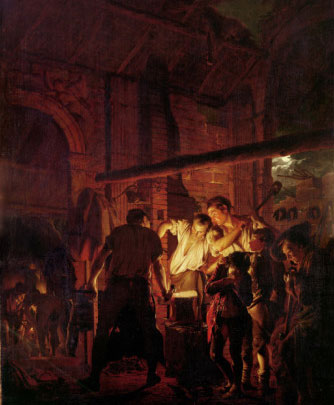
Mine is done mostly plein air and is
about the actual doing of
blacksmithing, the science and skill
of it, which I admire. Mine is calm,
with none of the intensity that
seemed to interest Derby . .
Derby seems to have admired it too,
but there is an atmosphere of almost
Frankensteinian tension is his
paintings ofDerby seems to have admired it too,
but there is an atmosphere of almost
Frankensteinian tension is his
paintings of
forging and Blacksmithing. I am not
sure why, or what he intended, and
it would be interesting to do more
research on him. His blacksmith
seems almost an alchemical
industrialist or magician sort of
figure. He likes to huddle the women
and children the corner, crowding
them into anxious admiration for the
men.forging and Blacksmithing. I am not
sure why, or what he intended, and
it would be interesting to do more
research on him. His blacksmith
seems almost an alchemical
industrialist or magician sort of
figure. He likes to huddle the women
and children the corner, crowding
them into anxious admiration for the
men.
He seems to have been divided in his
attitudes toward science, whereas I
am not. Science and inquiry are the
only way to go. Religion has utterly
failed us.
In any case, the best painting I came across on Blacksmithing was not Derby or Velasquez, as worthy as their works are. This one maybe better, actually. I prefer this painting called Blacksmith, by Jefferson David Chalfant, 1907. It is a good deal larger than mine and so has more detail. I did not use this painting as a reference at all, but like mine it shows the common elements one sees is such a shop. The windows on the barn are great and the flakes of burned off metal on the floor are very accurate. The chimney , barrel and the handles of the hammers are also finely done. there are a few of Smithy's and forges by Stanhope Forbes too, that are quite good.
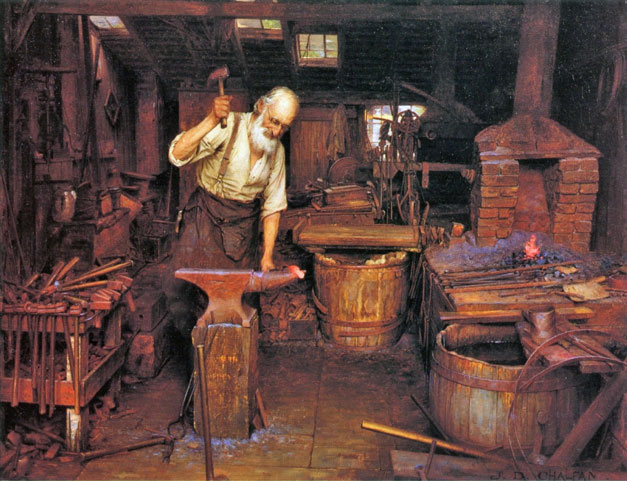
Blacksmith, by Jefferson David
Chalfant, 1907Blacksmith, by Jefferson David
Chalfant, 1907
*****************

"Violin Class", April 2013
My painting of a blacksmith is not entirely an anomaly in my recent work however. I recently did another recent painting that is a picture of an occupation done in admiration of work and artistry. I did my daughter and her violin teacher.
This painting does not belong in the National Park series, but it is a picture that grew out of some of its concerns. This is a very small painting, only about 7x10 inches..

Also when I did the picture of the train station in winter with the bridge last January, I was mentioned my interest in Ernst Meissonnier and Jan Van Eyck, and their amazing ability to draw and paint in a very small or miniature manner. Van Eyck could paint tiny figures with the utmost care and precision, as for instance the figure on the bridge or the town in his Madonna of Chancellor Rolin. You can see part of the town below. Look at the people walking up the steps between the churches. There is amazing detail i all of Van Eyck paintings. I admire this skill just as I admire the work that Marty does.
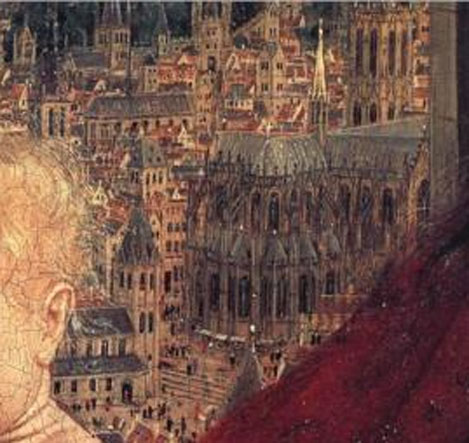

This picture above like the one above it, is the only picture I can think of that appears to be a realistic, even a plein air picture of what it actually looked liked during the 1400's. You can see horses on the bridge and people on foot. The boats lined up against the paved riverbank, This is an amazing piece of work, both as a historical document and a feat of painting. one of the first images I saw that was a tour de force of miniature painting was the Van Eyck in the MET in NYC. The subject does not interest me but the technical brilliance still astonishes even after 550 years since he did it. You can zoom in on the image here:
http://images.metmuseum.org/CRDImages/ep/original/DT25.jpg
********
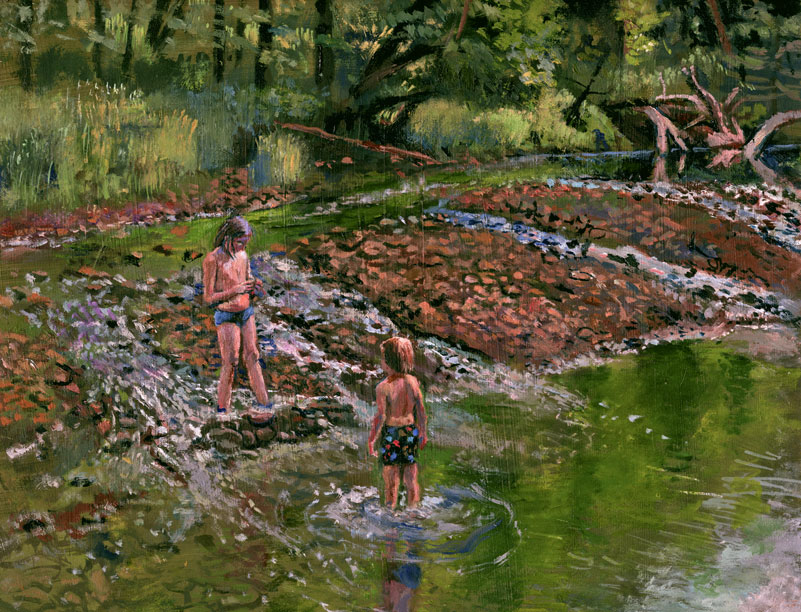
Dam Building
July, 2013 .
Dam Building::
I really do not see that much
difference between all the species
and humans. Our
interdependence with all living
things becomes more and more obvious
as one gets older and really looks
at things. I still think I am
a student, though I am in my fifth
decade now. I had kids because of
birds, as I have said. The two years
I spent at Heroes Wetland really
made me aware of birds and their
babies. The wonderful study I did of
Canada Geese and orioles in the wild
between 1999 and 2001 or 2002 taught
me so much about being a good
father. It is literally true that
birds and animals taught me to love
parenting. So in a way when I paint
my kids in nature I am doing birds
and animals. Indeed, the more
I have studied evolution the more I
see that we have all grown up on the
earth together, and though here are
great difference there is great
unity too. This is the main point of
thee Origin of the Speciess.
Dinosaurs became birds, microraptor
became a blue jay. Speciesism, the
idea that one species is superior to
all the others is a juvenile
anti-Darwinian attitude. Humans do
not "possess" nature as Noam Chomsky
claims in a recent essay. That
is an immature and patriarchal
attitude to nature that has to do
with conquest and machismo, the
illegitimate and unjust powers of
the world. Even the rocks and trees
in my back yard are not mine. I am
merely a caretaker. I try to disturb
as little as possible, to nurture
when I can, and only remove things
like poison ivy that might harm my
kids..
So I really do not see that much difference between all species and humans..So I really do not see that much difference between all species and humans..
Having kids
teaches one the value of nature.
Young deer or chimps playing are
not that different than young humans
playing. I have watched Canada Geese
parents watch their kids and it is
not all that different than me
watching my kids. One problem
with those who study human or animal
behavior is they don't watch wild or
ordinary populations enough.
People like to parse their
differences from animals to make
themselves feel superior, but
actually, a fox mother is no less
admirable that a human mother. She
will risk her life for her kits if
she has to.
My kids are allot like little deer,
chimps or foxes. The love to play.
Over the week or two I did this
painting we went to the creek maybe
four times and another time by
myself. No one was there but us, and
occasionally a train went by over
the trestle bridge. I had to stand
it the stream to do it as my kids
played. The kids were building
a sort of dam so I called i the
painting "Dam Building". My
son is only four so he would not
pose for very long of course, but my
daughter was very helpful. I had to
do most of him from a photo, but
managed to block her in from life. I
find myself experiencing more and
more pleasure in the act of drawing
or painting.My kids are allot like little deer,
chimps or foxes. The love to play.
Over the week or two I did this
painting we went to the creek maybe
four times and another time by
myself. No one was there but us, and
occasionally a train went by over
the trestle bridge. I had to stand
it the stream to do it as my kids
played. The kids were building
a sort of dam so I called i the
painting "Dam Building". My
son is only four so he would not
pose for very long of course, but my
daughter was very helpful. I had to
do most of him from a photo, but
managed to block her in from life. I
find myself experiencing more and
more pleasure in the act of drawing
or painting.
Various painters have done
people in water, Sorolla, Eakins,
Bellows, Rembrandt, and these are
all fine works. But actually I did
not think of these works till after
I did the painting. I love to review
the history of art and think about
it. But in this work I wasn't really
influenced by anyone. My kids are
not always joyful by any means. But
in this work, I was trying to
picture the joy I have in my
children and the joy they have in
their own lives. This is a
picture of ordinary kids playing in
a healthy creek on a lovely day in
summer. The painting it resembles
the most is the Scarlet Tanager
bathing, below. The birds was
bathing on a spot not more that 300
feet down the creek from where my
kids are shown playing. Various painters have done
people in water, Sorolla, Eakins,
Bellows, Rembrandt, and these are
all fine works. But actually I did
not think of these works till after
I did the painting. I love to review
the history of art and think about
it. But in this work I wasn't really
influenced by anyone. My kids are
not always joyful by any means. But
in this work, I was trying to
picture the joy I have in my
children and the joy they have in
their own lives. This is a
picture of ordinary kids playing in
a healthy creek on a lovely day in
summer. The painting it resembles
the most is the Scarlet Tanager
bathing, below. The birds was
bathing on a spot not more that 300
feet down the creek from where my
kids are shown playing.
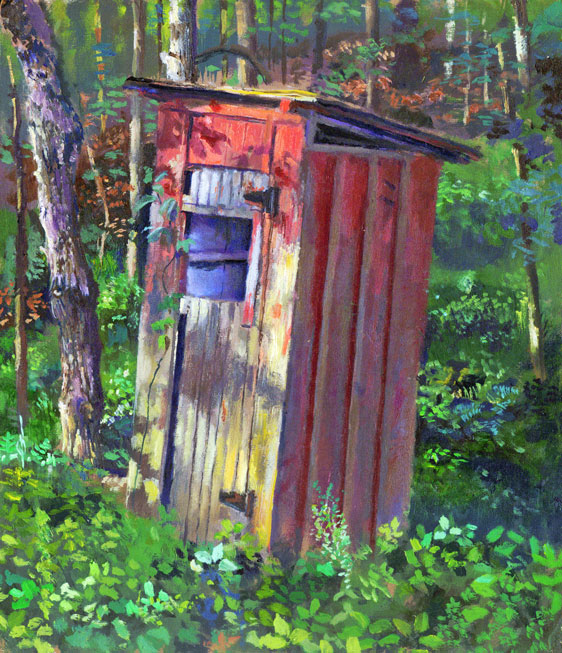
OutHouse
June, 2013
When I showed this to the former
owner of this house, a woman who
used this outhouse for fifty years,
she looked very wistful and thanked
me for seeing the beauty in it. The
park ripped out the barn that used
to be on this property and moved the
outhouse form where it used to be.
So it hovers on the edge of a little
ravine, and there is a low hill
opposite. One of the boards was
broken off the nicely made door. The
hinges are getting rusted and a vine
creeps up the side and poison ivy
and other plants grow beneath it.
Light danced on the front of it as I
worked. It took me quite a few
visits to finish this. It was harder
to do that it looks.
When I showed this to the former owner of this house, a woman who used this outhouse for fifty years, she looked very wistful and thanked me for seeing the beauty in it. The park ripped out the barn that used to be on this property and moved the outhouse form where it used to be. So it hovers on the edge of a little ravine, and there is a low hill opposite. One of the boards was broken off the nicely made door. The hinges are getting rusted and a vine creeps up the side and poison ivy and other plants grow beneath it. Light danced on the front of it as I worked. It took me quite a few visits to finish this. It was harder to do that it looks.
***************
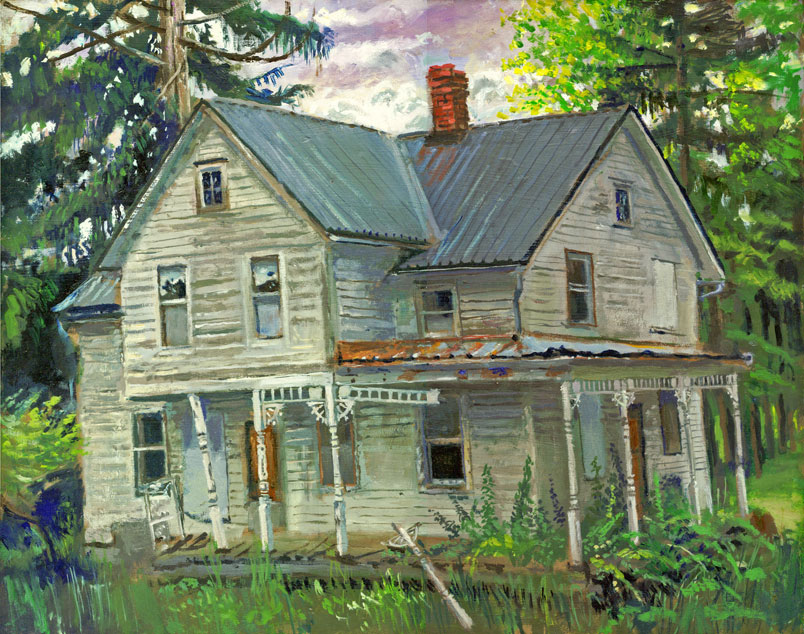
I had been passing
this house in the National Park for
a long time and was always struck by
its age and loneliness and wondered
why it just sat there, abandoned. It
is so strange when a home looks
homeless. I've thought a lot
about the housing market these last
years with so many people being
thrown out of their houses,
foreclosed on by corrupt banks. In
fact, the banks are responsible for
the housing speculations that lead
to the ‘crash’ of 2007. Congress
under the Republicans deregulated
the markets. They helped engineer
overcharging and specious house
loans, defrauding billions from
house buyers. The government is
partly guilty in this flim-flam,
allowing the banks to speculate in
this way, hurting many Americans in
the process. Then the government
allowed the banks for
foreclose on people who had been
charged outrageous and inflated
prices for houses. Some had been
sold bogus and inflated “subprime
loans”, which should never have been
allowed. Banks created 'derivatives'
and other bogus ways to 'leverage'
money into fictional wealth.
So the government hurt millions of
ordinary people on both sides of a
scam that that sent house price
climbing and then plummeting, with
banks and realtors skimming off huge
profits and victimizing millions.
Some of the investment banks, like
Bear Sterns, went bankrupt, due to
their own greed and corruption. More
of the backs should have died. But
the government bailed many
others out, proving yet again that
the government helps the abusive
rich and neglects and abandons the
victimized middle class and the
poor. The banks should never have
been bailed out. People who were
foreclosed on should have been
helped and they weren’t. “Too Big to
Fail” was a lie. It was ordinary
people the government should have
helped and who should have been
bailed out..
So I started looking at this
abandoned house and its graceful
columns and beautiful
old Victorian tracery, as a lost
house, and a dream deferred. I could
see the beauty and love in the
construction. I painted it to
celebrate a time when it was not so
hard to get a house and one could
take great pride in it. I finished
this painting wit foreclosure and
lost homes in mind. I admired the
sadness of the broken porch, sagging
on the left some, and the winter
storm window fell down and off the
porch. After I was done with
the painting and had started the
outhouse on the same land, I met the
sweet old woman that lives near the
house and learned her story. Let's
call her Joe, short for Josefina.
Turns out the house had been bought
by force of eminent domain by the
government in the 1980's and they
had promised to fix it up and make
it part of the park as a place where
a family could live. They have a
program where families live in park
houses and resell farm produce to
locals. But the parks had been
neglected and stinted on by
Congress, since the Republicans wish
only to feed our money to the rich
and starve the National Parks and
education and all things that really
matter. and so this house fell into
neglect and was vandalized. The old
woman who used to live there was
angry at how the government treated
the house she grew up in, rightfully
so. She is a wonderful old lady and
reads books and studies history. Her
favorite politician was Eleanor
Roosevelt, who cared so much for
ordinary Americans. That was my
mom's favorite too . Indeed, there
are few politician who actually
"represent the people" most of them
represent corporations, who are
neither people nor worthy of
representation.………
**********************
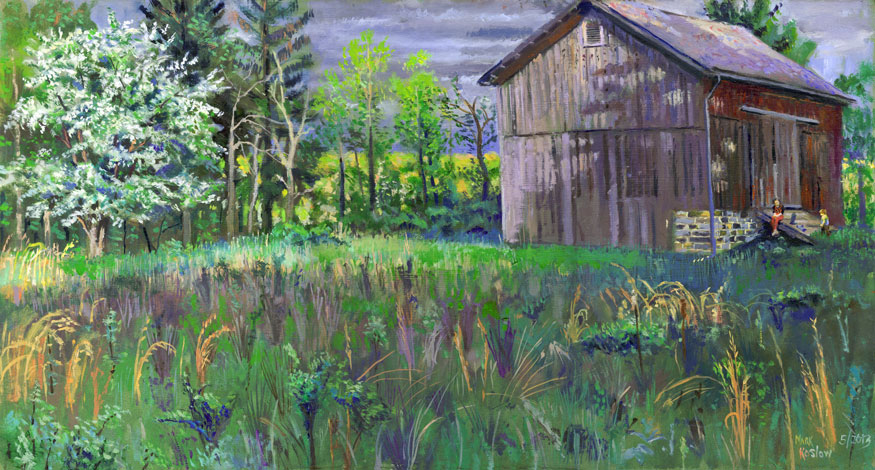
Barn in
Spring and My Kids
I love spring trees, there so much
life in them, and fragrance. The
birds and bees love them too. This
crab apple was full of bees and
flies of many kinds.
I had wanted to paint
this barn for some time too and had
done two other paintings in this
area, one of the woods in November
looking across the Valley and one of
a pine tree in snow. In the one in
the woods looking across the valley
I stood to the left of this painting
down the hill a bit, and in the snow
paint of the pine I stood to the
left of the barn maybe twenty feet.
Deer come and go in this field a lot
and that explains why there were so
many ticks. I got one and my son got
two, but we got them off us before
they did any real damage. The one he
got in his ear was particularly
objectionable. he felt it
there and took it out himself. They
are not insects but rather are in
the arachnid family. I took to
wearing high boots, and we made the
kids wear them too, which is why you
see my daughter’s boots on the
platform up to the barn where she
sits in her socks..
The sun on the opposite
side of the Cuyahoga Valley shines
on the spring trees over there, the
new leaves looking yellow in the
bright light. The sky is grey but no
rain threatening over head. I had
been sick for a month or so
and was now feeling much better. I
was glad to be out painting the
spring light again. Life is short
and celebrating beauty in life
is very much a part of this series.
I loved painting all the grasses in
this field, the light on the old
barn and the glow of the sinking sun
on the far hills. It is hard to
explain to my kids that the light on
the leaves in the center of the
paintings is what their father
thinks life is all about.
Something of the great value of life
is in that light, in the color of
it, in the leaves themselves,
in the fact of existing. Henry
Thoreau called it the "light on a
bank side in autumn", and I know
what he meant. It is nothing
mystical or religious, it is rather
the special quality of being on our
earth, which the early or late
sun suggests at dawn or twilight. It
is such a rich and varied world and
we are part of it and this is a
tremendous thing. Life on earth is
all we have and so light on leaves,
light on water, and and life itself
are precious, even if often
difficult and sometimes full of
problems. It is true that life, like
light, is not a measurable quantify.
Matter has mass and occupies space
and has weight. Energy or light does
not seem to occupy space, nor to
have weight, though it appears to be
affected by gravity. But it is our
world it illuminates, the world
where science seeks to understand
who, where and and what we. The
amazement of life is that it exists
at all and since it does, it is up
to us to inquire and appreciate it,
or not. The sun on the opposite
side of the Cuyahoga Valley shines
on the spring trees over there, the
new leaves looking yellow in the
bright light. The sky is grey but no
rain threatening over head. I had
been sick for a month or so
and was now feeling much better. I
was glad to be out painting the
spring light again. Life is short
and celebrating beauty in life
is very much a part of this series.
I loved painting all the grasses in
this field, the light on the old
barn and the glow of the sinking sun
on the far hills. It is hard to
explain to my kids that the light on
the leaves in the center of the
paintings is what their father
thinks life is all about.
Something of the great value of life
is in that light, in the color of
it, in the leaves themselves,
in the fact of existing. Henry
Thoreau called it the "light on a
bank side in autumn", and I know
what he meant. It is nothing
mystical or religious, it is rather
the special quality of being on our
earth, which the early or late
sun suggests at dawn or twilight. It
is such a rich and varied world and
we are part of it and this is a
tremendous thing. Life on earth is
all we have and so light on leaves,
light on water, and and life itself
are precious, even if often
difficult and sometimes full of
problems. It is true that life, like
light, is not a measurable quantify.
Matter has mass and occupies space
and has weight. Energy or light does
not seem to occupy space, nor to
have weight, though it appears to be
affected by gravity. But it is our
world it illuminates, the world
where science seeks to understand
who, where and what we and others
are. The
amazement of life is that it exists
at all and since it does, it is up
to us to inquire and appreciate it,
or not.
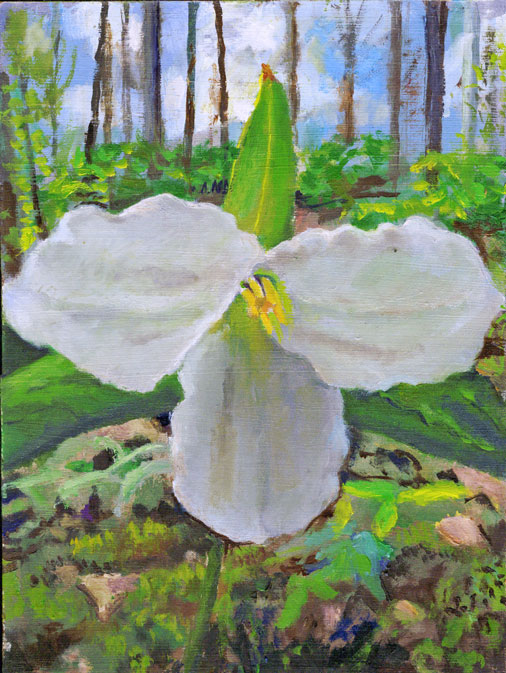 f
f
Trillium in spring. Near Furnace Run creek. It is a lovely plant. When it is not predated too much it can grow into marvelous stands of hundreds of flowers. But a stand of hundreds of them is rare. I have only seen that a few times in my life. Deer consider it a delicacy. Though there may be other reasons it is rarer than it used to be. I have seen deer eat it. But there are places where it continues to grow despite the deer. It would be interesting to study this further. Furnace Run Creek which has plenty of deer, is also one of he cleanest of our creeks. The CRCPO says that
Furnace Run is one of healthiest, intact streams that flow into the Cuyahoga River. Previous work in Furnace Run (1991-1996) indicated that this watershed is in full attainment of biological and water quality standards- which means Furnace Run is meeting Ohio EPA standards. Some sites within Furnace Run exceeded Ohio EPA standards and were noted as “Exceptional Warm Water Habitat (EWH)”. http://cuyahogariverrap.org/ABOUTCRCPO.htmlFurnace Run is one of healthiest, intact streams that flow into the Cuyahoga River. Previous work in Furnace Run (1991-1996) indicated that this watershed is in full attainment of biological and water quality standards- which means Furnace Run is meeting Ohio EPA standards. Some sites within Furnace Run exceeded Ohio EPA standards and were noted as “Exceptional Warm Water Habitat (EWH)”. http://cuyahogariverrap.org/ABOUTCRCPO.html
This may be one reason why wildflowers do so well there, the water is largely free of pollutants. It would be good to see a serious study done of Furnace Run and why species around it seem to do better than other creeks in our area. I also did the Virginia Bluebell painting there, in spring 2012, below.
************************
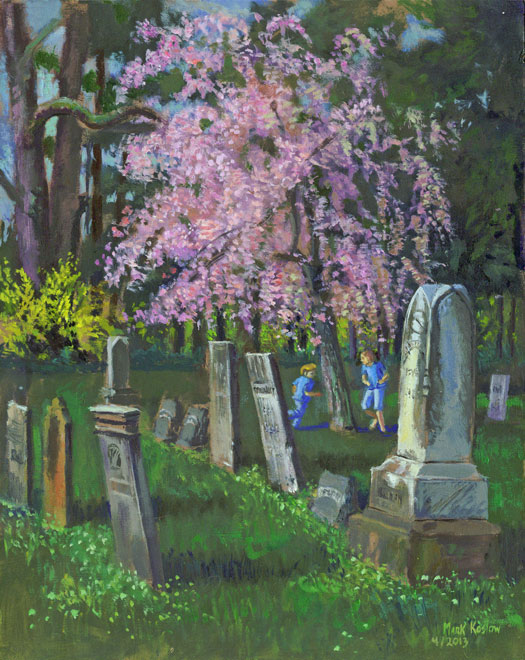
This is April. I had been quite sick and was in the hospital a few times. It got me thinking about dying again, and how much I love my kids. I want to stay alive for them. I had been thinking of painting this graveyard in previous springs because of this marvelous Cherry tree, so much like the one that was at my mother's house, which I loved. But this one is of the graveyard down the street from us. It is very old, with graves back to 1800. I love these old stones, weather by time and rain, snow and sun. The Forsythia grows on the edge of the woods. Maybe because I was sick recently I have a certain affection for graveyards and seeing the kids with such happiness there was marvelous, as I was again saved from death and so very glad to be with my kids,---- I hope for many years yet. We had a few picnics in the graveyard and when the kids had gone the black cat—oddly named Plato--- from the veterinarian next door came and curled up at my feet. Nice to paint with a cat purring curled at your feet. It has been a beautiful spring. I love the spring trees, so much life in them, and fragrance. The birds and bees love them. It is a picture with contradictions in it, certainly, but this is reality and not fiction. Beauty in the midst of so much death and childhood heedless and exuberant, playing while their old man paints, chasing each other around the cherry tree.
The graveyard is not
far from our house. We have
brought the kids there several times
and they are hardly strangers there.
We have taught them to love
graveyards and not fear them. We go
see my mother’s grave once a year at
least, and have a picnic on her
grave and reminisce about her life.
They are allowed to run and play as
they wish. So to them graveyards are
a place of life and not of doleful
death. While I was painting here we
had a picnic too. They played hide
and seek with my wife and it was a
finny and light time. While I
painted this one the kindly black
cat from next door, the opposite of
Edgar Allen Poe’s malicious feline,
came and curled around my legs as I
painted for a few minutes. After
expressing affection for me and my
company, he settled down and slept
leaning against my feet for the rest
of my session. I saw him other days
too as this painting took at least 5
visits. The gorgeous yellow
Forsythia was in bloom and the
Cheery tree, which was the main
object of my painterly attention..
This graveyard has graves in it that go back to 1830, which
is not old by Massachusetts
standards, which go back to 1620 and
are positively young by English
standards, which has graves that go
back to Roman times or before----
but here in Ohio that is very old
indeed. One of the stones is
actually a man who fought in the
revolutionary war in the 1770’s and
died in 1830. I love the character
it he old stones and left some of
the newer ones out of the painting,
just so I cold paint more of the old
ones. The stone takes on a life of
its own, made by what nature has
done to it over the century or two.
The white marble one was leaning a
bit and stained by who knows what
lichens or weathers. Some hands
holding flowers and ones that were
sandstone had obliterated names worn
down worn by wind and rainn
Maybe because I was in hospital recently I have a certain affection for graveyards, Hard to explain this and seeing the kids with such happiness there was marvelous, as I was again saved from death and so very glad to be with my kids,---- I hope for life for many years yet.Maybe because I was in hospital recently I have a certain affection for graveyards, Hard to explain this and seeing the kids with such happiness there was marvelous, as I was again saved from death and so very glad to be with my kids,---- I hope for life for many years yet.
****************
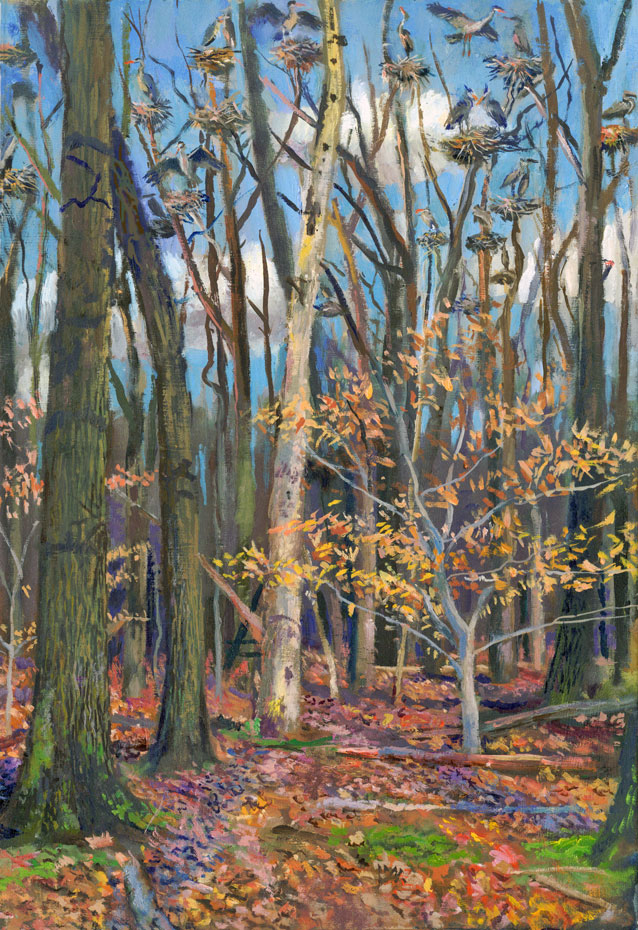
This one was hard to do. It was a half
mile into the woods, which was not bad,
but it is a really wild rookery and very
new. Hardly anyone has seen it, and I
was up on the steep hill, almost a
cliff, over looking the Cuyahoga River,
---a very beautiful dramatic place for
Northern Ohio. But the question was how
to get the trees to appear high enough
without making a very tall painting. I
wanted the March and April ground and
all those leaves and trunks to be in it
too, so the viewer could see how much
in the forest this really us. The small
Beech tree keeps its dead leaves all
winter here. I have always wanted to
paint one. There are a lot of mosses at
this spot and that explains the green on
the ground, ---with all the gnarly
leaves and soil hit by the late sun
coming down behind me where I had my
back to the drop off, which must be
150-200 feet or more down to the river.
Most of the birds were painted form
life, which is not easy to do. For
instance, the bird flying into land on
the nest in the upper right sky was done
over several days and I had to wait to
see many birds assume just that position
to try to paint it. It would have been
easier to work from photos but I
wanted to do it as much as I could from
life. The challenge of painting birds
form life is so rare. Some of the
smaller. more distant birds were done
from photos but as much as I could the
majority of them are done from life. The
trees in the foreground are oaks, and
there was a dead old sycamore, I think.
Anyway, I have never done anything quite
like it. It is perhaps a little crude,
but it had to be really. I could not go
any bigger in size, it is about 10 X 17
". It was a good adventure and one that
had me in the thick of the birds lives
for many weeks. A rookery is such
ordered chaos and the birds croak and
groan like I imagine terradactyls
sounding.
*******************
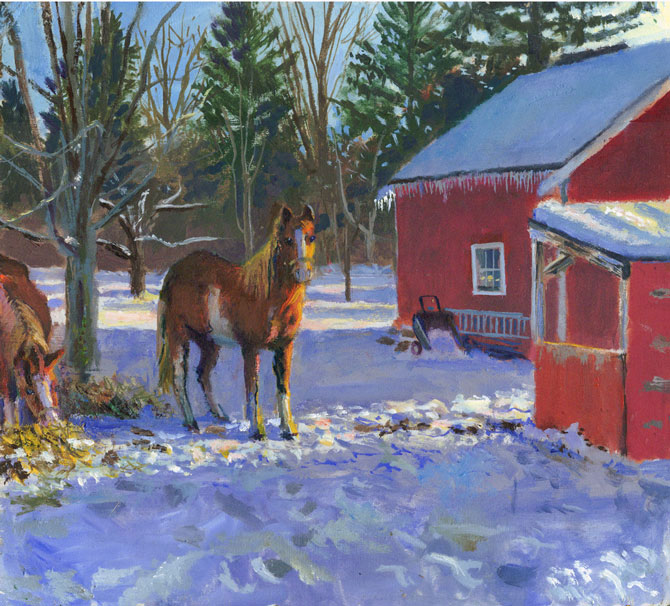
Shirley's Two Horses
This is really part of my second year. It shows of Shirley's horses. She is a neighbor of ours. They are older horses, one of them is 29. I have admired them for some years and wanted to do a painting of them and the Barns and stalls they live in. We are still next tot he national park here. It was cold some of the days I worked on this and the horses rarely cooperated with the pose I had in mind. But I did the best I could form life.
It was certainly a good year, I don't know if it could have been much better actually. There were some hardships in our personal lives, deaths of a dear animal and an old friend of mine died, Lynn Szalay, and other losses, which I have not mentioned. I myself got sick and was hospitalized, but we weathered them as best we could. We were brought much comfort and enjoyment by nature in this this marvelous and under-appreciated Park. To be near this Park is why we moved here and it has paid us back many fold. I have deliberately lived near public lands most of my life. It is hard to imagine life without nature. Nature largely still free in our park systems. Everywhere else nature is under threat by the arbitrary dictatorship of private owners. Life is decreasing and human over population is the norm. But in the National Parks there is an effort to restore ecology and balance. That means life in more abundance for all the species that live there. Outside the parks capitalism rules with its oil spills and foreclosed houses, its wars and rich people who steal from the poor to feed themselves more than they can eat. There is grim reality in the parks too. But at least life is given more of a fair chance. It is that 'fair chance' I wanted to show in these paintings, the wondrous variety and diversity of nature left alone to flourish. That flourishing is the natural state of evolution, and that could be our lives too, if we learned to care for our world better than we do. Human rights will come if we learn to treat nature with the same rights. Watching my own children playing in the natural world, there is no deeper happiness.....
******************
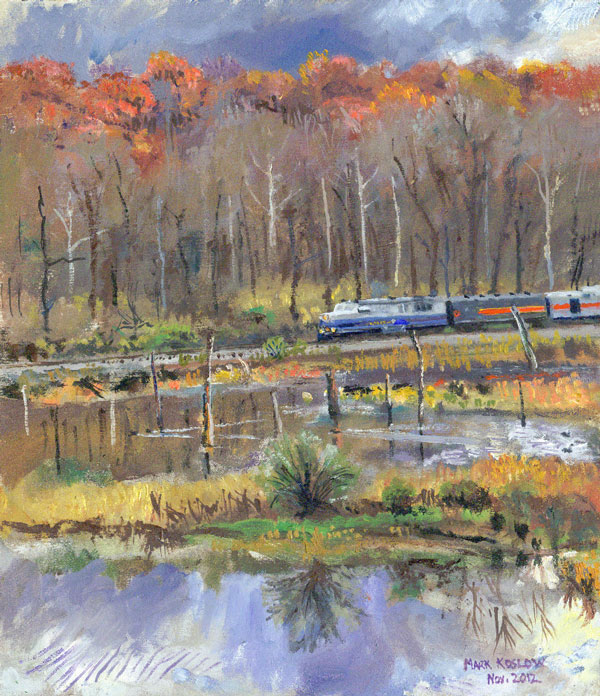
This last one was done during the tropical storm Sandy, which came to Ohio from the east coast in early November. There was a stormy sky and the air currents were weird, with the normally west to east wind reversed and went from east to west instead. The is the view of the Beaver pond which I also painted in the Green Heron painting, above. As I have said throughout this essay, it was a year of weird and usual weather. The fact that corporate greed has begun to even harm the temperature balance of our planet is proof enough that corporations are false and destructive artifacts of the old toxic monarchies. Like the monarchies, corporate culture must be ended. It is not sustainable any more than aristocratic culture was sustainable. The vacuous devotion to meaningless and formal corporate art should stop, as it suggests a kind of complicity. It probably won't, just as corporations will continue to wield their unjust powers, but we have a responsibility to object and spread the word about them. Eventually the corporation will go the way of slavery and the refusal to let African Americans and women vote. CEO's will go the way of Kings and will cease to rule our world unjustly. That is when global arming and the abuse of nature will end.
The train here is number 800. A man who
works in the maintenance yard told me it
is their best engine. Trains save allot
of energy. They use a tiny fraction f
the energy spent on cars and trucks. I
loved trains when I was a kid. We rode
on one in the Second Grade, and sang
"I've been working on the Railroad" and
rode behind a big engine up the San
Joaquin Valley and back. Painting this
train next to this lovely wetland
reminded me of that. I also noticed that
when the train went by none of the birds
or animals I the pond seemed disturbed
by it. It really takes up less space
than cars and highways and does not
pollute the atmosphere and cause global
warming to anything like the destructive
effects of cars. The car and oil
industry and congress got rid of many of
the trains and street cars we used to
have. They should be brought back..
The original reason for doing this
painting was to try to capture the far
Valley ridge and how it turns this
lovely copper/brown/orange color early
in November. It is the Oak trees that
stay this color, when the leaves of the
Sycamores, Willows and Maples are all
down. So what you see here are trunks of
Willows and Sycamores low down near the
river and shorn of leaves and Oaks
higher on the hillside still in
brown/orange leaf. I also wanted to
paint this pond with the sky in it, and
the ducks swimming across it as they
are. But then I realized I wanted to
train in it too..
Once I decided that I was thrown back to
lots of memories from childhood about
train sets I had and played with. My
brother and I even had my Dad's train
set at one point form the 1930's and we
played with that. My brother and I
actually jumped a moving train once,
like a couple of Hoboes, and did not
ride very far, but it gave us an idea of
how dangerous and thrilling that was.
But the most vivid memory was a tiny
train set I had, the only one that was
really mine and my friend down the
street had one of these too and we set
up our sets together one day in his
house. We got our son a little
wooden train set recently and he has
been playing with it all the time. I am
not sure what the fascination with
trains is, but it goes beyond cars and
diggers..
Lastly, I think what this painting
was about finally was space,---- the
space of the rather wild skies we were
having that week. The space of those
huge trees next tot he railroad tracts
that tower over the trains. The
space of the pond. It is actually a
fairly small painting, but it has a
great deal of space in it. Where they is
space there is life, and life is what I
tried to show in all these works, real
life.
*************
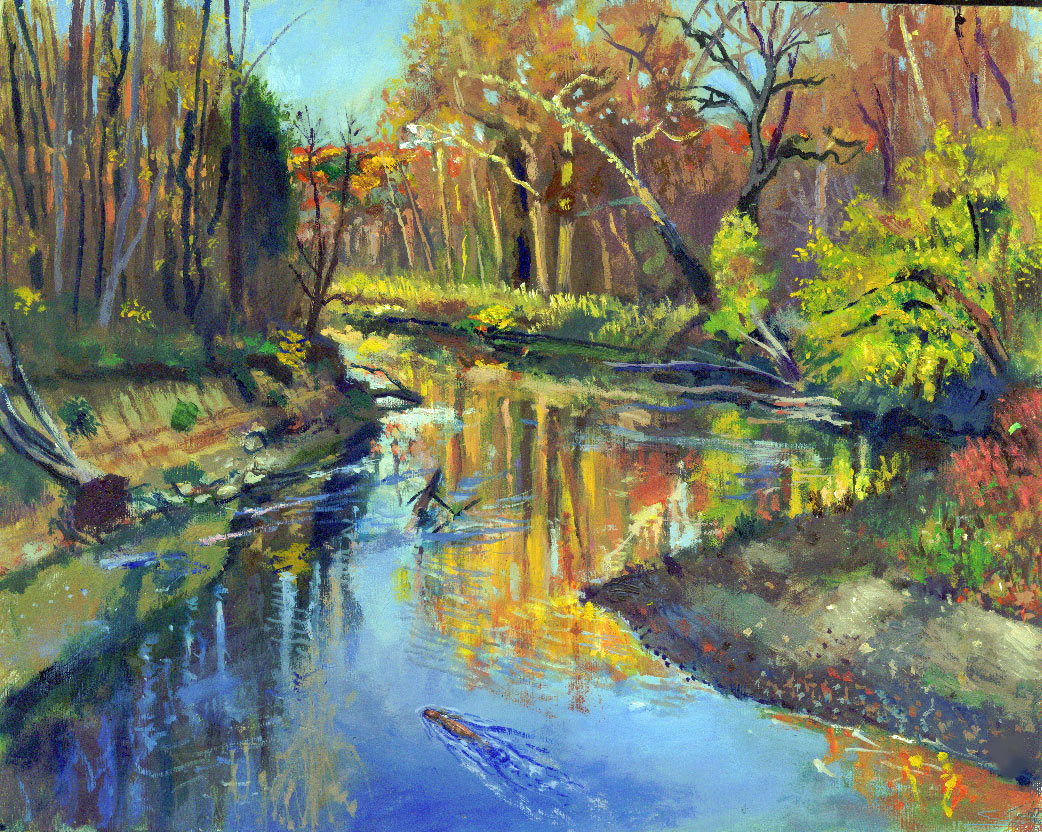
Sad to say, we are coming to the end
of our first year now. In
October I walked down the railroad
tracks a ways and set up next to the
Cuyahoga River again, fascinated by
how the light of late afternoon
played in the water and through the
trees. There was was snag in the
middle of the river of the sort Mark
Twain talks about in his books about
the Mississippi. I think the Yellow
tree, on the right, was an old fruit
free of some kind. Its yellow leaves
slowly died and dropped as I was
working, but again I kept my first
impressions intact. I was standing
in between the railroad tracks and
the river, so that was a little
uncomfortable when the train came by
as it rumbled and creaked so loud.
But the engineer always waved real
nice and he we got used to seeing
one another about 6 O'clock or so..
The sun was on my left and came pretty far
over the trees to hit the opposite
bank. The closer bank had streaks of
light on it that come through the
trees and illuminated a section of
the 'beach', as it were. That is one
of my favorite parts of the painting
actually, ---where that streak of
light passes up over some plants and
into thee rufousscolored or
orange Japanese Knotweed. This
is an invasive plant in this area
too, which crowds out native pants
like thee Phragmitess, but it is
beautiful in the fall..
I like the left bank where you can see the strata
left by generations of rocks or
soils worn away by erosion and the
river. The river really winds around
many double-backs and heads out into
a wonderfully wide area of willows
and cottonwoods created over eons.
If you blur your eyes and look at
this painting from a few feet away
you can see the hints of a far
distant hillside at the end of where
the river disappears. The far
hillside is actually the other side
of the Cuyahoga Valley..
The main subject in this painting is light on the
river or the lessening of it on the
trees. The the middle distance on
the left bank is a tall Sycamore.
Other trees are probably
Cottonwoods, Aspens or Oaks..
The beaver swam by me everyday about
the same time, headed to a bank
lodge perhaps, which I was unable to
see. She would swim down to the
lower left of the painting and
disappear into that area and not
come out. the first time I saw her I
thought maybe he swam down the river
underwater. But that would not
happen twice, probably, so I was
pretty sure she went into a lodge of
some kind.
********************
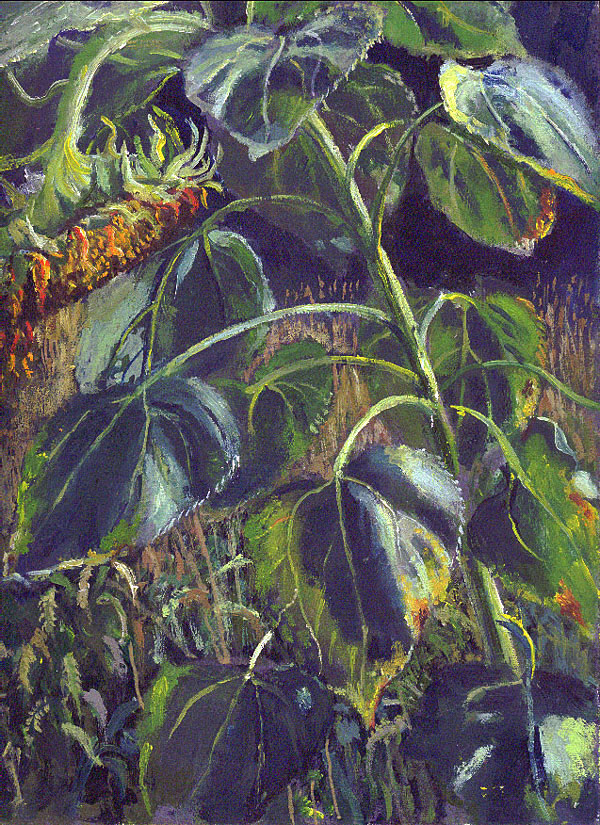
Sunlight on
Sunflower LeavesSunlight on
Sunflower Leaves
There are great
paintings of sunflowers byy
Vincent
Van Goghhandd
Georgia
O'Keefee. But
it is an irresistible subject. I
grew these in my garden from
seeds and they got to be about 9
to 12 feet tall. This is really
more about the leaves than the
flowers. What was most of
interest to me was the light on
the leaves and the way light
passed through them. On the
front leaf there is sunlight
both passing through and
sunlight on the surface of the
leaf, reflecting off the leaf.
This is the situation that Da
Vinci says is too confusing to
paint, but it was not confusing
on such a large leaf,--- it was
very interesting and I like the
result. It gives a feeling of
verisimilitude. I can feel the
weight flower head and how it
pulls on the strength of the of
the stalk..
The stalk seems quite resilient, and
able to withstand the stress of
the constantly bowed and heavy
head of the flower. The leaves
were starting to die by early
September and so I put yellow
brown areas where cell death was
occurring on the edges of a few
of the leaves. Each leaf was a
totally different presentation
of light/dark, tone, color,
form, and perspective..
I was especially intrigued by the space
relationships. I liked the
way the upper ten leaves
revolved around the stem in a
sort of spiral of fan like
shapes, each leaf gathering as
much light as possible without
crowding the light of the other
leaves too much. The sun seemed
to be evenly distributed among
all the leaves. All these
variables made the work a
challenge to finish and I think
I worked on it 6 or 7 times
instead of my usual 4 or 5..
There is a feeling of atmosphere
around the plant too. I like
this feeling of green and full
growth of a North American
plant, strong and hardy, growing
strenuously into the late
afternoon sun. There is a vigor
in the plant and a great need to
put forth that huge flower. We
enjoyed having these this year
very much and they fed many
goldfinches, who loved the seeds
we left for them on the great
seed heads. Maybe even a Pine
Siskin or two showed up, who we
rarely see here..
The woods behind the Sunflower are part of the National Park, though I suppose, strictly speaking, this is not a portrait of the National Park. But it is part of our experience which is so closely bound up with the Park. Maybe in the future, if we can stop the destructive and irresponsible use of lands. Many people like to live in cities, connected to the internet and ceil phones, surrounded by concrete and steel, wires and barrages of advertisements. Unaware of other species besides cockroaches, pigeons, rats, and domestic cats and dogs, they shut out the natural world entirely from their lives. We moved here to be close to the land and love the natural world we live in. It is a source of deep happiness to be close to wild land and nature.
*****************
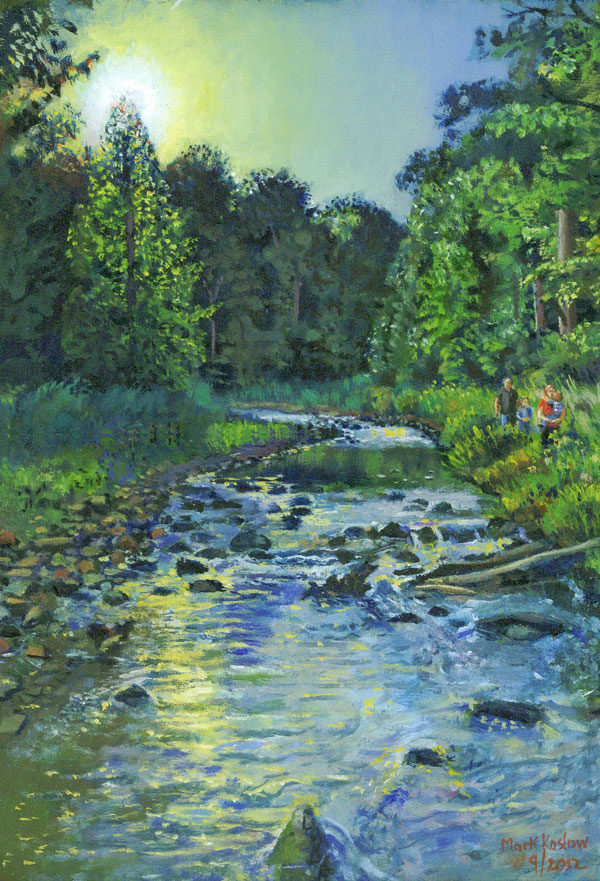
Portrait of the
Sun Over Chippewa Creek
I wanted to have the sun and moon in these works. I spend so much time in my life watching them both. I got to see the Sunspots at the Natural History museum recently when their astronomer let the sun come through their 10 inch telescope onto a white board. I did a portrait of the sun a year or two ago and studied it through Nasa;ss Solar Dynamics Observatory (SDO)).
So for this painting I spent time in August looking for a place where I could do a sun portrait. What I liked about this particular place is how the creek lines up on an east-west axis more or less, so the sun goes down at one end of it and comes up against at the other. Hence the trees are light on one side of the creek and dark on he other side. I liked the symmetry of this as it made the creek itself a sort of solar observatory and reflector. The single tree pointing up to the sun is full of light.So for this painting I spent time in August looking for a place where I could do a sun portrait. What I liked about this particular place is how the creek lines up on an east-west axis more or less, so the sun goes down at one end of it and comes up against at the other. Hence the trees are light on one side of the creek and dark on he other side. I liked the symmetry of this as it made the creek itself a sort of solar observatory and reflector. The single tree pointing up to the sun is full of light.
The kids played around me in the water and out of it, while I was working. These are again tiny portraits of my family from life, except me of course, I had to do myself from a photo. But in this case I was able to actually have my family pose for me for 10 or 15 minutes off and on. My son was in a quiet enough mood to talk with my wife while she held him in her arms. My daughter was making the most lovely of wildflower bouquet's. The figures are less than an inch high so there is not that much detail. Though in this one I was able to suggest the eyes and nose without using a magnifying glass. I suppose as my eyes get worse now that I am in my fifties, proving I still can see the small things is important to me. Young people think their faculties will last forever. But those of us who have lived long enough, know that everything passes away, and even eyesight is mortal and will die one day. I paint these visions against that day and to share my joys and heart aches with other generations, perhaps bringing these days of joy to my children again one day when they are older and have forgotten their childhood and how much we loved them. My daughter likes to tell me that "Daddy I love you more than the universe", before she goes to sleep, I tell her I love her more than the universe too. My son has started saying this too. Maybe what we should say is that I love you as much as the universe, as indeed, it is a wonder-filled place, at least while the children are young. Over the whole face of the earth, childhood is a special time for all species.

Maybe now I can sum up the involvement
of my family in these paintings. I
always wanted to have children. But back
in 1998-2001 I spent over two years
going to
Heroes Wetlandnearly everyday. The result of this
daily contact with the animal world was
profound on my wife and I. I watched the
males and females of many species have
sex, make families and raise their
young. I watched Orioles go
through their life cycle many times. I
saw how thoroughly the female made
the nest and how the males fed the
babies once they came out of the nest. I
saw the babies take their first perilous
steps to climb up a tree from the
ground. I watched males teach young
orioles how to catch bugs. In late
summer young birds form into flocks with
parents and there is allot of learning
and education that goes on. Robins and
Grackles could be seen in the woods in
such flocks. I watched how female Wood
Ducks worry about ducklings, with good
reason too. I watched similar activities
with Canada geese over many years. I saw
a Goose more or less lose her mind when
her eggs did not hatch after 35 days of
sitting. Indeed, I do not know that I
ever had a more profound educational
experience than learning from other
animals how to be a parent..
I saw concretely that the lives of animals
are no less precious to them than our
lives are to us. I always wanted to be a
parent but seeing animals parent
convinced me of the utter joy and
goodness of it, as well as he hardship
and suffering involved. Life on earth
offers no deeper and richer thing than
having kids..
I learned both how to love children
and how to care for them from watching
animals and how they treated their
young. But also I learned this from my
mother who had Alzheimer's. We cared for
my mother for 10 years and she had an
advanced dementia for 5 of those years.
She lost the ability to speak and
eventually walk and even use her eyes.
I become her father and her primary
caretaker. What I learned from animals
helped me enormously in the car of my
mother. It is accurate to say that
birds, mammals and my mother taught me
how to care for children. I am far from
a perfect parent, but parenting is not
about perfection, it is about teaching
children about how to love what is
loveable on earth and to deal with
reality and how to survive and even
prosper in a difficult and sometimes
painful world..
My children are old enough that I can
bring them into the natural world now
and they can begin the life long
learning that only nature can give us
about how to live on earth. I doubt
there is a better education than
prolonged study of nature, up close and
in the company of those who love nature.
This is not to say that one should
neglect Algebra or Physics, but that all
of knowledge really has its origin in
the natural world and our relationship
to it. Darwin, Da Vinci, and Dewey
understood this. Life is short and we
began to share the natural world with
our kids as often as we can. My children are old enough that I can
bring them into the natural world now
and they can begin the life long
learning that only nature can give us
about how to live on earth. I doubt
there is a better education than
prolonged study of nature, up close and
in the company of those who love nature.
This is not to say that one should
neglect Algebra or Physics, but that all
of knowledge really has its origin in
the natural world and our relationship
to it. Darwin, Da Vinci, and Dewey
understood this. Life is short and we
began to share the natural world with
our kids as often as we can.
*********************

In the hot months of July and August, We sometimes take the kids down to various creeks in our area, which are shallow enough that they can get cool and wet without there being much danger of drowning. Once at such a place, I spied a popular bathing spot among the local birds. Often if one bird likes a given spot for a bath, other birds will imitate. I have even seen Redtail Hawks come to bathe at a spot where Goldfinches were a minute ago. On this day in July it was again Goldfinches that I saw first. Soon there were other birds, some Sparrows and at one point, a Scarlet Tanager. I have wanted to do a picture of birds bathing for years.
Now I must say a few things about Scarlet Tanager's in our area. They are very rare. The first one I saw, many years ago was in North Chagrin Reservation. It was very far away and we could only identify it with binoculars. I later saw one up close in Allegany State Park in New York. They were eating some Honeysuckle berries. Later I saw a 3 or 4 of them, all males, together in early May in France Run. That was the first time I photographed them. This painting is loosely based on a photo I took a few years ago in July 2010.
In his novell The French Lieutenant's WomannJohn Fowles notes about birds as follows: "The appalling ennui of human reality lay cleft to the core; and the heart of all life pulsed there in the wren’s triumphant throat" Fowles sees in humans as in birds have this amazing capacity of life, apparent in their songs, which we all admire. Fowles sees the heart of human and avian reality as about love of life, despite all the boredom and horror that exits in the world. Like these paintings, the songbirds song is the song of life, the song of family and the need of one's own place, one's own locale in the world, a place where children my grow, life prosper and the sun shine equally on everyone.John Fowles notes about birds as follows: "The appalling ennui of human reality lay cleft to the core; and the heart of all life pulsed there in the wren’s triumphant throat" Fowles sees in humans as in birds have this amazing capacity of life, apparent in their songs, which we all admire. Fowles sees the heart of human and avian reality as about love of life, despite all the boredom and horror that exits in the world. Like these paintings, the songbirds song is the song of life, the song of family and the need of one's own place, one's own locale in the world, a place where children my grow, life prosper and the sun shine equally on everyone.
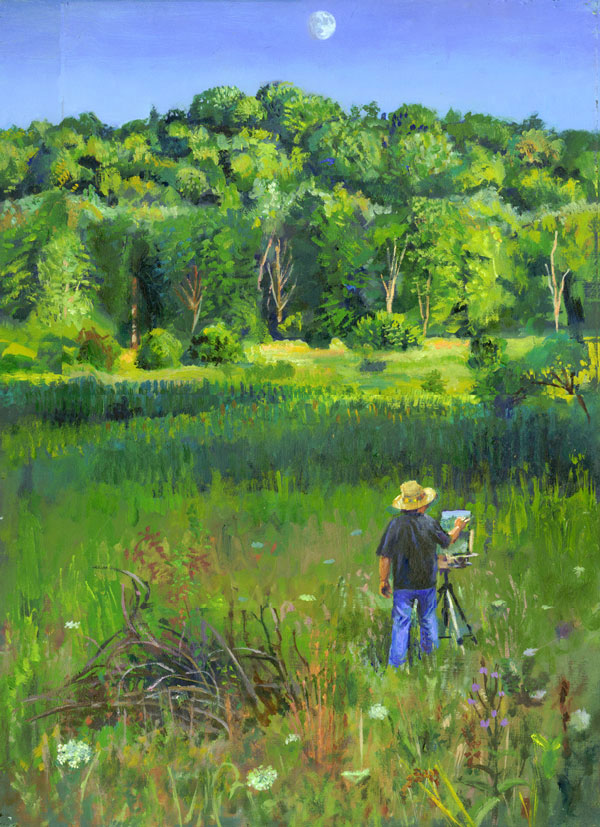
Studying Green at Moonrise, (self-portrait)
Beginning with the Beaver painting at CVNP, above, I spend most of the summer studying variations on the color green. One of the goals of thesummer was to understand green better. it is a much neglected and abused color by many artists--- for instance, I once heard or read that the artist Robert Bateman said he does not like the color green, indeed, he said it made him sick. It seemed silly for an artist not to like any color, much less one as common as green. I have always thought all colors are wonderful. But then most of Bateman's paintings contain copious amounts of dull grey, for reasons unknown. i asked him once and he relied that that grey is "him", whatever that means. I follow my kids who sometimes have said when asked what their favorite color is, I answer, 'my favorite color is "rainbow".' No doubt there are places in the world where there is little green, places such as deserts, the Arctic, or the middle of the ocean. But wherever there is abundance of life on the earth there is a saturation of green. When I say green I really mean the whole panoply of colors, not just the mysterious Chinese green or of the green of jade, olive greenh, Peacock green , Malachite green or the greens of Ireland, but perhaps these were not far away either.When I say green I really mean the whole panoply of colors, not just the mysterious Chinese green or of the green of jade, olive greenh, Peacock green , Malachite green or the greens of Ireland, but perhaps these were not far away either.
The more I look at it the more I see in green. I
remember the first time I thought about green in
isolation was when I saw a painting by George
Inness, perhaps 35 years ago. The name of the
work iss
"Gray, Lowery Day"",
1877. It is a marvelous array of the most
varied green vegetation I can think of, and some
ducks in a creek. It also hands in my mother's
college, where she spent four of the happiest
years of her life, so very likely she saw
this work. There are other works by Inness and
Monet that really liberate green from the dreary
green used up until Inness and Monet. And then
there were some Pre-Raphaelite works whose use
of green is new and marvelous for their time.
The marvelous greens in Milliet'ss
Ophelia
or Hunt'ss
the Hireling Shepardd,
where the green shadow of the trees illuminates
the sheep, for instance. The background of such
greens if of course in the Celtic green of the
Ancient past, a green not yet put under the
plow, the green of life in the British isles
before Christianity started squeezing life under
the veil of repression and priests. Green was
the color of life then, the color of what
matters, the color of Spring and Summer and the
Maypole festivals, life celebrations, the
Midsummer Nights Dream. John Fowles summarized
this greenness of being as symbolized by the
"Green Man", a pagan figure still picture in
some British churches and a sort of hypertrophy.
I am not inclined to symbols anymore. But having
lived in England I know what green Fowles talks
about in his writings. Blake did not praise this
"green and pleasant" land for nothing. The
greens of Ohio are not too much less spectacular
than those of England, indeed, they are even
denser and more plentiful and less relieved by
island clouds and cultivated fields everywhere.
The greens of Ohio are wilder and taller in tree
and shadow..
But yet the I
was not trying to evoke these magical greens in
my paintings. i was trying to evoke the magic of
real greenery that lives in actual trees and go
back even before the ancients festivals to the
origins of evolution itself, before culture
starts to deform reality. Leonardo was afraid of
green and specifically cautions us against
trying to paint sunlight falling through leaves,
because it was too difficult to do. He only
wants us to paint the sun side of leaves, and
not stand behind the tree and painting it from
the shadow side, as I do in the painting below.
Leonardo was was right it is difficult to do
this but, it is precisely the transparency and
very absorbent nature of leaves that makes
leaves to stunning and interesting to me. Leaves
are the veritable face of life, without them
there is no life at all.
So what I was driving at in my
study of green in these works was an inquiry
into the evolution of green. So what is the
evolutionary function of leaves? We know that
leaves were adapted to accomplish the task or
process of photosynthesis for trees. For years I
have been looking at leaves as light gatherers,
which they are of course, but only lately have I
come to understand another function. They are
darker than I used to think. The green is
vibrant but if you look at plants in reaction to
the sky they are markedly darker than the sky.
The intensity of the green color does not
increase the dark tone of the color. Indeed,
seen against the sky tress are invariably dark,
often nearly black, as in my second Goldenrod
painting at the top of this essay. The dark
green of the leaves is absorbing precisely
because it is dark and the green of trees is
really the color that maximizes light gather
from the sun. The ability to absorb more
light from the sun helps the trees do
photosynthesis more effectively and thus
synthesize or obtain more food. Since
human would hardly exist if it were not for
pants and green, it seems quite fitting to
contemplate why green is so ubiquitous. Far from
being sick of greens, I want to celebrate it and
enjoy it infinite variations, from black jade to
milky celadon, and mustardy -olive to emerald
and opaline green..
There was Vervain at this site, which is
hinted at in the lower right and Queen Anne’s
Lace. I love the latter, a plant in he
carrot family. Obviously, my wife took a photo
of me so I could put myself into the painting.
I could not very well paint myself in this
position from life. I love Plein air work and I
wanted to show what is actually like to stand
for hours in these environs..
The
title The
title
Studying Green at Moonrise,
(self-portrait) is a little cumbersome, but
it makes the point I wanted it too. It was
wonderful to study the green of our world. The
moonlit greens of twilight take on a certain
Alpenglow from the luminous air.
But all this beauty has its problems too. Unfortunately there is some Mulitflora Rose at this site, another invasive plant and my son, who is only three, cut his eyeball on a thorn. We rushed him to the ER and had it looked at. It was fine and he healed quickly. But the experience taught us again how dysfunctional or health care system is and how the whole system is corrupted by Insurance companies, who are parasites of the system. They are not needed at all, and should be eliminated. It is unethical to profit from people's sickness as they do. They exploit and gouge and do all the can to take your money and give as little care as possible. So from the moonlit greens of wonderful summer days to the horror of the American health care system, such is our lives, and one must face the truths of each day as they arise..
In any case, this painting is one of three that I did at this site ......here are all three: In any case, this painting is one of three that I did at this site ......here are all three:
*****
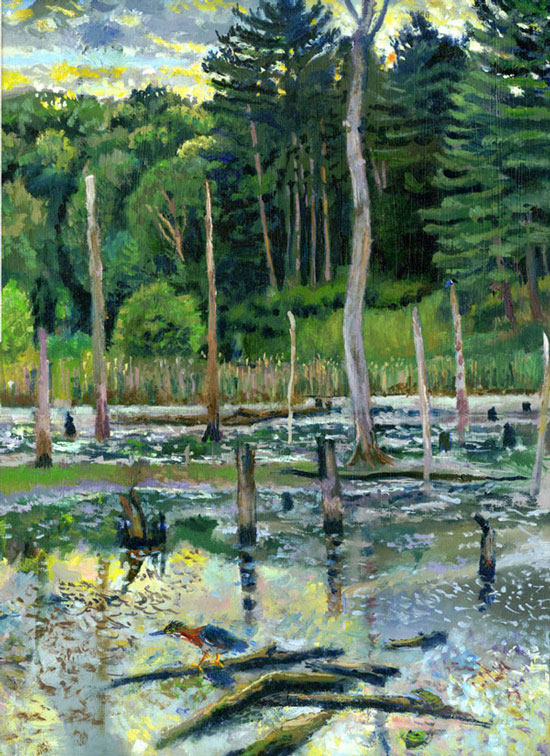
Green Heron's World
The first is a study of the pond that is close to us, there is a beaver pond on the far side of it. You can’t see that in the painting, however. I wanted to do the wetland and the White Pines in the distance with the summer trees on the hill beyond that. The Green Heron is not form a photo, but was more or less invented as I have seen them in this position. I put a tiny painting of a kingfisher on one of the snags and i Leopard Frog and a Bull Frog up closer . The frogs are miniature again, and are actual life size as seen here.
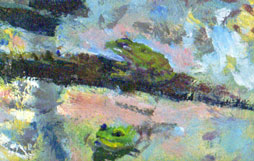
This is another attempt to celebrate the color
green, as well as sing a song for wetlands. Wet
areas create so much life in and around them
they are irresistible to anyone who loves life.
I suspect that is the real fascination that
fisherman have with such places, though they
express it is a twisted way, needed to kill and
eat what they love. So I stood down below the
railroad tracks that you can see in the painting
of the train below. I painted for a week or
more, my wife and kids came with me every time
because they love it here and the kids got to
chase frogs and play with sticks and mud. We ate
veggie dogs on the railroad tracks and went for
little walks together to explore the surrounding
area. We waved 'hi' to the engineer as the train
rolled by full of passengers. When I asked my
wife a few nights ago what this year of painting
nature meant for her, she said it was great for
the whole family: we were outside so often
together and got to know all these places
so closely. It brought the kids closer to the
natural world and all of us closer together..
The pond was drying up in the
drought we had this year and by the time I
finished this painting at least half of the
water you see here was gone. I blocked in the
water the first and second afternoons. I kept it
at that height. The pond was drying up in the
drought we had this year and by the time I
finished this painting at least half of the
water you see here was gone. I blocked in the
water the first and second afternoons. I kept it
at that height.
There was a pair, with a young one, living at this pond and they would fly around me or fish across from me. The logs in he foreground were where the Green Heron was going to go into the painting. Painting the Green heron from Memory was a challenge. I have tried this on other occasions, especially at Life drawing and painting sessions. There is an interesting 19th century book by Horace Lecoq de Boisbaudran, (1848) in the public domain that you can down load or look at heree.
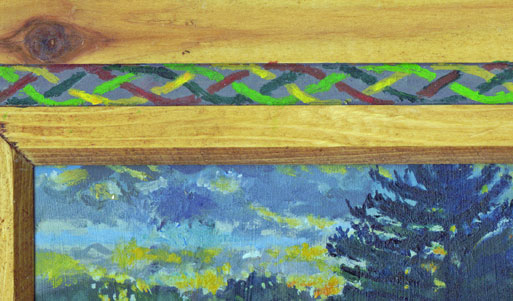
The Border of this painting is a Celtic Braid, not quite a Knot design.
Having been in the Green Isle of Ireland myself years ago and being mostly Irish, I can't resist such designs. I used it to try to illuminate an aspect of these paintings that is about the the wonder of the natural world and animals and us in it. The undulating colored lines evoke the ocean,or the Shannon or Cuyahoga Rivers and call forth sun and grasses, grey clouds, ferns curling and braids in a woman's hair.
Lastly you can see the attempt to paint a tiny Kingfisher from life on the second tall snag form the right side of the painting and mid-way up. The Kingfisher was there looking for frogs I presume, for a few minutes. I had just enough time to put down some tiny brushstrokes and block him in.
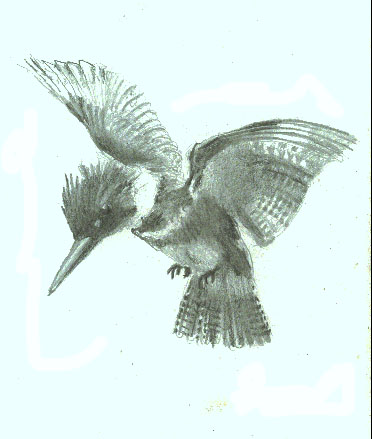
Kingfisher.
Graphite
drawing, Oct
2012
If I do use photos to help my art I like to
use my own. I am not a photographer in the
regular sense, but for years I have been
making images that are more documentary and
sometimes aesthetic with cameras, both video
and still. I see cameras as an extension of
sketchbooks or notebooks. So at
various points my wife and I were trying
very hard to photograph kingfishers. We had
bad luck, the bane and friend of all
photographers. We even located some nests on
the Rocky River and attempted to hide in
bushes, and watch as the Kingfishers came to
feed their babies inside the long tunnel
they build in the bank of the river. The
babies live in a nest of fish bones deep in
there. One can here them chattering and
crying when the parents are near. Though we
got a few distant photos and some video
nothing much came of all are efforts..
In later years we have tried again and still with
no good luck. So recently, a few months ago,
while my kids were playing at the Natural
History museum here, I spent an hour or two
drawing one of their taxidermized exhibits.
It is very nicely done, showing the bird
in a lovely hovering pose just as I have
seen them above a river looking down at a
possible catch in the water. So this small
drawing is a study of a kingfisher such as I
had wished to make in previous years but was
unable to for lack of a good reference of my
own making. In later years we have tried again and still with
no good luck. So recently, a few months ago,
while my kids were playing at the Natural
History museum here, I spent an hour or two
drawing one of their taxidermized exhibits.
It is very nicely done, showing the bird
in a lovely hovering pose just as I have
seen them above a river looking down at a
possible catch in the water. So this small
drawing is a study of a kingfisher such as I
had wished to make in previous years but was
unable to for lack of a good reference of my
own making.

Montaropa Uniflora,
Indian Pipe
This painting is of a similar
environment to the image far above of the
Red Squirrel in the woods: both depict damp
woods and a fertile and humus rich leaf
litter. This is July and is based on a photo
I took in Allegany State park in New York
State. But it could be many places in Ohio
or Cuyahoga National Park too. I did this
painting this year so include it here, even
though it is not of CVNP. We saw the Indian
Pipe in a Pine and Oak woods. Indian Pipe
used to be called a saprophyte, but this has
been changed and now is is held to be in the
Heath family (Ericaceae) which have an
unknown or "parasitic" relation to
mychorrhizal fungi. The relation to fungi
appears to be unknown so I hesitate to use
the term 'parasitical'. They are also
somehow related to host trees like Oaks
though the fungi, but it is not very clear
to me just how this works. In any case they
are fascinating plants, perennials which do
not have chlorophyll and do not do
photosynthesis, and yet have seeds like
other angiosperms. They can live in the
dark. It is related to the Sugarstick or
Candy-stick (Allotropa virgata) and Pinesap
(Monotropa hypopithys). We got to know the
candy-stick a little in California. We even
found a little restaurant called the
Candystick, devoted to it, in Fortuna,
California. This is a separategc area of
study all to itself, and it would be
interesting to pursue this further.... This painting is of a similar
environment to the image far above of the
Red Squirrel in the woods: both depict damp
woods and a fertile and humus rich leaf
litter. This is July and is based on a photo
I took in Allegany State park in New York
State. But it could be many places in Ohio
or Cuyahoga National Park too. I did this
painting this year so include it here, even
though it is not of CVNP. We saw the Indian
Pipe in a Pine and Oak woods. Indian Pipe
used to be called a saprophyte, but this has
been changed and now is is held to be in the
Heath family (Ericaceae) which have an
unknown or "parasitic" relation to
mychorrhizal fungi. The relation to fungi
appears to be unknown so I hesitate to use
the term 'parasitical'. They are also
somehow related to host trees like Oaks
though the fungi, but it is not very clear
to me just how this works. In any case they
are fascinating plants, perennials which do
not have chlorophyll and do not do
photosynthesis, and yet have seeds like
other angiosperms. They can live in the
dark. It is related to the Sugarstick or
Candy-stick (Allotropa virgata) and Pinesap
(Monotropa hypopithys). We got to know the
candy-stick a little in California. We even
found a little restaurant called the
Candystick, devoted to it, in Fortuna,
California. This is a separategc area of
study all to itself, and it would be
interesting to pursue this further....
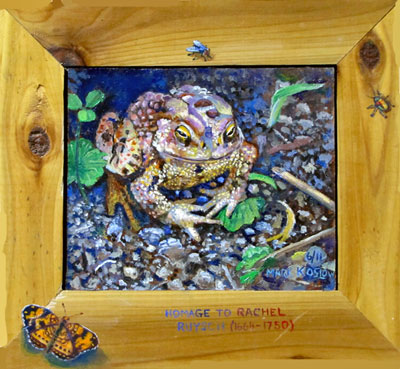
Homage to Rachel Ruysch,
(1664-1750)
This was done a year earlier than
the previous painting. This
Toad was in our garden for a few
weeks. We grow Tomatoes Squash,
Zucchini, Strawberries as well as
other vegetables and flowers. I have
studies Toads to a degree. I used to
often see them at Heroes wetland
where they had a sort of singing
convocation in the spring. Toads
have surprisingly elegant and lovely
singing voice, as you can hearr
here if you
wishh.
I did this little vignette of the Toad as an
homage to a great woman painter who
painted around he time of Rembrandt,
De Hooch, and Vermeer. Indeed, what
this painting is about is my own
predilections. My interests
have turned increasingly toward
science in recent decades, with
increasingly skepticism toward myth,
religion and even poetry, insofar as
poetry serves irrationalism and
myth. The Dutch realists, along the
with French and British Realists and
Naturalists of the 1900's as well as
Da Vinci have held a lot of interest
form me this year. In all these
cases I admire the devotion to
reality as well as a certain
advancement in inquiry and social
consciousness that all these artists
stove to accomplish.
Rachel Ruysch was a great and early
woman artist in Holland. Her
teachers were her father,
Willem Van Alest and
Otto Marseus Van Schrieck.
These men together with Rachel, and
others were among the first science
painters and naturalists and began
the process of rejecting religion in
art. Her father was a scientist, a
botanist and anatomist, remembered
for his developments in anatomical
preservation, as well as some
discoveries about the lymphatic
system, snakes and the eye. In 1693,
Ruysch married the painter and lace
dealer Juriaen Pool. She had ten
children and this did not stop her
production of paintings, indeed, it
seems to have accelerated it. One of
the most prolific women in history
who was creative both as a mother
and an artist. She finished her
final painting in 1747, when she was
83. There is great love of
life n this woman..
Some of her Some of herpaintings are said to be allegories,
I don't think I accept that myself,
or perhaps she did that because it
was in fashion at the time. Hardly
anyone escaped religion then, and it
was dangerous to try as Descartes'
career shows. Van Schrieck and
Willem van Aelst were both are more
naturalist that religious, indeed in
the context of the time they are
very progressive and Rachel for me
stands out as a bright early light
of both women's rights and
scientific naturalism. She appears
to have followed in her father's
footsteps too, who was a devoted
scientist..
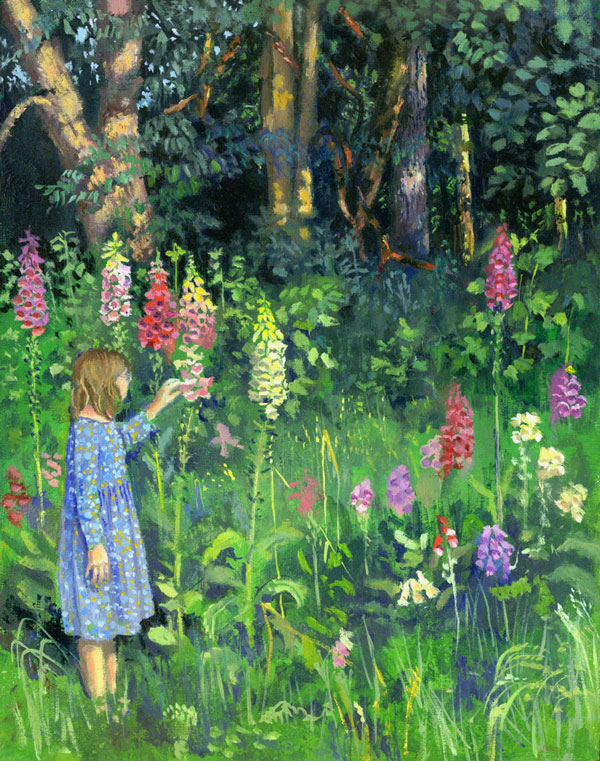
My Daughter and
Foxglove. June 2012
June: 2012 The land behind our place is overlapping jurisdiction, part Metropark and part National Park. So the woods in the painting are actually in park. I loved painting the light playing on the trees back in the woods. I suggested some of the space relationships between the boughs of leaves. It is a mile or so to the other side of the park from our land and you can sense that distance in the upper left of the painting. There is a tangle of red grape vines in the woods. My daughter delicately touches a flower, amazed at its color and shape. She actually posed for a a short time while I did the drawing of her. She is curious and studying the flower heads which are exactly her height. At age seven this is an image of perfect consciousness and life, as yet untroubled with the tragic power struggles, yearnings, failings and losses of the adult world.
I love Foxglove (Digitalis purpurea) . I
was hesitant to plant it as it is
invasive in California, Alaska and other
states. I have not been able
to find it's status in Ohio, but I do
not see it on the roads and read it is
invasive mostly on the coasts. It is
poisonous to humans so it is not near
the house. It is way out back near the
woods. I loved painting my young
daughter next to it. It is used as
a heart medicine in some cases. I have
never used Digitalis but certainly my
daughter has been a medicine for my
heart, so I enjoyed pairing her with
this flower.
My daughter showed interest in bows
and arrows, so I made her one in June,
the same month I was doing this
painting. The fireflies came out then
too. She loves to catch and release the
fireflies, figure out if they are male
or female, and watch their cold,
greenish-yellow light in the magic of
twilight. We spend lots of time in the
twilight back yard watching the Brown
Bats come out and fly and the Fireflies
dancing in our fields. This year my son
joined in this too and we all were out
there catching Fireflies and letting
them go. I have wanted to paint that
too, but have yet to imagine how..
Her interest in these activities called
forth a certain poetry of greenness,
innocence and flowers and in my mind.
The green I was thinking of has a
springtime hint of that suggests the
Elizabethan miniatures I have seen in
various museums i the US and UK. There
is a certain naturalism in some of these
portraits, a certain botanical 'grace',
You can see hints of this, for instance,
inn
Nicholas
Hilliard's "Young Man among Roses""and there are 19th century English works
that echo this love of flowers and
innocence, such as William Homan's
Hunt'ss
Ourr
English CoastsEnglish Coastss,or Sergeant'ss
Lily, Carnation,
Lily Rose.
These two paintings are two of the best
paintings of the 1900's, in addition to
being the best of these artist's works.
I did not think of either of these when
I did my portrait of my daughter, but I
think I so internalized both works in
previous years there are echoes.When I lived in England in the 1980's
these were my two favorite works and I
went to see them again and again at the
Tate. Together they summed up for
me what is fair and loveable about
England , in terms of its land, its
light, its Springtime and it people's
love of gardens, coasts and flowers. I
doubt that is any people on earth as
loving of flowers as English..
This romance of roses and gardens can also be
felt especially in the lovely textures
of language in Shakespeare's playy
Romeo and Juliettorr As You Like
Itt. The Forest of Arden suggests a
special green, a green that is very much
the green of May or spring.
In this painting I tried to
capture something of that late May or
June green, of new life and hope for a
great harvest, such hope as I place in
my beloved daughter..
This is the first of the "green paintings" of this
year,--- as I will explain later I spend
allot of time thinking bout the color
green and its many meanings and
evocations.
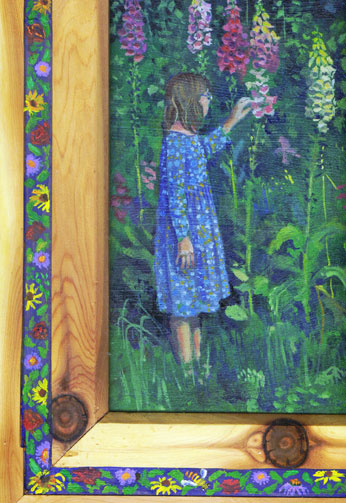
I have spent time designing and hand making frames for some
of these paintings. I worked with
Oriental rugs, doing repair and
restoration between 1982 and 1990, and
that gave me a love of these objects of
craft. I particularly liked the one I
did for this painting. It was actually
based don a Persian carpet I
photographed long ago in 1982. In the
carpet there are green leaves on an
ultramarine background and then white
birds and orange cartouches. There was a
poetry in Iran at one time that had
carpets as one of its special creations.
I have always admired the design skill
of the makers of these rugs, mostly
women. But in addition to the evocation
of carpet design I added to this
border a certain feeling that comes form
the Elizabethan poetry and English
gardens. I wanted to celebrate the love
of my dear daughter with an evocation of
Kew Gardens in England, where I spent
many fine days in May and June, as well
as my own poor attempts at gardening. I have spent time designing and hand making frames for some
of these paintings. I worked with
Oriental rugs, doing repair and
restoration between 1982 and 1990, and
that gave me a love of these objects of
craft. I particularly liked the one I
did for this painting. It was actually
based don a Persian carpet I
photographed long ago in 1982. In the
carpet there are green leaves on an
ultramarine background and then white
birds and orange cartouches. There was a
poetry in Iran at one time that had
carpets as one of its special creations.
I have always admired the design skill
of the makers of these rugs, mostly
women. But in addition to the evocation
of carpet design I added to this
border a certain feeling that comes form
the Elizabethan poetry and English
gardens. I wanted to celebrate the love
of my dear daughter with an evocation of
Kew Gardens in England, where I spent
many fine days in May and June, as well
as my own poor attempts at gardening.
One other detail about doing this painting....I saw a rare Yellow Billed Cuckoo above me while I was working on the this. I am a pretty good birder, but do not seek out the rare for the rarity sake and I have never been a lister. But it is marvelous to see a bird one has never seen before. The slow awareness came over my brain as I went though my memory and finally realized that that characteristic tail would only be one thing.
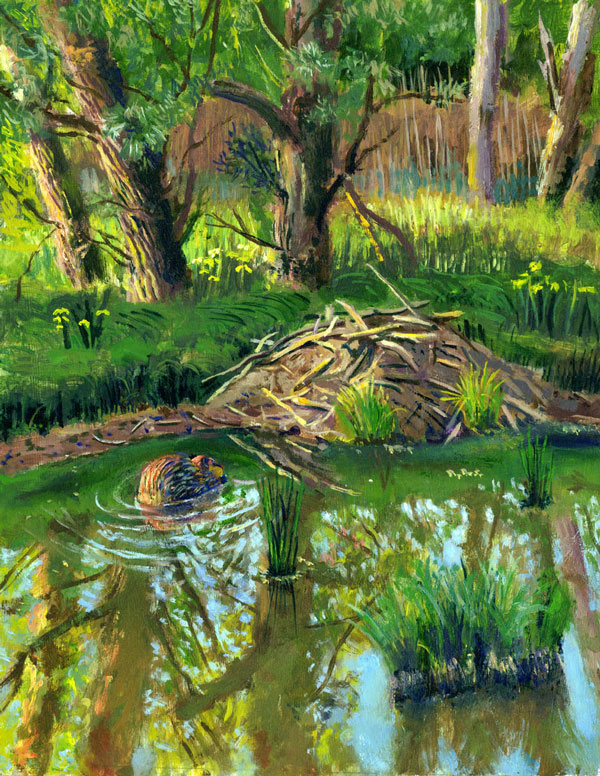
Beaver pond near Vaughn Road. May 2012
This is the second of the Beaver Lodge paintings, this one done in Cuyahoga National Park , not far for the yellow houses that are the Park headquarters. There are various beaver ponds spread around CVNP, most of them have bank lodges rather than the sort of independently existing structure that I was painting in Alleghany State park. I would think that a lodge surrounded entirely by water would be the best and safest option. But Beaver have their own minds and reasons for doing things. I wonder if it takes decades or years to develop pods that will support a lodge that is at the center of the pond, or if it is merely a matter of what is convenient for the Beaver. beavers have not lived long in CVNP, so it maybe that as tome goes buy and they make their ponds larger, the lodges will move away from the backsides. This lodge is connected to a fairly large beaver made pond, upstream perhaps 100 feet form the small pond shown here. The pond is at least 100 feet across, I am guessing. Beaver often create the sort of stepped or terraced system of ponds as they appear to be culturing on this site. This is the second of the Beaver Lodge paintings, this one done in Cuyahoga National Park , not far for the yellow houses that are the Park headquarters. There are various beaver ponds spread around CVNP, most of them have bank lodges rather than the sort of independently existing structure that I was painting in Alleghany State park. I would think that a lodge surrounded entirely by water would be the best and safest option. But Beaver have their own minds and reasons for doing things. I wonder if it takes decades or years to develop pods that will support a lodge that is at the center of the pond, or if it is merely a matter of what is convenient for the Beaver. beavers have not lived long in CVNP, so it maybe that as tome goes buy and they make their ponds larger, the lodges will move away from the backsides. This lodge is connected to a fairly large beaver made pond, upstream perhaps 100 feet form the small pond shown here. The pond is at least 100 feet across, I am guessing. Beaver often create the sort of stepped or terraced system of ponds as they appear to be culturing on this site.
Willow trees are so often near or next to Beaver ponds that I chose this small pond partly because i could paint the Willow trees too. These three are older Willows with deep furrows in the bark and lovely lacy leaves that we fun to try to represent in paint. I liked how the light played on them. What I have found, invariably, whenever I have visited A beaver pond, is that the wetlands they create provide habitat for an amazing diversity of plants and wildlife, many of which are becoming scarce due to continuing wetland destruction, paving over and 'development'. Over 90% of Ohio wetlands were destroyed between the 1780s and 1980s (Noss and Peters 1995). We obviously need as many Beavers as we can get to help restore some of these areas. The destruction of the "Black Swamp" in northwestern Ohio was particularly onerous. Some of this huge wetland should be restored.
Wetlands are beautiful and they also serve as important stop-over places for migrating birds, or nesting areas for local birds and animals. Beavers create lots of life around them. The more Beavers there are the more diversity and life will be seen. I like the light on the willows too and the Yellow Flag iris that grows next to the pond.
We are in May now and the sun is higher
in the sky. This is the first of my
summer paintings. The whole summer long
I was meditating on he color Green and
you can see various yellow-greens,
blue-greens and olive-greens here. What
I was especially happy with in this work
was capturing light in the water itself,
around the Beaver, where the willows are
reflected it he water..
The beaver at his Lodge posed for me several
times. I got the basic color, light and
and shape from life, and refined it
further at home. He or she (?) also
walked up the path to my left several
times, without smelling or seeing me.
Beaver do not hear or see very well, I
was standing on a rise above the pond
for hours and move little when I am
concentrating. Painting Plein Air
involves deep concentration and precise
calibrations of color and tone. It is a
meditative and active state, head and
hand working together is making many
subtle decisions..
In the background of the painting, on the middle right are some tall ochre colored grasses, actually a kind of Reed, that are from Asia called Phragmities. Unfortunately the National Park has done little to remove these very invasive plants. They are choking wetlands. I had doubts about putting them in the painting, but they are there next to this beaver pond and I put them in because it might be worth it if others notice and try to get the park to do something about this problem.

Picnic on Furnace Run Creek April May 2012
The next one is one is another of my favorite images. It was done over several weeks in late April and early May. The painting of the Virginia Bluebells above was done a stones throw from this bridge. Indeed, it was when we were walking around looking at wildflowers that I got the idea to paint the bridge and my kids not for from it.
So, for a week or so in early May, when
the weather was perfect, my wife and
kids and I went to Furnace Run to play
and paint. The kids played in the creek
as I worked. My daughter was
playing with pebbles. In nothing but his
"unders", as we call his underwear, my
son looked on his sister with the
sparkling water all around him. They
were in the cool water because it was
strangely warm for this time of year.
This is the strangest year of weather in
my life. But this did not prevent our
joy in this day. I often think that
humans are hard-wired to love their kids
with an intense aesthetic appreciation.
Indeed, some of the most intense moments
of love and beauty in my life have come
from watching my kids on an ordinary
day. Love of children may be the deepest
of all human emotions. Religious
imagery, such as the "Virgin and Child"
seems to be a sad exploit of this simple
and fathomless love. Love of children is
perhaps the most wonderful aspect of our
lives..
In any case, my wife made us all veggie dogs and
green beans cooked on our tiny camp
stove, which we call "Little Sister" and
have been using for years now. We
ate sitting on the rocks over there on
the right bank. These were special
days, the air was cool, the water clean,
the children playing in the water were
happy. My daughter kept coming over to
me while I was painting and telling me
she loves me, to which I replied that I
love her too very much. Life seemed
wonder filled and worth every breath of
spring air..
I am well aware that some will call
this a "cliche" image, but I don't care
about that. For me it is real poetry.
There are images of 'the covered bridge'
that are hackneyed and cliché and no
doubt over-cultured cynics will see this
one as one of those. But my
interest in this structure is quite
authentic and the structure itself is
quite authentic. admire the
craftsmanship of any bridge so nicely
made. Indeed, there are two portraits of
bridges in this series. This was a
functioning bridge for a century or so.
The fact that it is persevered is a
testament to our history and the love of
where we live. This is also one of our
cleanest creeks and my kids love it
there. I am not ashamed of
celebrating thiss
and those
who despise such authentic testaments to
our real history, are the real fools. and those
who despise such authentic testaments to
our real history, are the real fools.
Snobs who prefer their art to picture
empty grids or drawing made of elephant
dung, can go jump in the lake, as they
say. II
am proud of this painting, and always
warm to it when I see it.
Not far from Everett there is a farm where I often took my daughter. We went to Hale Farmmmany times from when she was 3 until she was 6. We have taken our son there a few times too.. Jonathan Hale came to the Western Reserve from Glastonbury, Connecticut, and acquired the valley acreage from the Connecticut Land Company In 1810. The Hale's made their living with commercial fruit orchards, market gardening, and the butter and cheese industry became popular due to urban demands. My daughter learned about this history as well as how to make butter,Jonathan Hale came to the Western Reserve from Glastonbury, Connecticut, and acquired the valley acreage from the Connecticut Land Company In 1810. The Hale's made their living with commercial fruit orchards, market gardening, and the butter and cheese industry became popular due to urban demands. My daughter learned about this history as well as how to make butter, candle making, basket weaving, blacksmithing, ice cream making, glass making, broom making and gardening. She also learned what it was like to farm and be a kid and go to school in the 19th century. All this was quite valuable and gave us both deep appreciation of the history of the Valley to complement what we learned elsewhere about the geology and Native History, and this history of the Canal Boats.
The Everett Road bridge and the Creek is Furnace Run, near the town of Richfield . Everett was a small town near to the Bridge, which had about 200 people in the 1920's. The remaining houses of that town are now used by the Park managers. In thee 1880s wooden bridges was replaceddwith more durable iron bridges like the one that still stands near at Station Road. I did a painting of the Train Station above, during the winter.with more durable iron bridges like the one that still stands near at Station Road. I did a painting of the Train Station above, during the winter.
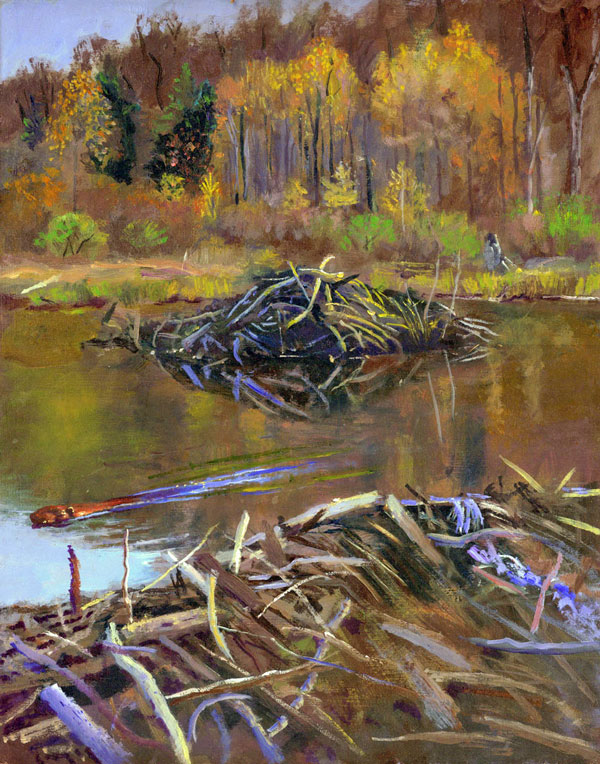 ;
;
Beaver pond in Allegany State
Park,,
N.Y. April 20122
I am not arranging this material by
subject so much as chronology. I want to
stay with the time line. This series is
a sort of calendar of a year in our
park. The next in the series is
this Beaver Lodge, done in April.
I intended to do a Beaver lodge in
Cuyahoga National Park too. But we took
a brief holiday and went to Allegany
State Park in New York for a few days, a
place we have been going for years. So I
did two beaver lodges. Compare this one
to the other beaver lodge two paintings
down, the one below, done in CVNP..
Allegany Park has some of the
best and wildest Beaver ponds in the
eastern states. They were restored
there many decades ago and allowed to
build or not build on their own. Beavers
were first introduced in 1926 (2 adults
and 4 babies eight months old). They
were shipped by train from Palisades
Park and were released on the north
shore of Science Lake, according to the
Allegany Park Historical Society. Much
of the construction in the park was done
by the Conservations Corps (CCC), which
did great environmental work all over
the country, including here near CVNP.
The Beaver of course, existed in
Allegany and CVNP centuries ago but they
were wiped out by the greed of the fur
trade, when Europeans starting trapping
and killing every animal they could all
over north America. By the middle of the
1900's many animals were gone locally
and some were extinct, like the Woodland
Buffalo and the Passenger Pigeon..
Some of the Beaver ponds are ephemeral in the sense
that some of the beavers move
allot, and a pond that one might see for
a few years is suddenly breached and
will be gone for some years as those
Beaver move down or up one of the creeks
or river valleys. On the other hand
there are ponds that we have seen in the
same spot for years. It would be
interesting to know exactly how this
works, but I do not claim to understand
it. I suspect it has to do with family
dynamics, deaths, or with conditions of
the actual pond and its viability. But
I have not studied it enough to know..
In any case, we were in
Allegany Park for a few days and I
wanted to paint at least one lodge from
life. I chose one and started it, but
there were problems with the light and I
was not happy with it, so after
some hours of work I wiped off the
board. My kids and wife had founds some
Newts in a puddle next to the beaver
pond and we studied those for while. I
saw, oddly, a bat flying around
aimlessly and wondered if it had a
disease, the so called, "white-nose
syndrome", a fungus which kills bats at
an alarming rate. as for awhile. Then we
moved up the Valley a few miles and
started over at a the pond you see here.
This is near the top of French Creek
Road. My wife decided to take the kids
to a playground in the park..
So I set to work. It took some doing to get into the Willow thicket that is at the base of the pond. But I managed. Because I was below the dam I had a good view of the lodge from a low angle, more the point of view of child than a man. That pleased me because it made me closer to the animals themselves. The beaver was swimming around his pond once twilight arrived and I made some attempts to paint him. I finished him from a few photos I took once I got home. I am not sure what the trees were beyond the lodge but the spring growth of leaves was decidedly yellow. The dam was breached towards the front and little waterfall flowed there. When I was done painting after many hours passed my wife and kids picked me up and as I was talking with them a rather strange man pulled up got out of his car with two of his kids. He started trying to breach the dam to show off for his kids. He pulled out stick after stick until he started sizable waterfall. I walked over to him and pointed out how much labor the beavers put into this pond and perhaps he would like to be more considerate of all their hard work? ---after all this dam and the lodge in the middle that the dam creates is their home. Would he like it if someone messed with their house?. He grunted, got back in his car and drove off with his kids. It is mysterious why he wanted to destroy the dam in front of his kids. Was he trying to teach his kids to despise Beavers? Many humans have a dysfunctional relationship to nature that makes them do odd things when confronted the lives of other species.

Then in early May the Warblers come.
This is always a marvelous time, with
rivers of birds flowing north all over
the eastern states. Waves and rivers of
birds come up from Mexico and across the
Gulf form the Amazon and beyond,
traveling on warm air fronts.
Chestnut-sided, Blackburnian, Black and
White, Yellow, Redstart, Magnolia, Palm,
and Yellow Rumped Warblers, among many
others all arrive in early May.
Many other species, totaling millions of
birds come in one of the great migration
on earth. It should be much more
celebrated than it is. There
should be holidays that celebrate it,
much like the great migrations in the
fall, where I have seen 50,000
Mergansers in a single flock on Lake
Erie. Spring celebrations would be in
early May and perhaps could involve
Migratory Bird Festival.
This little migrant is the Prothonotory
Warbler, and he lives down near Station
Road train station. We have known him
over a number of years. He sings his
small heart out most of the time,
marking his territory near where his
spouse nests. The Heron's roost was near
there, west of the train tracks. But an
Eagle pair moved in a few years ago and
started harassing the Herons. They moved
out, when the Eagles predated
their babies and moved across the Valley
east of the tracks..
Home schooling has its rewards but also its
hardships and stresses. I have little
time to take photos. Usually, i ht least
few years, when I was in the park in the
during the week I was with my son
walking him in the stroller. Last year I
was using a bike for rides or a walks.
There is a baby seat on the back of the
bike. We stop somewhere for lunch
on the Tow path. The I have a few
minutes, when my son is playing with
sticks or pebbles, to sue a camera. But
the photos are less than ideal. Taking
care of children does not leave one with
allot of time to do things for
photography. I I
photographed this Warbler when I could
safely.
I love the Yellow Warbler too, but the
Prothonotory male has the most beautiful
yellow imaginable, set of by the bluish
grey back and tail. He has singing
perches were he likes to belt out his
favorites songs, to warn other males
about the nesting presence of his
family..
My wife deserves special thanks for giving me
what time I have been able to devote to
this book. Perhaps half of the
works done in the last year were done
when my wife was home or when we are all
out in nature together. Perhaps half
these paintings were done when I go out
by myself. In both cases, I was able to
do the work I have done because of my
wife..
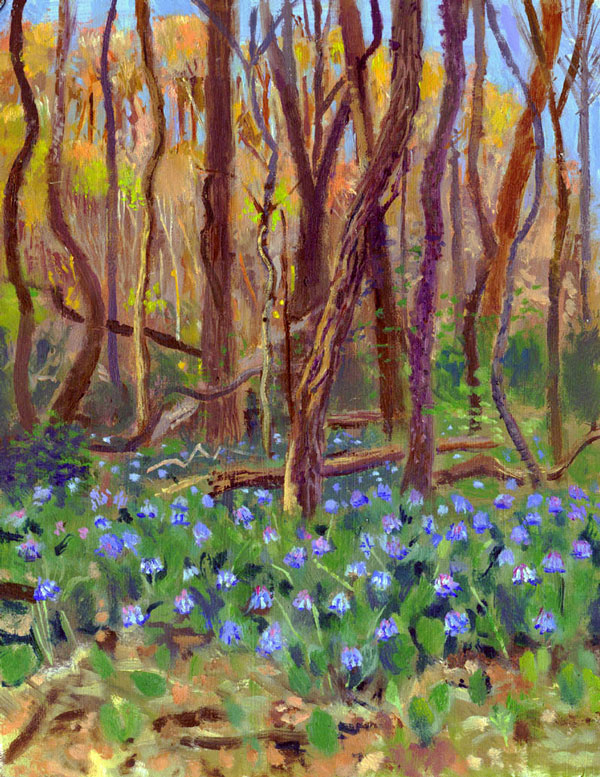
Virginia Bluebells and Spring Light, Virginia Bluebells and Spring Light,
April 2012April 2012
This also is a celebration of spring. One of my favorite things about it is the illuminated trees in the distance. There is a hill there and the trees are on top of it catching the last of the sun's rays, whereas the Bluebells are in the woods and in shadow.The largest tree towards the viewer is a Locust tree.d I have been in love with Virginia Bluebells (Mertensia virginica))for over a decade. They grow in colonies, usually in wet areass near rivers, creeks or floodplains. I have often seem them near Wild Hyacinths (Camassia scilloides) which also likes rich wet soils. Wild germanium is often in the same areas, This particular stand is not that far from the painting below. I had wanted to paint the Bluebells for some years and spent some days I the woods admiring them. Getting that particular blue was not easy. I find that intense blues are especially hard to do in paint, as the blues that are available just do not have the saturations that I need. I wonder how it would be to make my own blues out of Lapis Lazuli.
I don't know what proportion of the
paintings in this series are about
Wildflowers, but certainly it is one
of my favorite subjects. I would
like to do more of them. We
spent a good deal of time in the
last two years looking for Hepatica
in the parks. We succeeded in
finding it in a number of places. It
is so rare I will not say where, but
it is a gorgeous little flowering
plant. I have not yet figured out
how to paint it on site. They are
small and doing a close up would be
difficult unless I use a camera.
I have taken pictures of it and may
do a study of one of them, but I
would like to paint it form life if
possible. I am still thinking about
how to do it. It is an 'ephemeral'
and so does not last long..
In any case, just beyond where
the foreground trees end, is Furnace
Run Creek, and this meets up with
the Cuyahoga a mile or so from here.
Furnace Run is one of healthiest,
intact streams that flow into the
Cuyahoga River. It meets Ohio
EPA standards.
In any case, just beyond where
the foreground trees end, is Furnace
Run Creek, and this meets up with
the Cuyahoga a mile or so from here.
Furnace Run is one of healthiest,
intact streams that flow into the
Cuyahoga River. It meets Ohio
EPA standards.
There are allot of wildflowers here.
I recall seeing Bloodroot, Cut
Leaved Toothwort, Spring Beauty and
Rue Anenome. There is a high deer
population there so it is
interesting the wildflowers are
doing so well, since deer are so
often said to decimate such areas. I
did see deer came by as I was
painting, but there were still
plenty of wildflowers. There is a
claim that various
species of earthworms are invading
our hardwood forests and causing the
loss of tree seedlings, wildflowers,
and ferns. I do not know how true
this is, but it seems as likely an
explanation for the loss of
wildflowers as the deer hypothesis.
Perhaps both causes are at fault..
I also saw, every afternoon I painted there, a
roost of pehaps 15 Turkey Vultures
come in just before sunset cavorting
in the pines near me. As I was
painting my Bluebells, one of the
Vultures came crashing down through
the trees and landed on the ground.
Another day the same thing happened.
I puzzled about this for some time
and the only explanation I could
come up with is that one or more of
the youngsters, born this year,
fell, and the branches of so many
trees prevented it from stopping its
downward trend, and so it landed in
an ungainly way on the ground.
They need some space to regain
flight, with such large wings. I also saw, every afternoon I painted there, a
roost of pehaps 15 Turkey Vultures
come in just before sunset cavorting
in the pines near me. As I was
painting my Bluebells, one of the
Vultures came crashing down through
the trees and landed on the ground.
Another day the same thing happened.
I puzzled about this for some time
and the only explanation I could
come up with is that one or more of
the youngsters, born this year,
fell, and the branches of so many
trees prevented it from stopping its
downward trend, and so it landed in
an ungainly way on the ground.
They need some space to regain
flight, with such large wings.
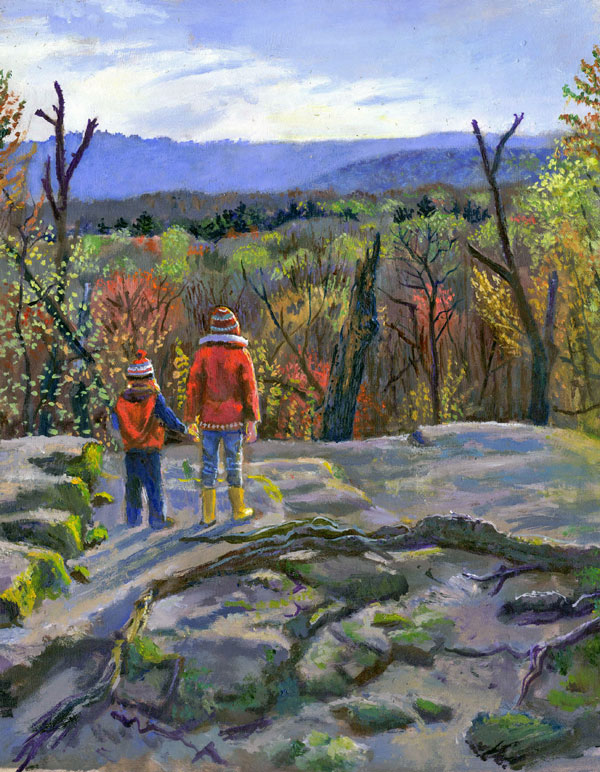
My Kids Overlooking Cuyahoga National
Park from the Ledges
(April 2012)
By early April a more normal temperature
was abroad. That is why my kids
are wearing coats. It is colder. This
painting was a joy to do as we all went
to the Ritchie Ledges over a week's time
and brought dinner to eat at a picnic
table. The kids got to play down below
the ledges with their mom while I
painted up above and they came to visit
me frequently to talk and see how it was
coming.
Many of the hardwoods are in bloom.
The pastel shades of spring, which some
will confuse with fall, cover the land
in delicate tints and hues.
"The
time when a rainbow falls over the
land", is obviously still here. The late
sunlight is pouring through the tender
new leaves, casting light on the
grey stone making in purplish and blue,
ochre and green..
I especially like this painting. This is a
special place, with the Berea sandstone
cliffs raising up to 100 feet in some
places and covered in mosses and
lichens. You can see some of the mosses
on the rocks here and an old root of the
tree just out of view. All of this
painting was done on site expect the
children. This was a very dangerous
place for my little three year old and
we took the picture with his mother just
out of the picture. There is a 40 foot
cliff in front of the children so it was
out of the question that they could
pose. There was no danger of him falling
as his sister and mother were both
looking out for him. I painted
them into the rest of the painting,
which was otherwise entirely Plein Air,
from a photograph. This is also one the
best views over the Cuyahoga Valley. I
have gone around the Valley from many
directions and it is hard to find places
to get such a wide view. That is partly
why I did the painting, as well as
to memorialize a moment in the life of
our two children, who love this
place dearly and love our park. It is a
celebration of spring. It is also
a study in the poetry of color and the
use of aerial perspective
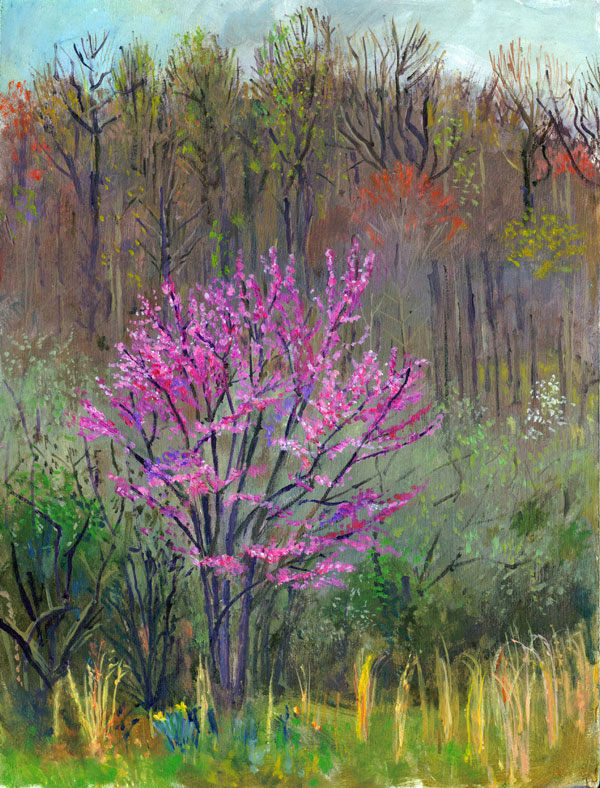
Redbud Tree in March
April, 2012. Spring in Ohio is
glorious. I love spring anywhere, but in
the eastern states it is so spectacular
a change from winter to spring that it
takes your breath away. I have always
thought so and remember the rapture of
this season going all the way back to my
teens. It is not just the beauty of the
trees, though that is a major part of
it, but the air itself is full of hope
and new life.
This is another portrait of a native tree
in our area: the Redbud. I got to know
Redbuds at Hereos Wetland years ago. I
had seen a large stand of them in
Richfield, and knew of this stand up on
Hines Hill Road. These are special
trees. The flower actually grows on the
stems themselves, rather like the lovely
Spice Bush which comes into bloom around
this time too. I've seen Cardinals,
Golden Crowned Kinglets or Goldfinches
in them. So for a week or so when I had
some time I went up Hines Hill road and
painted this. It was so warm the trees
were coming on quickly and I did not
have much time. It was done again
in probably 4 or 5 visits. The tree with
brownish/red buds in the background is
the Sugar Maple. I am not sure what the
white blossoms were, perhaps
Serviceberry, or Dogwood. Below
the Redbud is more Little Bluestem
gasses as well as a few daffodils
someone planted long ago. The Redwing
Blackbirds were back and kept me company
at the pond near where I stood. I have
been wanting to paint flowering trees
again for many years and was very glad
to be doing it. I hope to do more next
year. Spring is so dear to my heart and
I cna't imagine why I have spent so many
years no painting spring trees..
In any case, I was not prepared for an early spring and had to rush into painting the Redbud before I was psychologically ready for it. The Turkey Vultures were back weeks earlier than usual and the Magnolias burned out early. Dragonflies were out early too. The ponds where the Jefferson's, Yellow Spotted and Red Backed Salamanders migrate was lower than usual because there was so little snow. The daffodils you see in this painting should not be out yet, but they were out a few weeks early. Usually they come out in early April, but here there are out of the 24th of March or so. In any case, I was not prepared for an early spring and had to rush into painting the Redbud before I was psychologically ready for it. The Turkey Vultures were back weeks earlier than usual and the Magnolias burned out early. Dragonflies were out early too. The ponds where the Jefferson's, Yellow Spotted and Red Backed Salamanders migrate was lower than usual because there was so little snow. The daffodils you see in this painting should not be out yet, but they were out a few weeks early. Usually they come out in early April, but here there are out of the 24th of March or so.
Once I finally adjusted as best I could, I was glad to see the Redbuds coming out in late March. I finished this sometime around then. In years past I used to call this time of year "the time when a rainbow falls over the land", as the spring trees look so various and fresh in their pastel colors.
The last two paintings before this, one of a waterfall and the other of a spring creek, both had to do with water and early spring run off. We had so little snow that there was little run off though. There was a bizarre heat wave in March and this caused the fruit trees to bloom early and then many flowers were killed in a later frost. No flowers, no fruit--- and so allot of our local apple growers only had apples till November instead of December. That that was hard on them. Certainly all this was caused by global warming. It was again the warmest year on record. Indeed, NOAA's National Climate Data Center reported that over 7,000 daily record high temperatures were tied or broken from March 1 through March 27, 2012. Businessmen unregulated will destroy the earth if we let them. They don't care as long and they make their billions. We need to tax and regulate them much more than we do.
The heat wave affected my paintings. Spring was odd, as some trees came early and some came at their regular time. I worried about the birds as their timing is partly motivated by 'photoperiodism'. That is to say they move north when the length of daylight suggests they should. I was worried that the “shift” to an early timing for the emergence of vegetation and insects could compromise survivability for birds . Would the insects they prefer to give their young be there for them? But it seems weather also plays a part, and it may be that some birds have been moving north early..There is evidence that some did come early. The effects of early arrival might affect birds in various negative ways too. Like the fruit trees they could be exposed to sudden cold or their food supply be decimated. I worried about these things over the spring.There is evidence that some did come early. The effects of early arrival might affect birds in various negative ways too. Like the fruit trees they could be exposed to sudden cold or their food supply be decimated. I worried about these things over the spring.
-in-fa.jpg)
Spotted
Salamnders in Flashlight. ( Jan. 2013)
While the leaves are still well off
the tress and only a few species have shown signs of spring
life, the Salamanders begin to stir form their hibernation. While the leaves are still well off
the tress and only a few species have shown signs of spring
life, the Salamanders begin to stir form their hibernation.
The challenge of this one was to try to sum up
not just one year of visits to the Salamander
Migration but 4 years. Photographing
Salamanders was not easy because I did not like
turning over logs to find them. They can be
easily killed by this practice. The only time
that these beings can be easily seen is in the
early Spring, March usually, during a rain, when
the temperature is above 40. That is when the
migrate. More akin to frogs than lizards
these are very interesting amphibians migrate at
the same time as Wood frogs, Peepers and Chorus
Frogs and to vernal pools..
We have brought our children the migrations in various
spots since 2007.We took the kids out numerous
times each year looking for Frogs and
Salamanders. These migrations are wisely
monitored by park officials as there are
ignorant and greedy people who like to steal
these animals and in doing so hurt Salamander
populations. All amphibians have been in serious
decline for some time. The causes are
many, including a fungus (Chytridiomycosis),
environmental destruction, pollution, global
warming and other factors. Some species have
become extinct. They often cross streets to
migrate to the Vernal ponds and they are hit by
cars, which is why it is wise to close off roads
when the migration is on. It is amazing to watch
them both in and after the migration as it is a
sort of orgy of Frogs and Salamanders which
occurs. Great numbers of eggs are laid down in
egg masses and fertilized by very ardent males.
Here I was trying to capture the fact of it
being nighttime and we use flashlights or
Coleman Lanterns, which casts a strong light on
the animals. They don't seem to bothered by it,
driven by hormones and spring the ardency of
desire..
This work is recent and is different than most of the others in that it is partly invention and partly done from photos I took of Spotted Salamanders during the migration. An artist in Toronto I know named Barry Kent MacKay thinks that one of the the best way to do birds is through the informed imagination. Certainly that is what Da Vinci was doing in some respects. Many of the old masters created pictures out of their minds more than their eyes. Of course, the great ones like Da Vinci first mastered drawing with the eyes. Barry has mastered bird anatomy more than anyone I know, and he can draw nearly any species from his head. He sets these in what he calls 'Vignetttes' and some of these are amazingly beautiful. I also admire his animal rights work. Alan Brooks, Fuertes, D.M. Reid-Henry, George M. Sutton T.M. Shortt, Liljefors, and Roger Peterson were all influences on Barry. Barry is an scientist/artist of the kind I am advocating for in this essay. I admire him you can see some of his work here.
I let myself be influenced by Barry on this one and like the result, though it was a struggle.
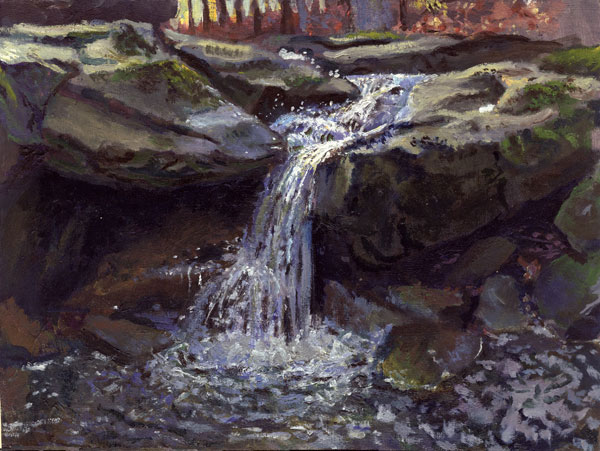
Deer-Lick Falls
We are now in March, 2012.
I enjoyed finding
this place and doing this painting very much.
It is near a place called Deer Lick Cave, which
I ended up calling Turquoise Valley, because of
the wonderous copper green lichens that grow on
many of the rocks there, The bluish/green lichen
color combined with the yellow/green mosses
makes for a lovely concert of colors that is
rare in such profusion. There is a trail that
goes through the area, but it was
sympathetically made with wood for the small
bridges that go over the creek and not metal.
My knowledge of geology needs improvement, but I
believe the rocks are also Berea Sandstone, a
very hard rock that resists erosion. This is the
same rock we see at Ritchie Ledges, (see
below
My Kids Overlooking
Cuyahoga National Park.)
This whole little valley is made of hard
sandstone and it makes it a cool hidden place
under the e tree canopy. The water does
not run all the time, but when there is rain it
runs and fills the little valley with the sound
of dancing water.
The original painting was started in the rain and
the water was soupy, greenish yellow and heavy
as it poured over the huge rocks. After my first
foray there, pictured here in a smaller image, I
decided the light was too overcast and dark.
This is an early state of the same work, after
one session, the one above is after four
sessions. The original painting was started in the rain and
the water was soupy, greenish yellow and heavy
as it poured over the huge rocks. After my first
foray there, pictured here in a smaller image, I
decided the light was too overcast and dark.
This is an early state of the same work, after
one session, the one above is after four
sessions.
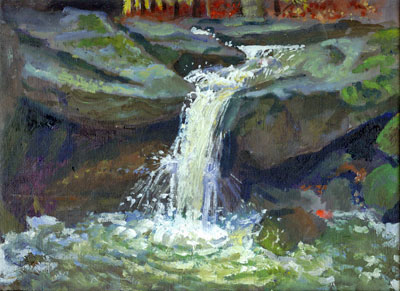
I changed the ambiance and the next three visits were on sunny days when the light was better. The water was cooler, blue and dancing. I painted in the late afternoon, looking toward the sun. The water was less milky, less full of sediment, less swollen from recent rain.
The painting posed many problems. The
highlights in the water were very bright. As the
water descends it gets bluer and greyer, and
this was not easy to capture. The ochre rock on
which the waterfall falls was also very dark,
and capturing this large wet and black/ochre
rock posed problems. I didn’t use black but
Prussian blue and Burnt Umber. The waterfall
itself, where it hits the pool, reminded me of
one of Da Vinci’s greatest drawings. In that
drawing he shows the dynamics of water hitting
water, plunging down and bubbling up in
concentric circles. I knew I could not match his
peerless hand and observational skills, but I
did the best I could. The painting posed many problems. The
highlights in the water were very bright. As the
water descends it gets bluer and greyer, and
this was not easy to capture. The ochre rock on
which the waterfall falls was also very dark,
and capturing this large wet and black/ochre
rock posed problems. I didn’t use black but
Prussian blue and Burnt Umber. The waterfall
itself, where it hits the pool, reminded me of
one of Da Vinci’s greatest drawings. In that
drawing he shows the dynamics of water hitting
water, plunging down and bubbling up in
concentric circles. I knew I could not match his
peerless hand and observational skills, but I
did the best I could.
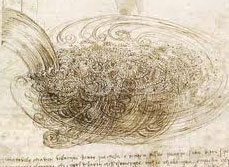
Leonardo's water studyLeonardo's water study
In the lower right of the painting,
there is a spiral galaxy-like form. This results
from bubbles from the waterfall getting caught
in a whirling current or cul de sac. That
charmed me very much and added to the poetry of
the place. Nature echoes itself in so many
places.
The main thing I wished to express in this
work was the greenness of this turquoise valley
as well as the liquid tracery of the fluid light
in the waterfall, contrasting with the
cantilevered gravity of the massive rocks.
I am not sure I achieved my goal, but then I
rarely do entirely. I am interested in art
serving science and objectivity. I always make
mistakes and go back and try again, hoping to
improve slowly over time. I look forward to
painting in this spot again, and tried once, but
that painting failed and I did not keep it. I
might try to do this scene yet again and this
time I would make changes, make it taller and
include more of the woods, or change my view and
do it from another angle, perhaps on top of the
waterfall.
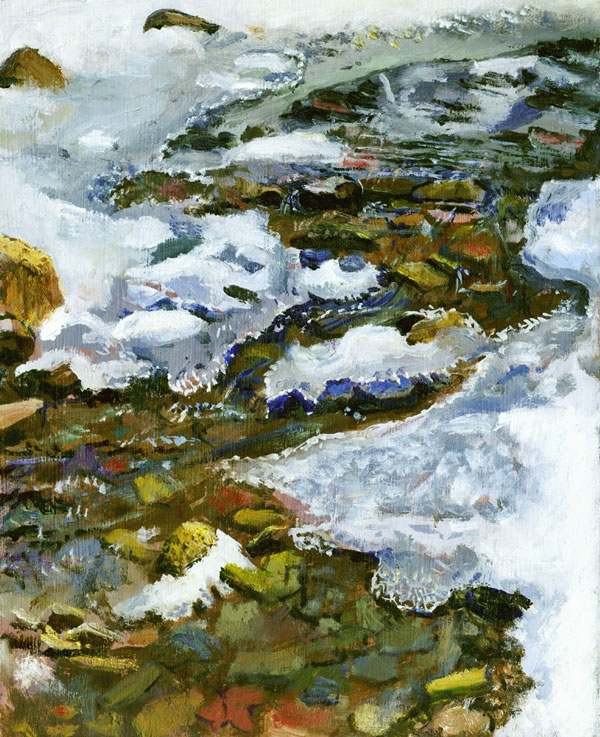
Winter Creekk,
(Columbia Run),
(Columbia Run)
This is a study of rocks, water and ice, it is not at all an abstract work, though it might appear as one. The rippling stream is called Columbia Run, a little noticed creek about midway between Boston Mills and Vaughn Roads. This creek is said to have Redbelly Dace, a rare minnow. I have seen minnow in it but could not tell which ones. It also is said rare Cerulean Warblers nest here. I have not seen them here, though I have seen them elsewhere in the park. I was interested in the whites, grays and blues of the ice and snow and the color of the many rocks in the water and how the two contrast. There were a few leaves from the fall. It was March already and a feeling of early spring was at large, with the slushy snow and the melt. If you squint your eyes at the painting you can almost see and hear the water dancing over the small stones and under the ice on the rock in the middle of the rivulet. At the top of the painting I like the feeling of slushy snow.
A comment might be in order on abstract art here. I generally breeze through areas in museums that have abstract things in them, as they are usually so badly conceived and done. There are some exceptional abstractions that have real content, but they are rare. Kandinsky and Klee and sometimes Picasso are often very interesting, even if Kandinsky's spiritual ideology is bizarre, Blavatskian and even delusional. But what is good in these men's work is bested by certain Oriental or Native American carpets, which is largely a woman's art, as well as some quilts and pottery designs, which are often abstract and very amazing. Folk art, costume and decorations of many kinds are often very human and compelling in ways that the fashion/art world in New York is not. Most of these are by women too. Defining the difference is not the place of this essay, but it boils down to corporate, institutional art as against an art that grows from actual people and their real needs. A great South Persian tribal carpet has real flowers and birds and a love of nature in it. In the painting above I was not concerned with abstract design at all, but rather with the facts of the subject and doing justice to water, snow and stones. What matters is the felt empathy with colors and forms. In a really good oriental carpet that is what one sees: nature translated organically into a wool design felt deeply and made concrete by art. Art by definition is not mechanical or corporate. The weaver has been sensitive to the colors and forms that wool makes and translates that sensitivity into abstract floral or geometric shapes. Some quilts do this too and one can feel the love that was put into the design, meant to warm a child in the bed or keep warm a married couple who have been together 30 years.

Juncos
Dark Eyed Juncos are lovely small birds that
come down form Canada every late fall and live
with us all winter. I am always glad when the
arrive and sad when they go. We are faithful
feeders so they are sure to get their food and
stay with us for the winter. Their tail feathers
suddenly flick a whitish stripe when they
flitter from here to there. Here they are eating
a few peanuts on our deck. I was intrigued by
the subtlety of the whites in this scene. The
snow in the sunlight appeared with a bluish
tint, but the underbelly of the birds was a
light lemony yellow. I liked that contrast very
much..
We got to know the Oregon Junco in Northern California, which
some ornithologists list as a sub-race of the
Dark Eyed, and some list as a separate species
altogether. It is quite different with a
russet back and peach or ochre colored sides
These two in my painting seem to be two Slate
Colored males, which are a type of Dark Eyed
Junco. We got to know the Oregon Junco in Northern California, which
some ornithologists list as a sub-race of the
Dark Eyed, and some list as a separate species
altogether. It is quite different with a
russet back and peach or ochre colored sides
These two in my painting seem to be two Slate
Colored males, which are a type of Dark Eyed
Junco.
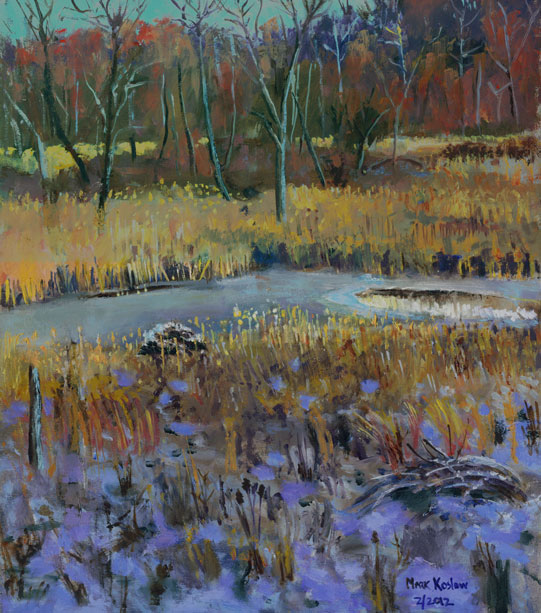
Muskrat Lodge
and Pond
This is the same site as the painting above called "Cuyahoga Floodplain and Hillside". This is the second of three paintings done there. I was interested in the Muskrat Lodge next to the ice as well as the ice itself. There was an area of ice apparently kept clear by ducks or geese, but they had left during the times I was there. The ice was smoky with an old snow frozen and melted and refrozen again in a gray and misty color. I love that color and it reminds me of ice skating on Cedar Pond in New jersey, when I was a kid.
There was more of the Little Bluestem here. I struggled with the trees in the background because the light was so variable. When the sun sets here it goes down in the valley to the far right and casts very long beams of light though the trees from right to left in the painting. The winter trees are normally a grayish umber, but I show them here as reddish because the sun was on them and they glow with warmth. There were purple shadows beyond them.
*****
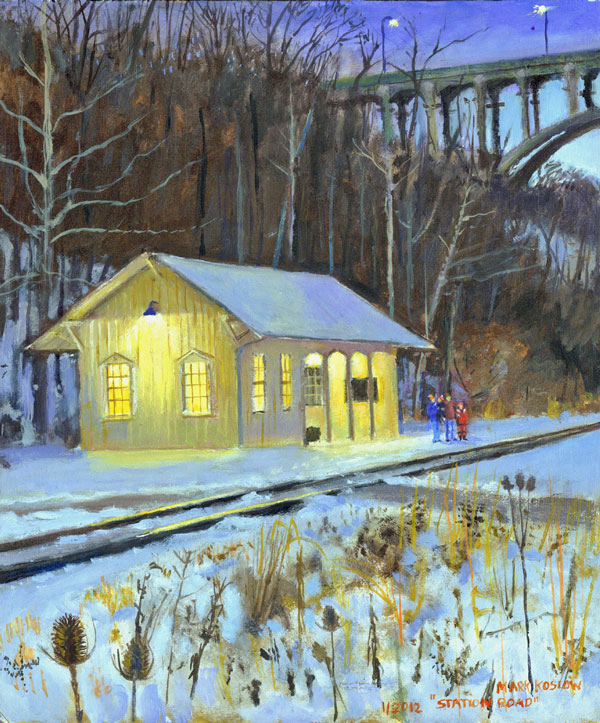
Walking back on the railroad tracks from
doing the Sycamore painting, I started
seeing this lovely train station across the
parking lot at Station Road. I love trains
and wish our society would rebuild them.
They are much more efficient than cars and
waste less energy. I like the loneliness of
train tracks and the hope of stations, the
longing to go elsewhere. I lived in England
for 6 months years ago and loved the
stations there and the ease of travel by
train..
In the distance is a bridge which is
one of the most beautiful bridges in the
state of Ohio: both to look down from and to
look up at. It recalls bridges on Highway
One in California I have seen, with great
arches that span lyrically over the Valley.
There is an Eagle nest in a wetland near
here and I have seen Peregrine Falcons, many
Herons, as well as Prothonatory and Cerulean
Warblers in this area too. Many people get
the Valley train here, which goes to Akron
or Canton, or they park here to get on the
towpath to walk, jog or ride bikes. The
towpath trail runs along the old Canal way,
and goes the entire length of the 17 or so
miles to Akron..
I don't usually like to paint around people
much, excepting my students, but will do it
if I have to. On this painting I could see I
had to. I have had people take pictures of
me while I paint plein air and I find that
particularly annoying, and I stop them if I
can. But the lights on the train station
were so lovely at twilight I could not
resist it. Ever since my teens,
walking home in the winter, I loved seeing
lighted windows in houses, suggesting warmth
and a place to go where you feel you belong.
Indeed, for us humans, belonging is almost
everything, and it is that need that makes
us fear shunning and homelessness so much,
the cruelty of the tribe. But this painting
is far from cruelty, a family wants a the
warm station, all its members happy and
together. Even the so called "winter weeds"
in the foreground of the painting have
a certain invitational warmth. I have always
loved the shapes of dried out winter plants.
My mother loved them too and I keep on her
traditional of making flower arrangements of
dried winter plants and berries..
As I worked on this
painting over 5 days or so, I had various
weather. One day I was out there for
several hours in a snow storm and the
temperature dropped below 15 degrees (F).
The snow that was falling was no longer
melting on impact and was falling in
perfectly classical 6 point star designs. I
could see these in my black coat. The snow
began to congeal in my paint. Soon,
snowflakes made it thick like pencil
shavings or sawdust mixed with glue.
The paint became so viscous and clumpy I
could scarcely get the paint onto the board
much less manipulate it like ordinary paint.
I tried to put it on the painting and it
merely fell off it clumps..
I had cut off the two fingers on some very warm
wool gloves and made them into
painting gloves that free the two fingers on
my right hand. I was painting in these.
After a few hours int he cold, my two
exposed fingers were so cold I could
barely move them and was beginning to fear
getting frostbite. So I went home. I had to
give up for that day. It was a good day of
painting though. and I was happy..
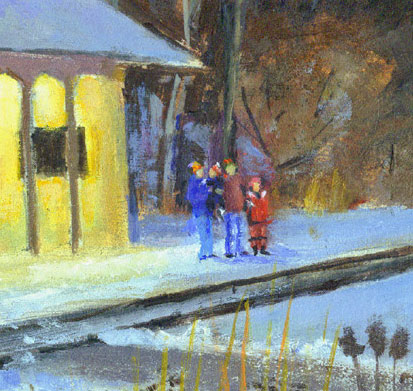
The last afternoon and early evening I was
there was still cold. I worked under the the
cold blue northern sky. I love these cold
skies form Canada, because the air is clean
you can see stars. You can see this clear
cold sky beyond the bridge, hinting at the
Sky over Lake Erie all the way to Hudson's
Bay. It was too cold for anyone to be there
the last twilight I was there and I painted
away happily. The light was just right and I
was thrilled with the work. But it is one
for or five to this finest in this series, I
think. The last afternoon and early evening I was
there was still cold. I worked under the the
cold blue northern sky. I love these cold
skies form Canada, because the air is clean
you can see stars. You can see this clear
cold sky beyond the bridge, hinting at the
Sky over Lake Erie all the way to Hudson's
Bay. It was too cold for anyone to be there
the last twilight I was there and I painted
away happily. The light was just right and I
was thrilled with the work. But it is one
for or five to this finest in this series, I
think.
One further note about this work. I brought
it home and decided that it needed us in the
painting,---my family and I. We have taken
the Valley train to Akron Zoo several times,
not from this station but from another, and
it is a marvelous trip. I wanted to do
another miniature of my family. I did one a
few years ago with figures even smaller and
sued a magnifying glass. I don't know why I
find miniature work interesting. Maybe
it is the small miniature thatt
Julia Kahle
did of my
grandma that is in the Metropolitan Museum
in New York. But not really as years earlier
to knowing about Kahle's picture I was
fascinated with
Jan Van Eyck
Jan Van Eyck's
amazing tour de force of miniaturization in
his famous crucifixions and hell scene in
the Metamazing tour de force of miniaturization in
his famous crucifixions and hell scene in
the Met.
I admire the left panel in particular,---
look at the faces of all the men on horses.
It is refreshing to see the very small and
humble done with honest authenticity of
subject and of the best execution one can
achieve. I think I admire the miniature
partly because today there are so many huge
gigantic paintings in museums that are
utterly empty of any content. Corporate art
is the art beloved of psychopathic
corporations. (note: See also
Van Eyk's or any of his other paintings too,
such as the famous mirror in thee
Arnolfini portraittor theor theamazing landscape and town in the background
of thee The Virgin of Chancellor Rolinn. ). ). )
My eyes are not good enough to
achieve anything like that level of detail.
But I admire this skill greatly. Indeed, I
can't think of anyone who has done as well
and Van Eyks in this genre of exquisite
detail in the very small. There are many
miniatures in the Portrait Gallery in
London, as well as other museums, that are
quite amazing too. What I admire is the
skill of There are some works by
Ernst Meissonnier
, Cleveland has a very fine example--- which
are amazing but not up to Van Eyck.
Meissonnier's politics are quite reactionary
but that does not detract from his skill as
an artist. I think Van Eyck had
exceptional eyesight and the hand control to
match it. There is nothing quite like him in
the history art. In any case, I tried
my hand at this on a hand-made box a few
years ago. Here I did not use a magnifying
glass as I did then, and managed to make
tiny figures less than an inch high, with
some verisimilitude. My daughters red coat
with the fluffy collar and her dress with a
Scottish plaid is suggested. My generous
form and my wife's blue coat as well as my
son riding on my wife's hip are apparent.
But it is still far from the expertise of
Van Eyk and Meissonier. I am just venturing
a little in their direction, which only
increased my respect for their skill.
I do not aspire to be a great miniaturist,
but I have come to admire those who have
mastered this skill.
I spent parts of Winter and Spring studying
Vermeer and De Hooch too, as well as other
Dutch painters. They did not affect my
landscape work, but more my figurative work.
I much prefer De Hooch to Vermeer, though
there is much to admire in the latter. De
Hooch's work is very warm and it is clear
that his wife was very likely a model for
many of his paintings. I like that he
provides a window into the reality of life
and one can feel a certain love of the
domestic in him which I appreciate. It is
this intimacy that I admire in De Hooch as
well, which is lacking in Vermeer. We
spend a great deal of time with our children
and do not farm them out to privatized
institutions and "day care".
The hatred of history in modern art is one of its
most irritating aspects. I love art
history and always have. The presumption of
a Matisse, Picasso or Pollock to abandon the
art of the past and "go beyond it, is so
ridiculous that it is embarrassing. The
suppressed the ability to draw and in the
process made their art into poor imitations
of Children's art. Children can draw much
better than any of them. Science shows us
that learning from the past really matters,
and making yourself dumb and unable to draw
or learn from the past is an ignorant thing
to do. There is so much to be learned form
the history of art about social facts,
technique, experiment, inquiry, seeing,
sensing, organizing as well as history,
politics, philosophy, and so much
else. Modern art through everything out the
window and made art about art. But in doing
so it killed what art is, which is
everything except art. They made art into
empty fetishes that really are all about
money. How stupid was that?
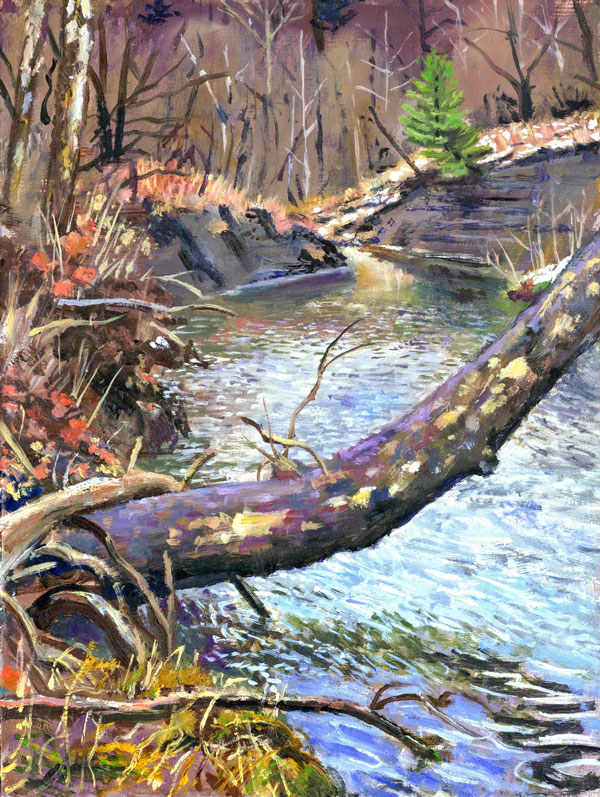
Sycamore over Chippewa Creek
This is Chippewa Creek, one of many tributaries of the
Cuyahoga. The mouth of the Chippewa enters the Cuyahoga just
around the bend there up ahead in the painting. We have
entered December here. It was the warmest year ever in Ohio,
but that did not prevent some cold days. On this day there
was a dusting of snow on the opposite bank. The snow melted
on the left bank because the sun is in the southern sky in
the winter, which is to the right in the painting. To the
left is where the sun shines strongest and so it has melted
to snow on the left bank.
Sycamore trees are very common in Ohio. I
used to marvel at them in Marietta when I went to college
there briefly. I especially enjoyed seeing them at
night as their white branches would glow against the starry
sky. They grow along the Ohio river and indeed, they are wet
soil trees and prosper where there is allot of water,
streams or rivers. In this place, I was charmed by the way
the tree managed to lean out so far over Chippewa Creek, and
hold onto the bank, very nearly growing horizontally. It is
in no apparent danger of crashing into the water. I have
seen this many times with there threes. The help preserve
river banks in this way, holding the bank back form erosion.
Admirable trees,, which have interesting seed balls which
goldfinches love to eat in the winter and spring.
One of my main motive in doing this picture was to try to
represent the massiveness of the form of the tree and its
weight and strength, holding itself up by a rotted
attachment to the bank. This stretch of the Creek has cut
right through a shale hillside. I had started back doing
life drawings around this time and that study helped me
understand form in nature a little better. After all, the
human body and all other organic forms from horses to tree
trunks have much in common. All this year I have been
interested in turning form and the roundness' and density of
things. The massive pull of gravity on this huge trunk
does not succeed in pulling it down and the life of the tree
holds it up with innumerable roots holding the entire bank
together. One of my main motive in doing this picture was to try to
represent the massiveness of the form of the tree and its
weight and strength, holding itself up by a rotted
attachment to the bank. This stretch of the Creek has cut
right through a shale hillside. I had started back doing
life drawings around this time and that study helped me
understand form in nature a little better. After all, the
human body and all other organic forms from horses to tree
trunks have much in common. All this year I have been
interested in turning form and the roundness' and density of
things. The massive pull of gravity on this huge trunk
does not succeed in pulling it down and the life of the tree
holds it up with innumerable roots holding the entire bank
together.
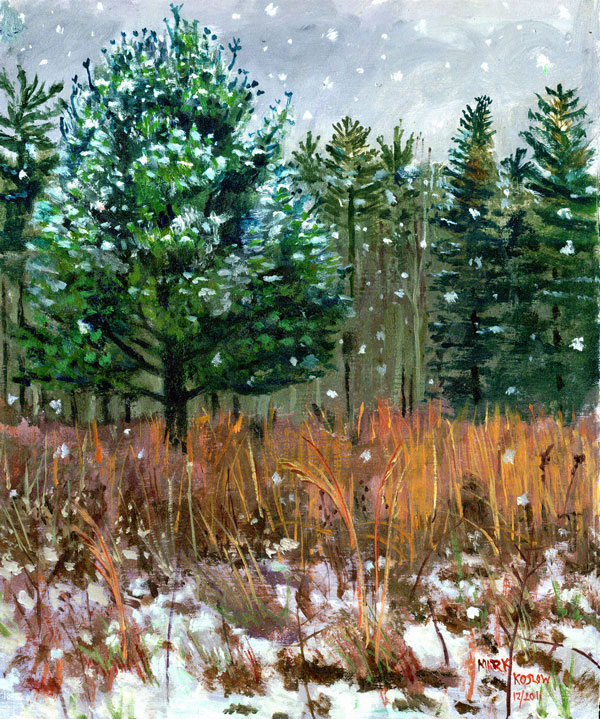
Andropogon Scoparius,( Little
Bluestem) and Pines.Andropogon Scoparius,( Little
Bluestem) and Pines.
It was the warmest December I ever
remember, but we did have a light snow a
few times. This is one of those times.
The snow flakes were large and fluffy. I
could see the designs of the snowflakes
on arm of my black winter coat. It was a
slushy snow and I was standing in a bit
of a puddle in the clumpy grasses. There
is an old clapboard barn near where I
was painting this and it is a matter of
feet from where I stood and did the
"Across the Valley Painting".
I love these native grasses and have admired them
since I was at school in Southern Ohio,
where they are more common than in
Northern Ohio. For years I have been
calling them Andropogon Scoparius, but
recently they have been calledd
Schizachyrium scoparium, both refer to
the plant commonly called Little
Bluestem. I imagine there is a
structural reason for this change.
In any case they are lovely in the fall
and winter and have this russett, ochre
or cinnamon tone that pleases me
greatly. As I studied them they even
turned a little towards crimson and
purple in the shadows. So I decided to
dedicate a whole painting to them as a
sort of grass portrait. I loved the pine
trees too, and there are several species
here, and I do not mean to diminish
them. But this painting is about these
special grasses and snow as well as snow
fall on pine boughs.
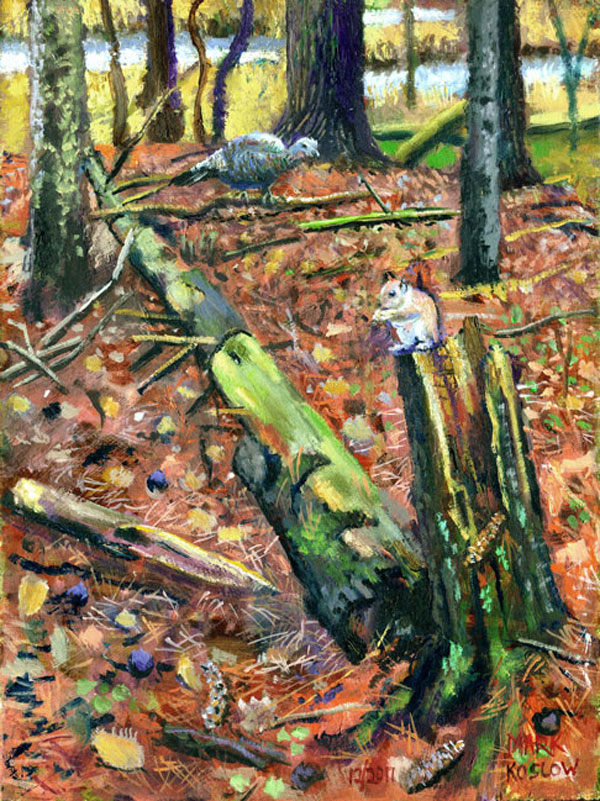
Berkeley's Mistake, Red Squirrel and
Turkey
One day my nearly three year old son
and I were walking in the woods
above a Beaver pond and came across
this old fallen tree. I liked the
color of it, covered with mosses,
lichens and molds. The mosses were
all wet. Pine needles, dead
leaves, chewed up bits of pine cone,
and shredded bark surrounded the
damp base of the fallen tree. It was
under lovely canopy of pine trees
some of them my believed White Pines
but also hemlock and scotch pine..
(if you look att Green Heron's
Worlddbelow, the stand of pines
that is in the upper right of the
painting is the one I am talking
about. The painting of the Train
near the Wetland at the bottom of
this page was also done nearby up
the hill form the beaver pond in
this grove of pines))
I loved all the decay and new growth coming
up. The wet old walnuts, somewhat
purple in the misty rain that was
falling that day. Red squirrels
chattered up above me, eating pine
cones, some of which surrounded me
from here they dropped them. A
turkey with one full grown poult ran
up the hill while I was painting
there, so I decided to put a Turkey
in the work..
There are four species of Squirrel in our area, the
Fox, Red, Gray(black) and the
Flying. I just saw my first
Flying Squirrel in the woods a few
days ago. (Dec. 2102) I have seen
them in cages, but I don't think of
that as seeing the actual thing,
really. The Flying Squirrel was up
during the day, which I think
unusual, and I saw it fly down to
the ground is a graceful and fairly
slow freefall, flight skin
outstretched between the fore and
back limbs. It hit the ground
running and quite amazed me. I have
only painted the Red, Fox and the
Black, not the gray or Flying..
Red Squirrels have more energy than any
mammal that I know of. They are even
crazier and seem more nervous than
Otters. I don't know much about
animals like Martens, Fishers,
Wolverines, and Ermines, though I
have seen Minks. But for three years
now Red Squirrels have adopted our
house and my family. They built a
house in the rafters of the garage
and live there all year round. When
the Walnut tree nearby is in nuts
they hide them around the garage.
They pull them out to eat them all
through the winter and dump them on
the floor for us to kindly clean up
for them. I don't mind
obliging them. We feed them generous
portions of bird food, and that is
fine too. But they are amoral beings
and have destroyed a number of our
favorite birds nests. I have not
been happy about that. One year it
was the House Finches nest. They
killed one of the babies in the nest
and the other just managed to get
away when I yelled at the squirrel.
This last summer one of these
Squirrels raided the nest of the
Cardinals or Redbirds we call Baldy,
(because he gets head mites most
years and loses his head feathers in
the summer). But besides this
lamentable lack of bad conscience,
they are otherwise the most
delightful and energetic beings I
have ever seen, full of pluck and
vigor, leaping form branch to
branch, yelling at each other, and
curling up together is their
leaf-stuffed bedroom in the garage
every night. Their babies are even
more energetic and will chase each
other around our huge Silver Maple
in spirals up and down the tree. In
the painting above I picture the Red
Squirrel in one of it more placid
moments. I often see them in this
pose sitting in a tree gnawing on a
nut or on the railing of our deck,
chewing on a peanut. Red Squirrels have more energy than any
mammal that I know of. They are even
crazier and seem more nervous than
Otters. I don't know much about
animals like Martens, Fishers,
Wolverines, and Ermines, though I
have seen Minks. But for three years
now Red Squirrels have adopted our
house and my family. They built a
house in the rafters of the garage
and live there all year round. When
the Walnut tree nearby is in nuts
they hide them around the garage.
They pull them out to eat them all
through the winter and dump them on
the floor for us to kindly clean up
for them. I don't mind
obliging them. We feed them generous
portions of bird food, and that is
fine too. But they are amoral beings
and have destroyed a number of our
favorite birds nests. I have not
been happy about that. One year it
was the House Finches nest. They
killed one of the babies in the nest
and the other just managed to get
away when I yelled at the squirrel.
This last summer one of these
Squirrels raided the nest of the
Cardinals or Redbirds we call Baldy,
(because he gets head mites most
years and loses his head feathers in
the summer). But besides this
lamentable lack of bad conscience,
they are otherwise the most
delightful and energetic beings I
have ever seen, full of pluck and
vigor, leaping form branch to
branch, yelling at each other, and
curling up together is their
leaf-stuffed bedroom in the garage
every night. Their babies are even
more energetic and will chase each
other around our huge Silver Maple
in spirals up and down the tree. In
the painting above I picture the Red
Squirrel in one of it more placid
moments. I often see them in this
pose sitting in a tree gnawing on a
nut or on the railing of our deck,
chewing on a peanut.
I was not thinking of Van Gogh at all when did this. But I like many of Vincent's early works and one that I like especially for its tactile and earthy evocation of the ground in the forest, is this one,, heree. It occurred to me as I write this that It has a similar color scheme to my painting. I am not sure why the girl is there in Vincent's work, she seems unnecessary to his subject which is really the earth roots and leaves.
Occasionally I wax philosophical,
and I have always been irritated by
Berkeley's saying that "There is
nothing easier than for me to
imagine trees, for instance, in a
park [...] and nobody by to perceive
them. [...] The objects of sense
exist only when they are perceived"
In other words to be is to be
perceived, it is a philosophy tailor
made for narcissists. It is hard to
imagine anyone with intelligence
would invent such human centered
rubbish. So I painted a Turkey and
and Red Squirrel quite aware of the
fallen tree and no one there to see
them but animals or birds. But this
really is a small part of this
painting, something I thought about
as I was doing it. I like the idea
of refuting this sort of nonsense by
the evidence of a painting, a
painting moreover that is as based
in fact as this one is. Refuting
Berkeley is akin to refusing "Post
Modernism" (pomo) which has a
similar narcissistic idea that
reality is a human construction,
when obviously, it isn't..
But the main subject of this work is
not Berkeley or "pomo" as some call
it, but the forest itself and
the animals in it. It does not need
humans to exist. Indeed, the main
threat to nature is humanity.But the main subject of this work is
not Berkeley or "pomo" as some call
it, but the forest itself and
the animals in it. It does not need
humans to exist. Indeed, the main
threat to nature is humanity.
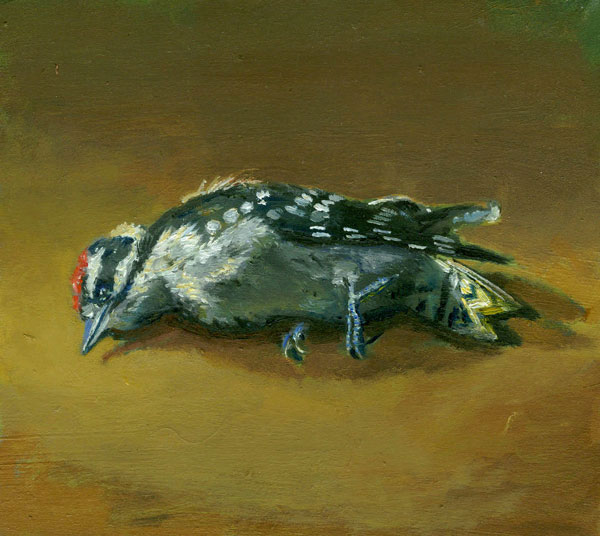
This downy woodpecker flew into our window and died. My daughter noticed it and we brought it into the house and both of us did a memorial picture of it. We are a family of bird lovers and we feed them. One of the hazards of feeding birds is that they are likely to fly into your windows, even if you have put up things to try to stop them like paper snowflakes or other objects on the window. Bird feeders also or attract Sharp-shinned Hawks and when they come there is nothing to do but stop feeding the birds till they go away. I have gone out too, whenever the hawk is around, and physically show him that I do not want him there. I have done several times, and the hawk leaves for a long period of time. I do not do anything mean, I just pay allot of attention to the hawk and follow it on foot. This makes him leave the area. This downy woodpecker flew into our window and died. My daughter noticed it and we brought it into the house and both of us did a memorial picture of it. We are a family of bird lovers and we feed them. One of the hazards of feeding birds is that they are likely to fly into your windows, even if you have put up things to try to stop them like paper snowflakes or other objects on the window. Bird feeders also or attract Sharp-shinned Hawks and when they come there is nothing to do but stop feeding the birds till they go away. I have gone out too, whenever the hawk is around, and physically show him that I do not want him there. I have done several times, and the hawk leaves for a long period of time. I do not do anything mean, I just pay allot of attention to the hawk and follow it on foot. This makes him leave the area.
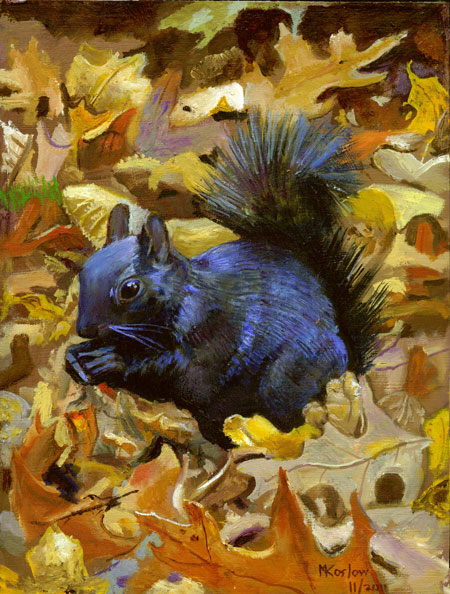
There was a Black Squirrel nuzzling in the
leaves when I was working onn Across the
Valley.. I only put animals that I
actually see into these paintings. But few
animals are willing to pose for an artist,
so this one was from a photograph. It is the
same Black Squirrel that is in the above
painting. Indeed, I used this painting as
the model for the squirrel in the landscape.
While I was doing this study I remember
thinking about levels of detail, -- how far
should I go to reproduce reality. The
largest leaf in front, closest to us,
looks like a real leaf. Some of the
leaves in the back of the painting look
utterly real too, you can feel their papery
stiffness, the pliable strength of their
stems. Reality is not merely what our eyes
can see, but also what is too small or large
or hidden to sight. It would be interesting
to paint with a microscope..
I recently saw Jupiter through
a ten inch telescope and it was no less
amazing than this Black Squirrel, indeed,
looking at living things or new planets you
have not see before, can have the same shock
of awareness of the rich varieties that
exist in reality..
Black Squirrels are actually Gray
Squirrels with allot of melanin. The city of
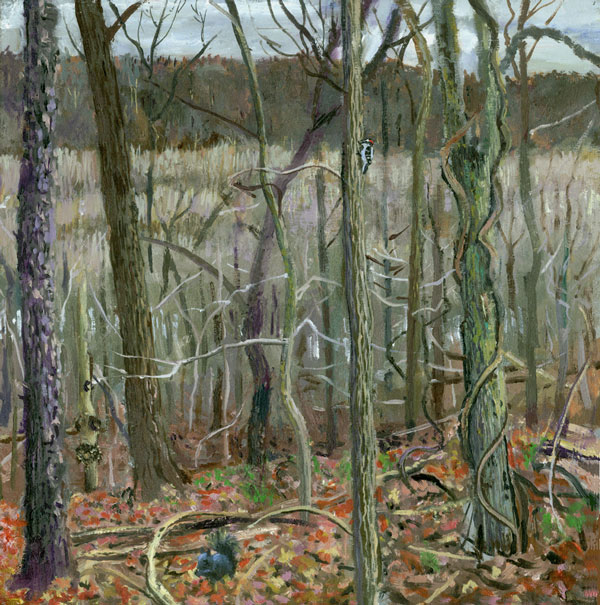
Across the Valley
f Now we are getting into November and
all the leaves are down. It is almost as if you
have entered a black, white or sepia photography
website, such is the color difference. The
carpet of orange leaves on the forest floor is
the last remnant left of the fall, excepting, of
course, the Black Squirrel who is collecting
nuts and making herself fat to get through the
winter. The November forest still has a certain
warmth in it that it will not leave till
January. f Now we are getting into November and
all the leaves are down. It is almost as if you
have entered a black, white or sepia photography
website, such is the color difference. The
carpet of orange leaves on the forest floor is
the last remnant left of the fall, excepting, of
course, the Black Squirrel who is collecting
nuts and making herself fat to get through the
winter. The November forest still has a certain
warmth in it that it will not leave till
January.
But the winter forest has a surprising variety in
color that might go unseen after the much louder
symphony of color that occurs in October. The
trees now show many variations of color in their
bark. On the left of the painting there is
a Black Cherry tree, whose bark is nearly
scalloped and has hints of a grayish purple. The
Sugar Maple has a twisted wild grape vine
around it and is greenish. Other tree trunks are
Umber or more towards Naples Yellow. Oil paint
is especially good at these colors that do not
have names, and are in between brown and blue or
purple and grey, ochre and umber.
Way down below at the bottom of the valley you
can see hints of the Cuyahoga river snaking its
crooked way toward the north. There are
different trees down in the valley than close by
up on the hill where I stood. In the Valley
there are allot more Willows, Sycamores,
Cottonwoods and Aspens and fewer Hardwoods, like
Cherry, Oak and Beech. On the far side of the
Valley is the eastern wall or slope of the
Valley carved out most recently by the
glaciers of the Ice Age.
What I especially like in this painting is
the feeling of space as you look form the
foreground trees to the background hills on the
far side of the valley. You can feel the depth
of the Valley carved by the river. The ridge
opposite hints at the orange fall that was and
suggests just how this Valley might have looked
500 or 5000 years ago. The bird in the young
tree that is closest to the viewer is a Downy
Woodpecker. This is a painting of one
below the Squirrel.
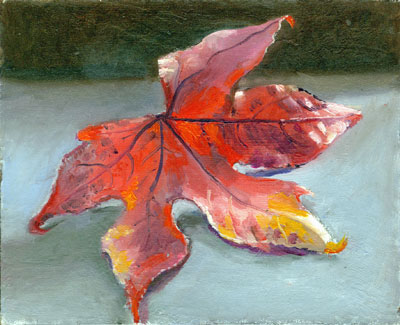
Sweetgum Leaf
This is a small study of a Sweetgum Leaf. The leaves on the tree change at different times so there is a progression of color across the tree as fall transpires. Some leaves are greenish, some yellow, some orange, or red and some even go as far as purple. Sweetgum is a rainbow tree and I love it for that.
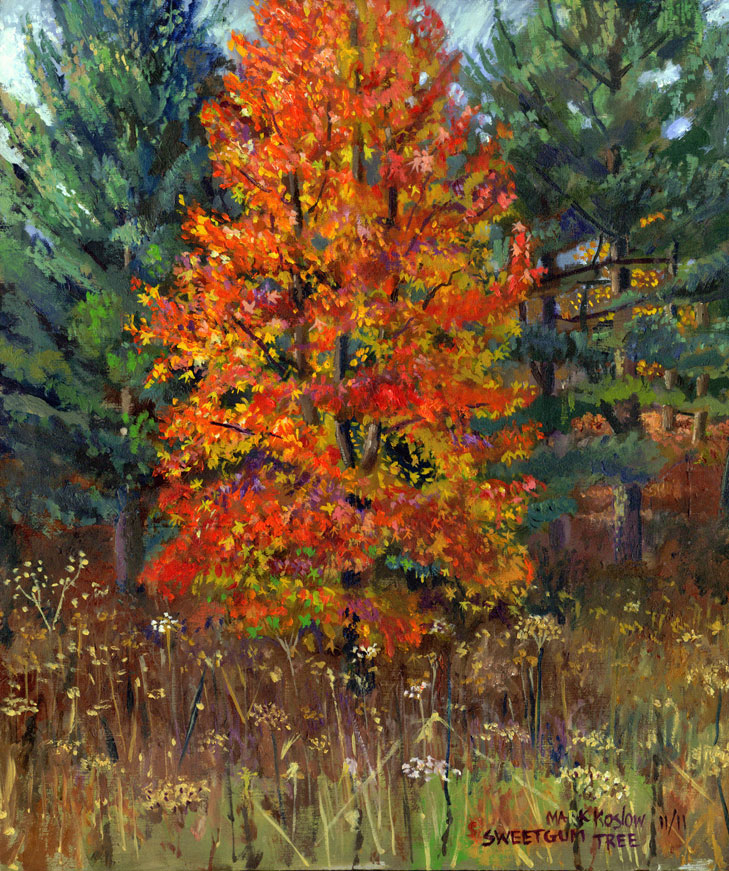
Sweetgum Tree
I drove by this this lovely
Sweetgum Tree nearly everyday for a
year because I took my daughter to a
school out that way. I admired it
for some years before that. I
finally tried to paint it after
knowing it for three years. Next to
it are some White Pines, one of my
favorite Eastern trees. They have
been called the Redwood of the East,
which is not inaccurate. There used
to be large forests of them, from
Michigan to Maine, and they can grow
to huge sizes, but they were much
coveted and loggers destroyed most
large stands of them 150 years ago.
Among many others things, they were
used for Clippership masts. As
usual, there was little conservation
effort and little regulation. The
rapacious lumber industry destroyed
its own product. Greed often
destroys the thing it loves best.
This is the second of my tree portraits
this year. It is also one of many
portraits of plants or wildflowers.
Some of the tall, dried out
wildflowers mixed in the front
grasses are Wingstem, which is very
common in our Valley. Some of the
other foreground plants are
the remains of Ironweed, one of my
favorite fall wildflowers. I have
seen Coyotes in this area, and hoped
I would see some during the says I
spent painting this, but if any
showed they were the only ones to
see me, I did not see them. I find
when I am painting these, however,
that I get so wrapped up in the tiny
decisions I must make to judge
colors and mix them and consider
values and intensities, that I
forget everything around me but how
to approach the "motif", as Monet
called it..
The tree itself was a challenge to paint and
Sweetgum leaves are so individual
and I would have had to be there for
months to paint every one. I only
had about a week before the leaves
would start falling off. So I went
as often as I could. I wanted it to
be a painting of the White Pines too
so I worked on them allot as well. I
wanted to show a sort of path that
deer and coyotes use going up in to
the woods and you can see that to
the middle right of the painting. I
like the light on the White Pine
boughs. I also like the the hint of
the trill that goes up into the
woods on the right.
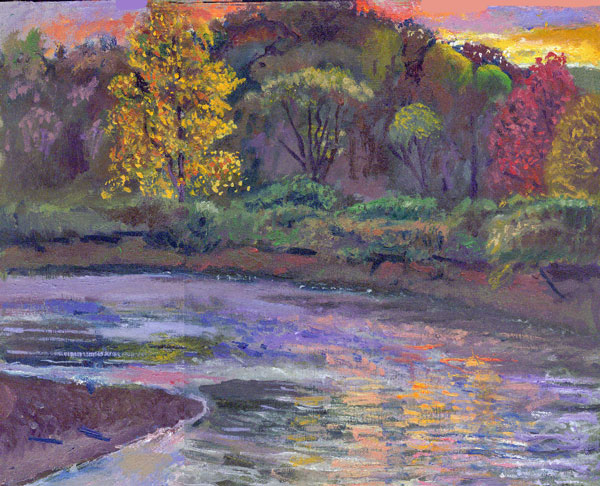
This is my
first river picture, one of thirteen
water pictures in the series of the
year. I was a swimmer when I was a
kid and love water. Moreover, we are
water and life exists because of it,
so I celebrate it every chance I
get. I am pretty sure that is an
Aspen on the river bank. Most of the
trees in the background are willows.
It was twilight. The brilliance of
the twilit sky and how it echoes the
colorful trees and influenced the
rippling river was the subject. The
Cuyahoga River bends at this point,
off Vaughn Road. In the center of
the river is a small island and so
the river splits in two. This is one
side of that split. I don'
think this painting is quite
finished, but it was October at the
height of the tree change and I was
very excited to get out and try my
hand at other motifs.
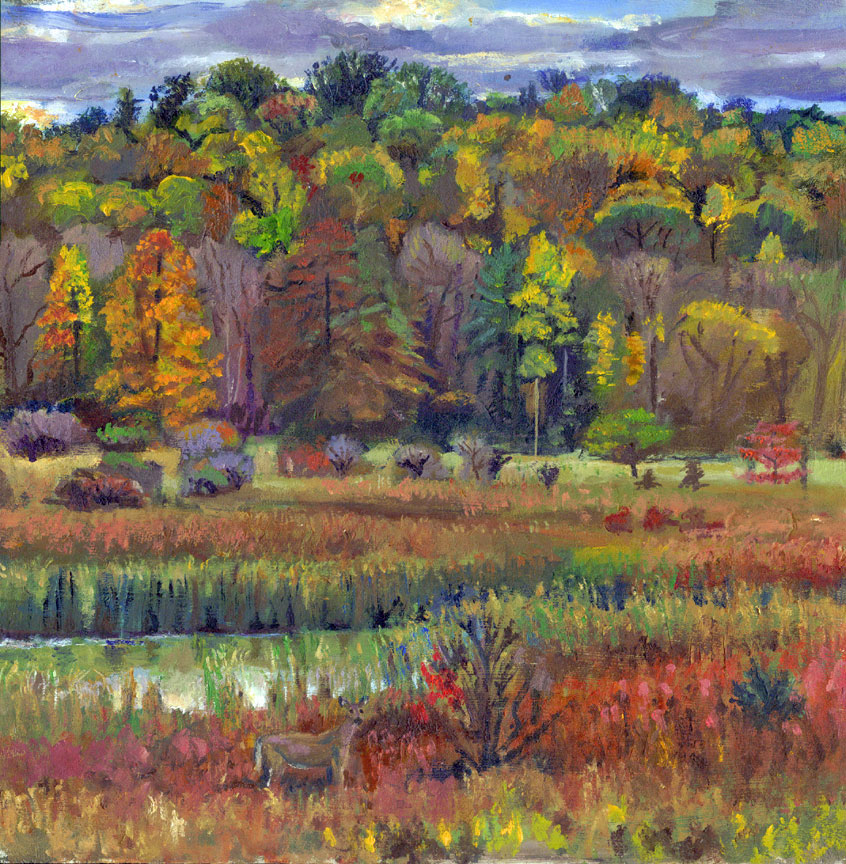
Cuyahoga
Floodplain and Hillside
This picture was done in a flood plain area not
far from our house in October, 2011. I did
this wet meadow three times in fall, winter
and summer. I really like the little pond
and cattails as well as the hillside.
Geologically the Cuyahoga valley is ancient
and was made by rivers perhaps 300 million
years ago, which is the date of the rocks at
Ritchie Ledges at the other end of the
National Park. The Ice Age started about two
million years ago. Glaciers bulldozed
northeastern Ohio over millions of years
before the Ice Age ended 10,000 or so years
ago. Evidently there are few rocks that date
from 65 million years ago, when the
dinosaurs died out, because of the glaciers
that carved out the Valley later took away
all this material. So in our Valley the
rocks are either very old, 300 million years
or older
( Berea Sandstone for instance) or very new,
since the last ice age. When we dig in out
backyard it is full of pebbles and stones,
all laid sown as the glacier retreated ten
thousand years ago. There used to be Saber
Tooth Tiger and Woolly Mammoths back then as
well as the large Woodland Buffalo.
So this is a Cuyahoga River flood
plain and it and the hillside opposite it
are probably relatively recent. The deer in
this painting was actually done from life.
She walked in front of me and stood there
for a few minutes and I was able to block
her in. I could do much better from a photo,
certainly, but it is so rare to be able to
paint a wild animal from life that I kept
her as she is. The deer gave the painting a
sense of scale and distance and I was
thankful for that.
I did some of this painting in the rain and complained about water
puddles forming on my palette, but since oil
paint and water don't mix I didn't mind that
much. I have an umbrella I can attach to my
paint box, but during a good soaking rain I
get wet anyway.
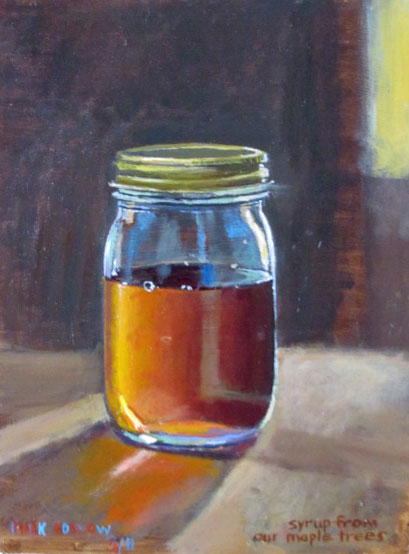
Syrup form our Maple Trees
As to the Amish themselves, there are degrees of Mennonite and Amish folks, some more fanatical than others as far as rejection of "English" technology goes. In Middlefield and in Holmes county one often sees the horse and buggy and the horse drawn plow. Women and children in 19th century dresses and bonnets often walk along the roads. There is a prevalence of animals and all this creates a certain sympathetic ambiance that is pleasing. Indeed, I like the different scale of Amish communities, there are buildings close to each other and everything is scaled down to human and horse bodies rather than cars. But there is a downside to Amish life that one sees too. Women are out hanging wet laundry in January, and there is evidence of animal abuse. We once talked with a 10 year old Amish girl taking care of her younger siblings and she complained of her parents making her get up at 5 in the morning to milk the cows and do other chores. It is a patriarchal society and has many negative features that adversely affect women, children and animals. The religious aspect of the Amish is disturbing and often employs cultish features such as shunning and ostracism.
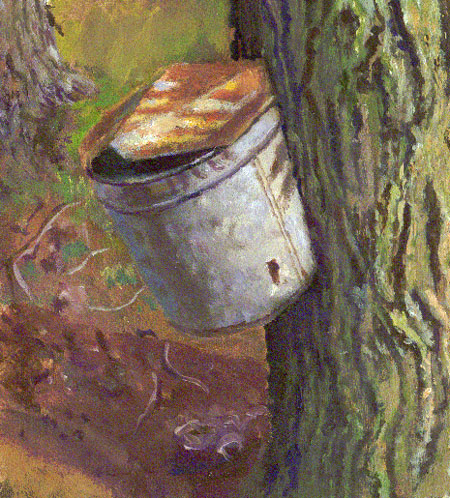
Maple Sugar Bucket
I also did a small painting of the syrup itself after we made it from many gallons of liquid from the tree. We live next to the park so it is not entirely outside the parameters of my project. Indeed, we traveled both locally and further field to see people collecting maple sugar. The Amish do it quite allot down in Burton, Middlefield and surrounding areas. One sees the steam and smoke coming up from the woods. The fire that boils down the maple liquid into syrup makes alot of steam. There is also a "Sugar Bush" down at Swine Creek State Park, and the maple syrup and "maple stirs' are delicious as well as the fiddle and dulcimer music. The kids enjoyed this process immensely and got to learn about history and other cultures at the same time.
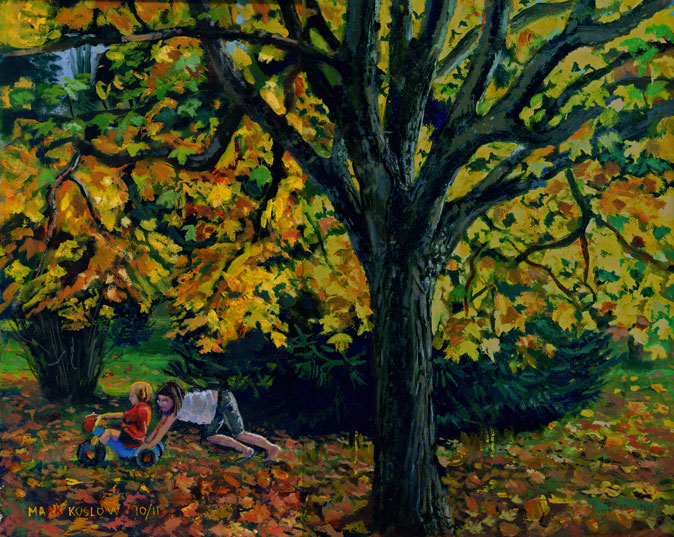
My Kids under the Red Maple
This is one of several portraits of trees in the series. Watching individual trees over many years time allows one to start to grasp the individuality of the tree. Part to the reason we bought our house had to do with the beauty of this tree as well as proximity to the National Park. Like us, trees are living things and have their stages of life and hardships they suffer. The tree is yellow to orange and it is a Red Maple. Watching individual tress over a years time allows one to start to grasp the individuality of the tree.
Originally this was going to be just a tree portrait. But the kids were playing around me so much as I stood in the driveway with my pochade box and painted, I decided to put them in too. My daughter was 7 here and my son is 2. He was unable to peddle the trike yet so she was pushing him around, laughing. This introduced a note of autobiography at the very beginning and violated the usual conventions of landscape art, which tend to make landscape into a sort of symbolist and spiritual theater. I am not terribly concerned with those conventions anyway, indeed, I have no interest in landscape as a metaphor for spiritual ideologies, The only conventions that interest me as far as landscape painting go come from realism and science , as these help me bring out things I wish to say. My relation to this landscape is deeply personal, not 'spiritual" and so next to a very real tree I place my very real children, with whom I spend most of my days, teaching and guiding.

We use this particular Red Maple tree to make male syrup too, and it has a delicious flavor, like the sugar maple. I did a few paintings around the subject of making maple sugar for the kids. Here is our maple bucket attached to the same maple tree in March. We got this bucket from an old man in maple sugar country out East of here, near Middlefield. We could have bought new ones, but the old style ones are very handsome. I like the rust on the top and the rusty spot of the side that is not yet a hole. The sap actually starts running in February. The sap starts running around the same time that Canada Geese start getting restless and begin mating now if the ponds thaw early. I was not trying to compete with Eastman Johnson's marvelouss "Sugaring Off",,which might be the best maple sugaring picture yet done.

I like Johnson's work very much. He is one of our best chroniclers of life in the 19th century. He is a great history painter, from paint the slave quarters at Mount Vernon to showing farmers and rural life and African American life around the time of the civil war. But I was just trying to record some simple observations about how maple sugaring has played a role in our lives with our kids. It is not the vast social thing it was over a hundred years ago. But it is a small social thing for us now now, and we enjoy its healthy pleasures in the late winter, and early spring. It ties us deeper to the land and the trees upon it.which might be the best maple sugaring picture yet done. I like Johnson's work very much. He is one of our best chroniclers of life in the 19th century, especially of African American life around the time of the civil war. But I was just trying to record some simple observations about how maple sugaring has played a role in our lives with our kids. It is not the vast social thing it was over a hundred years ago. But it is a small social thing for us now now, and we enjoy its healthy pleasures in the late winter, and early spring. It ties us deeper to the land and the trees upon it.
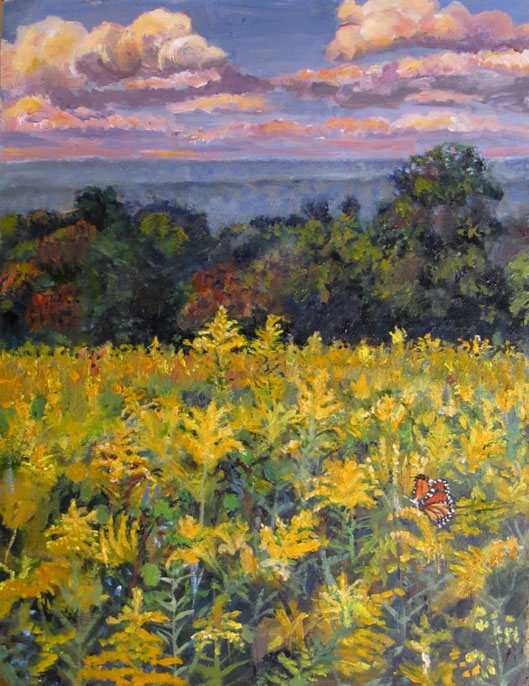
Goldenrod Above Cuyahoga
ValleyGoldenrod Above Cuyahoga
Valley, September 2011
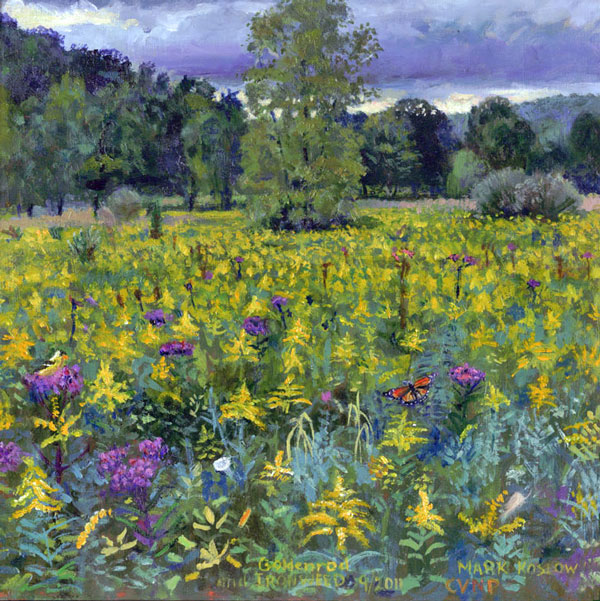
jGoldenrod and Ironweed, September 2011
My first two works in this series were two
studies of Golden Rod, a wildflower (solidago
canadensis), a flower in the aster family. In
September there are great masses of old yellow
in the fall fields. In "Golden Rod Above
Cuyahoga Valley", I was thinking of the immense
distances and the closeness of the flowers. I
knew I was going to do an entire series on the
Park, as this is partly why we moved here. So I
wanted to start with a sort of overview,
literally. It is the first in the series.
It had been some years since I painted outside
and i was feeling a bit rusty at first..
My spouse and kids dropped me off near this
field and I worked out in the middle of it, so I
was totally surrounded with golden yellow. I
took me for our five sessions, a few hours each
to get this far. One night, I think the last day
I was there, it started to rain pretty hard and
my phone did not work. So I was stranded there
for an hour in the rain, painting. I had a grey
umbrella but it did not prevent getting wet
anyway. There were many monarchs there
that day so I painted one of them. At one point
a deer appeared in the golden field and I tried
to put his head in, but later took it out..
This initial foray was a struggle. I did my
best to try to get the immensity of this field,
but I am not sure I succeeded. I think it one of
the weaker in the series. But it started the
ball rolling and outlined my basic procedure.
Throughout the series I tried to paint some of
the animals or insects I saw into the scene.
Most of the paintings have birds, animal or
botanical studies in them. I was not
trying to make beautiful pictures but to paint
the the places and life I love..
In "Goldenrod and Ironweed", I think I improved
greatly and was more confident. I am not sure
what the small white flower was but I suspected
it was one of the Hedge Bindweeds. There were a
number of different grasses there. There is a
Goldfinch in the painting that might take some
effort to find. The clouds were low and
threatening rain. The purple Ironweed reaches
its apogee in color in September and it was
gorgeous. I love to see Tiger Swallowtails on
it, but not this time. You can see by the
hillside far distant, on the right, that we are
down in the Valley. This painting has the
excitement of reality in it..
Painting is a form of inquiry, and
the inquiry is an effort to see into the reality
of things. By the 'reality" of things I mean
nothing metaphysical, I mean the actual
experiences of things and beings in real day to
day life as it is actually lived, not merely
thought about. It is exciting when reality
starts to come into a work. I start to be able
to feel the energy in the scene in my painting
and in my hands. Oil paint has a certain
visceral vitality in it that is able to imitate
the feelings of things, the texture and virtual
appearances of reality. Oil paint's viscous
versatility in this respect makes it an
amazingly sensitive vehicle to adapt thought and
develop accuracy of perceptions..
The hand and the mind translate reality
into paint and the process by which this happens
is not magical. Magical is not the right
word,--- wondrous and sympathetic are much
better words to describe the process of reaching
out of the mind into the world. One must be
careful of analogies. Art for me is close to
science and not at all Platonic. There are no
essences that need to be 'evoked", there is only
the reality of things and a process of
assimilation and efforts to grasp, see and
understand what is actually there. There is more
to it than merely Aristotle's 'imitation' or
mimesis, though mimesis is the beginning of
education, as Aristotle taught. It is not
nothing to try to grasp the physical and what
actually happens in the world, indeed, it is
extremely difficult and the only thing that
really matters. The world can improve by such
exacting efforts, it does not improve by
Platonic essences, religions, superstitions and
magical thinking.
Introduction
What follows is the story of a few years
in paint, part catalogue of places,
trees, waters, and people, part year in
review, part autobiography. These are a
series of 40 or so mostly Plein Air
paintings done in, or close to, Cuyahoga
Valley National Park (CVNP). The park is
large, about 20,339 acres or
31.78 sq miles. The Cuyahoga Valley was
already known for its beauty in the
1800's when people came from nearby
cities for carriage rides or boat trips
along the Ohio and Erie canal. In any
case, the history of the park is really
about the effort to preserve the obvious
beauty of the place. This beauty has to
do with features that predate private
property and human use. To a large
degree the ancient beauty of the place
has been preserved.
In 1880
Valley Railroad became another way to find recreation in
the Valley. Actual park development
began in the 1910s and 1920s with the
establishment of Cleveland and Akron
metropolitan park districts became another way to find recreation in
the Valley. Actual park development
began in the 1910s and 1920s with the
establishment of Cleveland and Akron
metropolitan park districts.
The National Park overlaps parts of the
semi-wild areas of the Metroparks of
Cleveland. I think of CVNP and the
Cleveland Metroparks together as one of
the best natural areas of any city in
the country. These parks stretch Between
Cleveland and Akron. Many people
made these parks possible in years past.
The Metroparks system, for instance, was
largely created by an amazing man,
William Stinchcomb, in the 1930's. He
created the Metroparks during a
progressive era when such things were
still possible and the fox was less in
charge of the hen house. The
successor "Boards" who have run the
parks since then have had alliances to
corporations and have sometimes been
guilty of corruptions. The
Metroparks Board has been prevented from
turning it into a giant golf course or
selling it to MacDonald's because it has
an excellent mission statement and the
public has opposed such corruptions. But
a number of the governors of the
Metroparks have been found guilty of
corruptions and crimes. The
National Park is less threatening to the
land, at least so far, if only because
congressional corruption is further
afield and has so for not be able to
sink the wildly popular National Parks..
It is true there has been no lack of trying to
open up the parks to oil companies and
others. Private enterprise hates the
whole idea of public ownership of
anything. Business sees nature as
an exploitable "resource". One need only
look at how nature is treated outside
the park system to see that Business
does harm to the natural world virtually
everywhere, 'externalizing' risks onto
animals and trees, seas and rivers,
soaking up profits for the rich and
putting hardships and taxes on the poor
and middle class. There have been
efforts to defund the parks. Hopefully
the relatively new CVNP will not become
as corrupt as the Cleveland Metroparks
became. But the parks still stand and
hopefully will be enlarged and
protected. More parks should be created..
In short, there is is a large
area of semi-wild public land
where I live and it is a great and
wondrous thing. So here I wish to
celebrate it. This essay or little book
is partly done in praise of public
lands. I am making an art about local
plants and animals and people that are
close to me, an intimate art of earth,
science, scholarship and story
telling..
As I painted more and more of
these paintings, they began to echo each
other until what you see now is a
complex tapestry of people, plants,
weathers, birds and animals in
space, tied together by a mentality and
a steady method of inquiry and
observation. These are objective works,
done by hand with brushes and oil
paints. I stand with my paint box, which
I carry on my shoulder into the woods or
beside a pond, and place on a
tripod. These paintings are done
conscientiously and accurately. And they
are done partly in rebellion against the
orgy of arbitrary, human-centered
subjectivism that has ruled art for the
last 100 years. The "avant guarde" was
useful at the beginning, but i the end
became an orthodoxy far more insidious
than what is originally sought to
replace. Now hatred of beauty is a
standardized dogma My my own
aesthetic notions and interests are not
with the current art world but gravitate
toward some of old masters: thee
Dutch
Realists, Peiter
De Hooch
andd
Rembrandtt,
Da Vinci
and thee
French Realistss.
Among American Artists I likee
Willard Metcalff
and a few, not all, of the
works off
Wyethh.
I also like some regionalists, two in
particular who are both eccentric nature
painters,
Burchfield
anddUttech.. But in the case
of both these painters it is their love
of nature that I like, though I do not
like the "spirituality" of either of
them. There are a few Plain Air
paintings I like such as these::
heree,
hereeandand
heree.
I like Van Gogh's devotion to nature and
social issues and Degas' ability to
draw, as well as Monet's use of color
and effort to perceive the "envelope "
in nature as he called it. I
particularly like Monet's Haystack
series for what it reveals about the use
of color and space.
My art is not merely optical. Cezanne
said of Monet that Monet is "just an
eye, but what an eye?" I am not
sure he is right that Monet was that
superficial. Indeed, Monet excels where
Cezanne fails and that is because Monet
had real insights about color and
perception, landscape and the feeling of
light in space he called the "envelope".
My opinion of Cezanne is not very
high. He really could not draw. He
started out doing very violent scenes.
Later he seemed to reduce the violence
in him to a very cramped proto-cubism
which I do not admire. His late Bathers
have always seemed to me pathetic, the
emperor with no clothes. Above all I
like Da Vinci's intelligence, scope and
use of art as an extension of inquiry.
So my understanding of art is really
that art is an extension of science and
thought and not a form of visual
entertainment for the rich or propaganda
for the powerful. These paintings seek
to go beyond all the nonsense about
modern and post-modern and to plant art
firmly in the place where Da Vinci
wanted it to be. My art is not merely optical. Cezanne
said of Monet that Monet is "just an
eye, but what an eye?" I am not
sure he is right that Monet was that
superficial. Indeed, Monet excels where
Cezanne fails and that is because Monet
had real insights about color and
perception, landscape and the feeling of
light in space he called the "envelope".
My opinion of Cezanne is not very
high. He really could not draw. He
started out doing very violent scenes.
Later he seemed to reduce the violence
in him to a very cramped proto-cubism
which I do not admire. His late Bathers
have always seemed to me pathetic, the
emperor with no clothes. Above all I
like Da Vinci's intelligence, scope and
use of art as an extension of inquiry.
So my understanding of art is really
that art is an extension of science and
thought and not a form of visual
entertainment for the rich or propaganda
for the powerful. These paintings seek
to go beyond all the nonsense about
modern and post-modern and to plant art
firmly in the place where Da Vinci
wanted it to be.
So it might be of value here to define
were I stand on the subject of what is
and is not art. But as this is a
somewhat theoretical discussion I will
append it below. Therefore I have
added six paragraphs of comments about
art and aesthetics at the bottom of this
page. It is under the heading
Some Observations of Art .*******
OK. Let's look at the actual paintings. On
average, I have done a few paintings per
month, not very many by contemporary
standards. And it was not easy work, but
took a great deal of concentration and
purpose. I was also caring for children
most days and working a job as a
painting and drawing instructor during
this time. During spare hours with my
wife's and kid's help I was able to get
out and do these. They are in some of
them and so am I. I mean there to be a
loose chronicle of our lives in nature.
It is interesting that Cuyahoga
National Park follows the Towpath
Trail alongside the historic route of
the Ohio & Erie Canal. I have yet to
paint the locks or other remains of the
canal. I also haven't done the main
water falls as yet, Brandywine and Blue
Hen, opting for the less well known
ones. I probably will paint these
eventually, but for now, other things
have called me. The winding Cuyahoga
River, (Cuyahoga means "crooked river")
gives way to deep forests, rolling
hills, and open farmlands. But I have
mostly been drawn to natural features,
botanical treasures, as well as
geographical features of portraits of
water and streams, tree portraits,
beaver dams, lodges and wildflowers, as
well as the remains of history in the
park, the old hoes, barns and hints of
lost days. The old covered bridge, and
the old train that goes through the
valley or one of the the old
stations where it stops, these4 too have
held me rapt for days at a time while I
paint them .
I try to show the park partly though the
eyes of my kids but also through
adults eyes, reflecting and thinking
about real things in a real way.
***
****************Some Observations on Art
It will take me about seven small paragraphs to explain how I feel about art and the "art world". So the next seven paragraphs put forward what amounts to an aesthetic---a theory of art,--- I put some asterisks *** six paragraphs down if you wish to get right to the stories about the paintings and come back to this later.
I think it is important to explain the
intellectual context of these works. These
painting are an outgrowth of two earlier
series of paintings I did. I did four years
of work on my Point Reyes Paintings, (not up
at this point) and perhaps three or 4 years
on a series on Heroes Wetland, which I call
Nature's Rights.The current series goes further into the
specifics of the local. This need to ground
myself in a local landscape and to make
nature a central focus goes back to the
1980's, or perhaps earlier. There are few
people in the contemporary scene that I
identify with I like aspects of the
contemporary Realism, the Atelier and Plein
Air movements, but some of it tends it tends
to be retrograde and to ally itself with
reactionary forces. Art is not
mythological escape. When art become myth it
tends to support the status quo. The vapid
angels of Borguereau or the erotic histories
of Gerome will not save us, though at least
they both could draw well and both made some
beautiful things. Art that aspires to be
religion does not interest me either, as is
the case with much modern art( Reinhardt,
Kandinsky) or such romantics as Inness, even
though I like some of his work. But I am
interested in art as a branch of a
progressive science, not corporate science
but the science of nature. Art comes
from nature and is Darwinian, which means
that it is basically about survival, not
just as a species but a member of the biotic
planet, where all living things exist and
deserve to thrive. For art to be useful in
our time it cannot be Dada, or stupid, nor
can it merely explore itself, in imitation
of the corporation and its psychopathic
narcissism..
The dissolution of reality after
Impressionism did no one any good. The
notion that we "construct" the world out of
our mental states is a lie about our world
and ourselves in it. The world exists and is
not a human construction. The profound
alienation from the natural world implied by
the idea of "post-modernism" (pomo) and its
rampant subjectivism is very disturbing.
In fact, the whole idea of 'post-modernism'
is an abuse of language. It is a fiction
created by a corrupt, corporate art world.
The world that is now is our world and it is
not "post" anything..
The downfall of the 19th century
aristocratic elites and then the
fragmentation of art after Impressionism
resulted in art being exploited by the
corporate elites. That is what the
subjectivism of Duchamp and Warhol is really
about. They are pseudo-democratic
elitists, really reverse elitists, who extol
the presumed virtues of regressive
subjectivism and mindless automatism and
market buffoonery. They wanted to destroy
art and turned it into silly jokes and cheap
advertising and celebrity iconography. What
the New York/Paris/Tokyo art world created
after World War 2 is what I call Corporate
art. Corporate art is the emptiness
that visits the pages off Art in Americaamagazine. Indeed, as an experiment I take a
look in this sad magazine once or twice a
year and can find nothing in it worth
looking at. One finds in this magazine
utterly vacuous abstractions and
'installations' dictated by the dogma of a
corporate market. To consider Corporate Art
to be 'art' is a mistake. What goes by the
name of art these days is mostly an
extension of fashion and speculative capital
exchange and has little to do with actual
art making and knowledge and lots to do with
advertising and promotion. Although it
poses as 'democratic", it is really
anti-people, anti nature, minimalist,
formalist, systems and process oriented
rather than content driven. It is
anti-aesthetic and opposes the beautiful,
and basically is not about art at all but
about commerce, as well dictating what art
will be by galleries and art commissars (so
called 'critics')..
Henri Matisse speaks
approvingly of of having heard Toulouse
Lautrec say that "at last I don't know how
to draw". ( Quoted in Deanna Petherbridge'ss
The Primacy of Drawingg pg. 415 )
Picasso says that when he was young he
"could draw like Raphael, but I have spent
all these years learning to draw like
[children]". First of all, though
Picasso did some pretty good drawings in his
career, however inconsistently, no
drawing by Picasso comes close to Raphael.
Indeed, while Picasso did a few fine things,
many of his works are very hard to take
seriously, and are superficial and frankly,
childish and silly for an adult. Second,
neither Matisse, Lautrec or Picasso knew
much about children, much less about why or
what children draw. Art for children
is not blissful stupidity, but an attempt to
understand reality. As they learn more their
drawings become more and more sophisticated
and concerned with reality and problem
solving. I spend my days with a couple of
young drawers and their attempt to grasp
reality can be very concentrated and
intense. The idealization of childhood is a
misunderstanding akin to the ideology of the
"noble savage". pg. 415 )
Picasso says that when he was young he
"could draw like Raphael, but I have spent
all these years learning to draw like
[children]". First of all, though
Picasso did some pretty good drawings in his
career, however inconsistently, no
drawing by Picasso comes close to Raphael.
Indeed, while Picasso did a few fine things,
many of his works are very hard to take
seriously, and are superficial and frankly,
childish and silly for an adult. Second,
neither Matisse, Lautrec or Picasso knew
much about children, much less about why or
what children draw. Art for children
is not blissful stupidity, but an attempt to
understand reality. As they learn more their
drawings become more and more sophisticated
and concerned with reality and problem
solving. I spend my days with a couple of
young drawers and their attempt to grasp
reality can be very concentrated and
intense. The idealization of childhood is a
misunderstanding akin to the ideology of the
"noble savage".
Drawing is generally not a descent into
madness and the idiotic. The search for
authentic "outsider art" is itself an
admission of the inauthentic insider
emptiness of of the art world. Addicted to
"irony", the true irony is that the art
world as it now exists has very little to do
with art. It is really a fashion business
run by gallery owners and effete, servile
critics dogmatized by their own
pronouncements. It is a scam for the ultra
rich to get them to part with some of their
not-at-all-hard-earned money. Petherbridge
concludes her great book on Drawing(2010,
pages 413--414) by stating that recent art
has rejected intelligence and
"differentiated skill based systems of
drawing" in favor of expressive
irrationalism, "atavism" and "primitivism".
The dumbing down of art for corporate
culture has required art to become as stupid
and vacuous as possible, empty of content.
Recent art "enshrines Robocop rather than
Rembrandt as the graphic model for young
artists". Most recent art has tried to
destroy "skill and technical considerations"
and has a 'fear of literalism" or realism,
as well as a notion of drawing as an
"interrogative practice" or art as a method
of study. Study or inquiry,
intelligence, beauty and the seeking of
meaning in the reality of things is the
criteria or art. Recent art abandons
the very things I consider to be art and it
promotes meaningless geometries or ugly
scratches are are the ideal corporate art.
Art in the galleries of New York and the
university art schools in our
time endeavors to be anti-intellectual and
vacuous, and erect art proud of meaning
nothing, inquiring into nothing, telling no
story. Such art is perfect for corporate
lobbies as it signifies nothing yet takes up
space and entertains without any thoughts to
think.
Petherbridge offers some hope in wishing
art a return to "intelligence of practice".
Rejecting the inanities of Duchamp and much
of the art world, she hopes for an art that
once again seeks into the meaning of things,
"investigating the world". (page 432)Drawing
and painting are above all an attempt to
understand our world and our place in it,
and as such they are basically one with he
scientific project. Art can only
progress forwards into beauty and science,
rejecting corporatism and the ready-made
inanities of "installations" and corporate
art..
The anti-intellectualism among modern
artists is an attempt to make a virtue of
being dumb, and takes pride in emptiness,
nonsense and the inability to draw or paint.
It is this virtue of stupidly that has made
art such a willing accomplice in the
corporate con-game. Post-modern art is
closer to religion than reality. Such art is
not really art at all but a by product of
fashion, fetish and commodity capitalism.
Art, from its inception, has had the
unfortunate vice of sucking up to power, and
this is readily obvious in Hindu sculpture,
Catholic Virgins, Islamic tile work or
Chinese scrolls of emperors in flowing
robes. Now art serves the corporate vacuum
of the Board or the CEO and the virtue of
wealthy emptiness that is at the heart of
the phony mystique of "corporate
personhood". Corporate art is as empty as
the art that served the Pharaohs. If art is
not to be merely a by-product of power
systems it must look to science and reality
as deeply as it can, be to be as independent
of the need of money as is possible, without
starving to death. The art martyr thing is
also no longer necessary. What is
necessary is to stay alive and look at the
corruption with a dispassionate eye, and
seek to do all the good one can for people
of the future. Our best revenge against
modern/post modern art is to seek truth and
beauty, nature, life and reality, even if
this beauty if found in the mundane of the
ugly, or what Neruda called the "impure"..
The aesthetic that dictates much of what happens
in the current art world is unsustainable.
Much of what goes by the name of art is as
distorted and destructive as the insanity in
the banking sector that caused the recent
global recession. The art of our time is
fictional, 'derivative' and vacuous because
it reflects corporate and government
fictions, such as the fiction of 'corporate
persons', which leave real persons without
health care or housing. So if art is to not
serve such powers, it must be clear about
what it will serve and why. For art to be
progressive it must be attached to science
and to free inquiry. It must dedicate its
fruit to all people and nature. It should be
accessible, not esoteric and it should
embrace feeling without being superstitious
or exploitive or sentimental. I have
known artists who have no idea what they are
making or why and think this empty vacuum is
a virtue. It is not a virtue to be ignorant
or to draw badly. So part of the
reason for this series of paintings is to
continue to try to define art as a branch of
study and knowledge that serves
understanding, education and science and not
as a formula that serves a conceit with
materials or an empty system of
"signifiers". My concern is with
exploring the truth about the world I live
in..
******
